Ray's Ramblings - Volume 4
Ray Kessler is a lifelong Mt. Vernon resident who has played a lot of ball, written about others playing a lot of ball and loves to wax eloquently about Mt. Vernon. We are fortunate to have access to many of his short stories and observations to show here.
We have organized the articles by the period of time Ray is referencing. This volume started in April, 2012.
Come back often, because Ray just keeps finding items to add. This is Volume 4.
2010's
July 22, 2012 near Dead Mans Crossing, IN
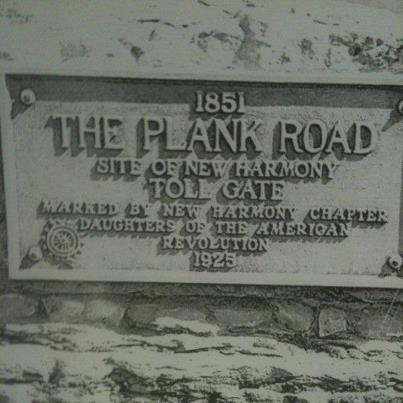
There is another one on Highway 69 on the west side of the road in the Lawrence addition.
Mt. Vernon Armory on its last legs.....2012
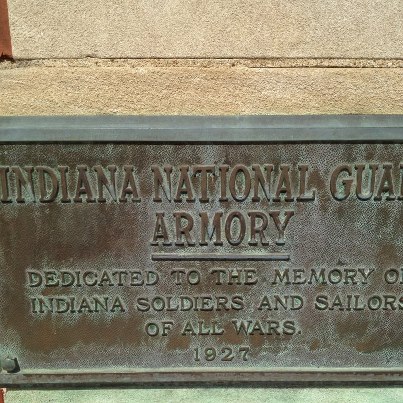
The empty armory will soon be razed and replaced by apartments on Main Street as part of riverfront revitalization. Back in September of 1923 the new armory was dedicated and it was a big event with a parade, mounted review, barbecue, and a dance. It was built for Battery E of the 139th Field Artillery, Indiana National Guard. Schools and business closed that afternoon for the opening and a proclamation was read by Mayor Osborn. Adjutant-General Harry Smith arrived in Evansville for the event and was picked up by Merle Weisinger, captain of the reserve corps. Smith had been in the military since 1877 starting as a private. The armory was the host then of 85 local men and officers. Captain Philip Rowe was the head of the local organization and the building was built on the site of the stables of Phillip Hagermann. The building was constructed of hard red brick, Indiana limestone, steel and concrete. The measurement was 70X140 feet and the cost of the building was $21,000. The floor was hard pine laid over concrete. Local contractors did the work. Besides Captain Rowe, the other presiding officers were Ist Lieut. Gilbert Behrick and 1st Lieut. Ira Rothrock. At that time Battery E had 31 artillery horses, 4 75 mm guns, 6 caissons, 2 battery store wagons, 3 combat wagons, one water cart, one reel cart, one ration cart,, field kitchen equipment, harness for maximum horse strength, clothing and personal equipment for 120 men, cots, revolvers, and blankets, tents, ammunition, blacksmith and saddler kits and 7 carloads of artillery equipment. Many local firms were used in its construction. Alles Brothers furniture provided the oak furniture for the upstairs offices, Gronemeir Hardware furnished the trim hardware, the sheet metal work, plumbing and roofing was done by Lynn Strack. The building was also used as a basketball court for the boys and girls teams from 1924-1927. It was only natural that when the guard moved on and combined with Evansville the site became the Park and Recreation building. The building served the community well and will be remembered.
New Harmony Bridge 1930-2012....do you think we will see it dynamited and a new one built or will we return to a ferry?
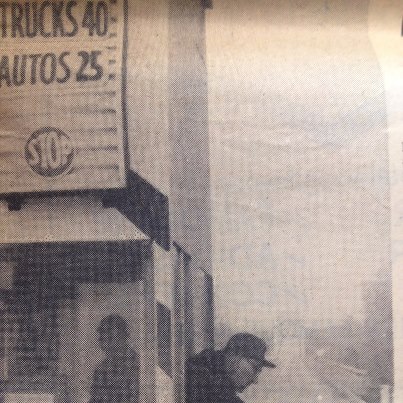
Posey County Historical Society President Becky Higgins and Mayor John Tucker at Sherburne Park 100th Anniversary and Ice Cream Social.....2012
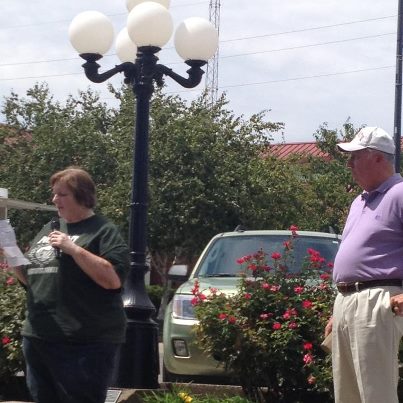
Nice tribute to Sherburne Park delivered by the Mayor and Councilman Becky Higgins. The park is named after Sherburne Cronbach who died in 1903 of typhoid fever. Becky gave a nice history of the park and Mayor John Tucker talked some of the projects of the new riverfront revitalizations. I spoke with both afterwards and found out that the new riverfront project will be completed in November. The Armory will be razed in December and it is possible the new condos and apartments will be started this fall. There are discussions ongoing on a name for the new riverfront area and maybe in the future there could be an observation deck on the river. Great fun hob-knobbing with politicians....even talked to a Republican! We don't know each other that well, but I am willing to listen if she is. LOL. The event sponsors were the Posey County Historical Society, the Mt. Vernon Park and Recreation, McKim's IGA and Prairie Farms who donated 500 ice cream cups. The Dixielanders Jazz Band played in the Pagoda and did a fine job. Upward and onward!
2000's
One of several aerial photos sent to me by Keith and Jennifer Murphy of Point Township Mackey Bend area, October 2009.

I'm told that this photo is looking back from the south at both of the cutouts at that time.
The beautiful St. John's Episcopal Church.....2005
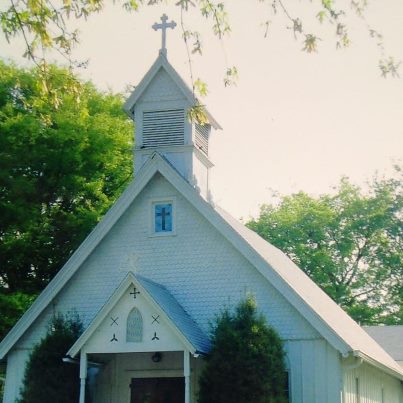
Sixth and Mulberry erected in 1892.
Mississippi Queen stopped in Mt. Vernon to drop off passengers for bus tour of New Harmony.....November 2001
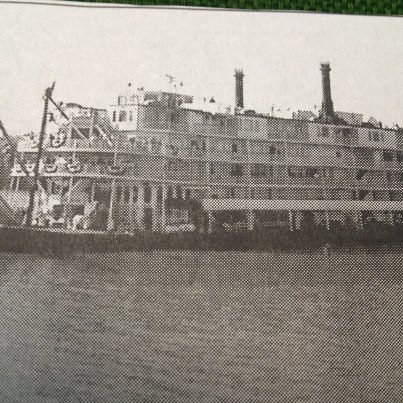
1990's
Local Radio Station Changes Call Letters.....1999
WBLZ 106.7 has changed its call letters to WYFX and at the same time 1590 AM switched from WPCO to WRCY. WPCO first came on the air in 1955 and 106.7 began programming in 1992. It is now ESPN sports radio. Beats the hell out of that country crap doesn't it? LOL.
Kauffman Winery.....1999
Back then it wasn't unusual for me to bring home a bottle of "Posey Red" from a local grocery. Wasn't into wine much yet...oh, I had my share of Boone's Farm 'back in the day,' but I hadn't yet cultivated a taste for it. Now a days, since catching the all-inclusive bug for Caribbean culture I am all over red wines.....The Kauffman winery , just off Ford Road on Indiana 62 started from grapes first planted in 1974 and grew to make over 10,000 bottles a year. Harry Kauffman had a interest in the St. Wendel, Golden Raintree Winery and then when it closed in the 1980's he brought over the mainstay of that winery the "Spirit of '76" to his. Harry has since passed on and I don't hear much of the seven acre vineyard. A rumor existed a year or so ago that it was closing down. Really, I don't know if it did or not, but made a run and bought a dozen bottles or so just in case. I like more Argentinian semi-drys now, but a sweeter trip down memory lane still goes good with a bowl of spaghetti and garlic bread.
Delta Queen in MV 1999
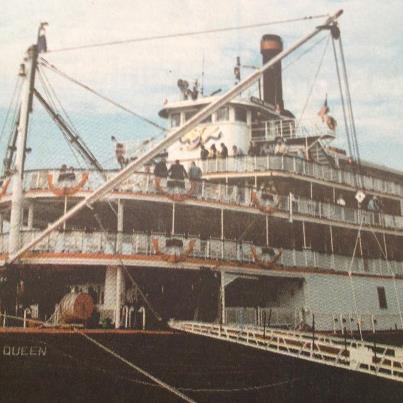
Olympic Gold Medalist Speaks to Mt. Vernon Wrestlers....1997
During a wrestling clinic in the summer of 1997 in Mt. Vernon, the gold medalist of the 160.5 pound weight class at the 1960 Rome Olympics spoke to the youngsters. Doug Blubaugh was that man, a two-time national champion for Oklahoma State University. He joined the Army afterwards determined to train for the Olympics with no money to do so. The military gave him that opportunity and a paycheck. With his reputation preceding him he was sent to West Point to train Cadets. He coached at Indiana University for 13 years. He spoke of drugs and their harm and mentioned he kicked several Big Ten and state champion wrestlers off his team for using.
MV Native, Federal Judge Dies.....1995
"A career on the bench," it was; no not my baseball record but that of William Elwood Steckler, United States Federal Judge for over forty years. Back in the 1920's, William was a handsome young man in the plays of Mt. Vernon High School's Footlight Performers on Canal Street. Teacher Catharine Howard remembered him as "black curly hair, beautiful speaking voice, shy, good actor, superb, one of my prizes, special." Born in 1913, Steckler went on to be a prominent Indianapolis attorney, and then the youngest federal judge in the country. Appointed by President Harry Truman in 1950 for the then 60 southern counties of Indiana, he was confirmed by the Senate and he became the first Democrat to represent that district in 108 years! He was a man of great integrity and very well respected by all. "I always admired some of the lawyers in Mt. Vernon, " Steckler said in a 1982 phone call to a reporter. "Paul Pfister, Jesse Wade, Judge Hertis Clements. There were three professions I always looked up to...ministers, doctors, and lawyers." Steckler graduated from Mt. Vernon High and the depression hit. His father's sawmill and farm machinery business was hurting and William couldn't go to college right away. He worked a year saving his money from employment at the local overall factory. He went to Indiana University and worked nights mopping floors at the Methodist Hospital. He graduated second in his class and even moved up to assistant credit manager at the hospital. "I gained an insight into the needs of housing, handicaps, and hospital reforms." He was into private practice after graduation from 1937-1950 and Democratic politics as well. When he became a federal judge there was an explosion of civil rights and anti-trust cases which had been back on the burner during the war years. He had some of the heaviest workloads in the nation. His first year on the bench he did 554 civil and 268 criminal cases. He was the first judge to use the pretrial conference as a required practice in a District Court, the first trial judge in Indiana to routinely submit written instructions to the jury, and he originated the idea of a check list of procedures for protracted cases. He had several nationally significant cases including an early civil rights case involving open housing in Evansville. Representing the NAACP in that 1953 case was the future Supreme Court justice, Thurgood Marshall and Constance Baker Motley, later chief justice of the U.S. Court for the Southern District of New York. He rendered decisions involving reapportionment that affected the makeup of all branches of Indiana government. He was known for broadening voting rights to more citizens. He turned down three chances to move up to the United States Court of Appeals for the Seventh Circuit in Chicago, but preferred the trial bench and didn't want to give up many of the things he loved to live in Chicago. He remained on senior status as a judge from 1986 until his death long respected for his distinguished tenure on the bench.
Linen Cupboard.....The 1990's
Always a Merry Christmas around our house for my wife as I did most of my shopping here in Mt. Vernon. Terri was born on the 27th of December and she loved Christmas. I always found some beautiful unique item here for her collection of Christmas items. The Cupboard was located at 1001 East Fourth Street and owned by Mary Ann (Collins) Burris. There were theme rooms throughout, including a year round Christmas house. They had a baby section, Just for Men, Gifts for all occasions, a Bridal Registry, Kitchen Stuff, and a Gourmet Food Section. There were old fashioned hand-blown and painted ornaments, Boyd's Bears, Beanie Babies, Snow Village, Byers Carolers, snowmen, Yankee Candles, Pillow Pals, nativity set, etc. It went on and on. Our hutch is full of these items. Little items too like Angel pins, snoopy stuff, Loving Heart rattles, and Sesame Street items. Also you could find linens, towels, bathroom items, watches, money clips, bracelets, soaps, lampshades, glassware, silver, pewter, wreaths, dinnerware....just everything! Boy, we could sure use one of these for the new downtown today. Her merchandise was outstanding!
1980's
Gertie Reeves Touched Many A Life.....1988
It seems Gertie lived a special life, several lives, making do, serving God and helping me. Before I get to that, let's start back when Gertie was born, the oldest of eight children, weighing only a mere 3 1/2 pounds to a 13 year old mother. Gertie never finished high school, but she helped keep that family together through difficult times. She met Edward Stevens at a church dinner and was married in 1937 when she lived in Boonville. They attended the General Baptist Church in that community. Ed felt a call to the ministry and he moved his family to Oakland City where the Baptists have a college. Tagging along two children, Ed spent the next three years studying theology. Gertie started feeling a call for mission work and after World War 11, the church was looking for a missionary to serve in Guam. The Stevens family were shipped where they pastored a church on the island for seven months. They were then transferred to Saipan and established a mission there for two years. In September of 1949, they returned to the states and Edward was off to complete his degree. In 1950 her oldest son was killed by a train while riding his bicycle after school. Rather than return immediately to mission work, they needed time to heal and accepted a job in Mt. Vernon to pastor the General Baptist here. One year later they were back to Chi Chi Jima. Unfortunately, Stevens became ill on the way and died in a Naval Hospital in Guam. Gertie and son David were left to make do all alone. When the returned for funeral services in Boonville, David said he would like to live in Mt. Vernon as he remembered the children there as they sent pictures from time to time. So they came back again and for a while the family moved in with the Harry Russell family and Gertie took a job at the Neu Way Cleaners and moved into a small apartment. In 1953 she married Bueford Reeves and they had a farm in Savah and owned the Sunshine Feed and Seed Store. Gertie helped out in the office. In 1963 the store was sold and Bueford took a job at the new General Electric Company west of town. Gertie went back to work at the cleaners. Here is where she helped me. In February of 1965, a large snow storm hit Mt. Vernon and all power was lost. We lived on Emmick Street at the time and I was up that morning while the family slept in trying to stay warm. I heard my beagle pup Rusty barking in the garage and as I went to the door I heard popping and crackling noises. Looking at the basement door that led into the garage, I saw fire coming through the top of the door frame. I awoke the family and ran into the snow drifts trying to get someone to call the fire department. Why I didn't use the phone in my own house I don't know...maybe shock. After going through snow drifts to maybe six homes with no coat and only sneakers on my feet I reached the Reeves home on the Corner of Elk street. Gertie let me in and took me to a bedroom and warmed my hands and feet as I was suffering frostbite. She found where my parents and sister where and we were reunited...the home was lost. Church people, neighbors, and citizens helped us along until we rebuilt. Gertie was a fine lady! To end this story, Gertie was quite a seamstress and she was called upon for alterations by the community for maybe three decades. Besides her own business she helped out at the Lilly Pad and Carolyn's Fashionland. She outlived Beuford also; but her strong faith in God carried her through the sad moments and she was loved and respected in Mt. Vernon.
River Life on a Tug.....1982
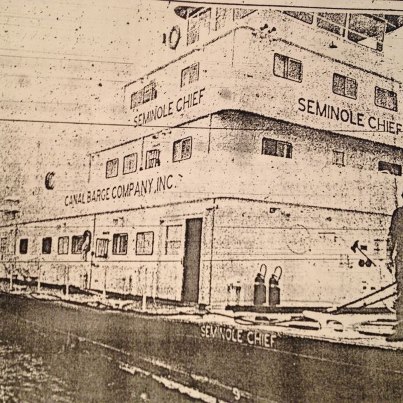
My father, Phillip worked for twenty five years for the Farm Bureau Refinery river dock and he enjoyed meeting the men of the river, their stories and of course the great meals on board. Occasionally, I had a few meals aboard. This was the one thing that kept the men happy being at work for 30 days straight. This tug, the "Seminole Chief' was one of the better ships I guess navigating on the Ohio River in those times. It was equipped with the latest navigational instruments on the bridge with a radarscope to see the way down the channels in the blackest of nights. It had a veteran captain of decades of experience named Otto Norregaard. On this trip it was pushing 12 jumbo sized coal barges down the river. Each barge carried 36,000 tons of coal and they were linked two-abreast. The vessel had two 3500 horsepower GMCs humming in unison. Crew members shared two men rooms and there is one guest room. I bet that is quite a trip to follow the river all the way to New Orleans. Lots of history of those who traveled it before you.
Jeff Embrey and Andy Kinsey.....1981
Remember when Jeff Embrey and Andy Kinsey were both all Big 8 selectives in basketball in 1981. They both went to the University of Evansville...Jeff continued his basketball career and Andy became Ace Purple.
1970's
Wanda's Pizza Gutted.....March 1979
Boy, this town sure has its share of fires doesn't it? Wanda's was at 108 West Second Street and was spotted at 4:30 a.m. by a passing factory worker. It was quickly contained by the Mt. Vernon Fire Department. Clyde Straw, owner said he was the last person to leave the building the night before. It was believed the fire started near a grill in the kitchen. Thirteen fireman and three trucks fought the blaze which generated enough heat to melt a telephone near the restaurant's front door.
Gasohol Goes On Sale Locally for First Time.....February 1979
The new mixture of 90% gasoline and 10% alcohol was expected to sell about 1000 gallons on its first day said a spokesman for the Farm Bureau Co-op. It had sold 250 gallons in its first three hours of operation. Priced at 76.9 cents per gallon it was 7 cents higher than regular unleaded. Proponents say the gasohol gives better gas mileage and reduces the need for foreign oil. Now Mt. Vernon has its own huge ethanol plant called Aventine at the Ports of Indiana on the Ohio River.
Speaker Once Planned to be a Voodoo Witch.....January 1979
The Rev. Devil LeGrand spoke at the Point Township Church of the Nazarene. A native of Haiti, LeGrand was planning to become a voodoo witch doctor when he was converted to Christ. In the past nine years Devil, started 12 mission churches besides pastoring his mother church.
Fire Truck and Policeman Collide at 4th and Main....January 1979
Off duty patrolman, Bobby Joe Steward was treated and released at Welborn Clinic here in town (wish we still had that) when he was involved in an accident with a fire and rescue truck driven by city fireman Daryl Shuck at the intersection of Fourth and Main Streets. The accident occurred while the fire and rescue truck was on an emergency run for a fire call on East Second Street. A washing machine had caught on fire. The fire was then handled by Fire Chief Leonard Kuhn. The truck was proceeding south on Main with both its siren and lights on. Steward was going east on Fourth Street. The truck stopped at the signal light at Fourth and Main, looked for traffic either east or west bound on Fourth Street. Seeing none, the truck started through the intersection, according to the Mt. Vernon Police Department. Steward, traveling east on Fourth came to the intersection and saw a green light. He traveled into the intersection, not seeing the truck because of another vehicle in the left turn lane of East Fourth. Steward then drove into the intersection and the two vehicles collided. The city's truck was damaged up to $3000 and Steward's vehicle in the amount of $600. No citations were issued.
New Posey County Jail Holds Open House.....January 1979
According to Sheriff Carl Dick over 1000 people toured the new jail in the six hour Saturday open house. Many were surprised that they didn't see carpeted cells or a swimming pool. The jail was not as luxurious as some expected. Groups of around 25 to 30 were allowed to tour the complete facility. Pictures of the old jail were posted so the public could see the improvement. Those who went had a rare chance to go to jail and not be embarrassed.
Two Brothers Try to Commit Suicide a Week Apart in Jail.....1979
After lights out on a Saturday night in March, Jimmie Joe Underhill, 22, tied his hands and feet to the bunk with strips of his shirt, covered his body with newspaper and a sheet and set fire to himself. Underhill was flown by helicopter to Wishard Memorial Hospital in Indianapolis for treatment where he suffered first and second degree burns to both hands and legs. A note left in the cell stated that he was sorry but felt he had to do it. During an investigation Sheriff Dick said it was determined the reason for the attempt was a "family problem." Underhill was awaiting trial on several counts of burglary from 1978. One week later Eddie Underhill, 29, was found in his cell, lying on the mattress covered with a newspaper and letters that were blazing. He suffered minor first and second degree burns. Eddie was in jail awaiting trial on 7 counts of burglary.
Ray Happe's Private Zoo.....1979
Located in the country is Mr. Happe's zoo. He had a pet llama named Rosebud that he had bought at a horse auction in Daylight, Indiana and the children of the Headstart Program come out twice a year to see him and his other animals. Rosebud it seemed liked children and would jump the fence to visit neighborhood kids. That's how he got his name too, from eating the neighbor's roses. Besides Rosebud he had several does and a buck. He had a pet donkey too, named Gino who acts as Mr. Happe's watchdog. If someone enters the yard, Gino would make a commotion. Sugartop, a former Shriner's horse gives Gino a kick in the rump now and again if he is too loud. He had a Great Dane also , plus a singing dachshund, and lots of ducks, geese and turkeys
Director of the Southwind.....1979
In 1979 it was reported by Mark Allen, Director of the Southwind Maritime Centre that 200 people working around the clock are now pushing cargo up and down the Ohio River at a rate eclipsing what goes through the Panama Canal. Trucks loaded with grain, many coming from southern Illinois are lined up daily from the port back to State Road 62 to unload grain onto barges. Just like the nineteenth century when crops and hogs were sent south, Mt. Vernon is still a important river city. The Centre received its first commercial shipment in April of 1976 and at the end of the seventies, a 380.000 bushel grain elevator had been constructed by Behimer & Kissner, a major grain shipper along with two bridges, a second cargo pier and a administration building. A craneway had been completed also and a transit was under construction.
On June 15, 1978 fire destroyed the Louisville & Nashville Railroad Station in Mt. Vernon.
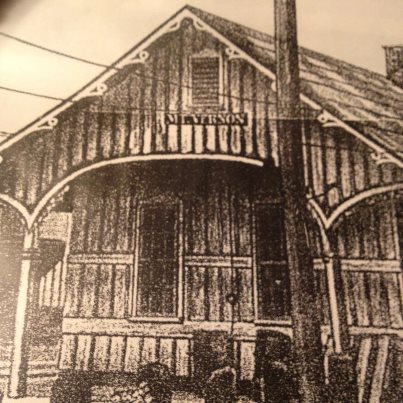
The depot along with signal material and all equipment were destroyed. Estimated total cost was set at $77,677.83. The building was built in 1891. The last steam engine ran through here on January 1, 1953 and then they changed to diesel. The very last passenger train came through on May 1, 1971 from Evansville to St. Louis. I took one of these back in the 1960's heading for Union Station in Missouri where I got a taxi and headed for Sportsman's Park on Grand Avenue to watch the Cardinals. Usually when the line was full strength it had 8 to 10 cars-4 Pullman, 1 diner, and 3 baggage cars. You see a lot of weeds on the way to St. Louis! hahaha.
"And this bird you cannot change"......1978
I have had 2 neck surgeries over the years. I blame the first one from doing sit-ups to "Free Bird." When that sucker kicks in hard and heavy ole ~ Wavy J ~ got a good workout!
"Born On the 4th of July" Bicentennial Doings...1976
Plans were getting in full swing in May as the town painted a Bicentennial emblem on the street at Third and Main and painted a red, white and blue stripe down the center of Main to the riverfront. A day to remember was the wagon train that was traveling across America stopping in Mt. Vernon complete with longhorns. June was declared River Awareness Month and massive church services were held on the fourth.
Tidbits of the "Great Ohio River Flatboat Race" of 1975
In the third running of the race between the nine towns of Owensboro, Henderson, Sebree, Sturgis, Morganfield, Madisonville, Hawesville, Newburgh, and Mt. Vernon or local entry "City of Mt. Vernon" took away the most sought after prize...the most authentic craft. Evidently, mosquitos were a problem and you can bet anyone out on a flatboat at night would have a problem. Wonder what Huck and Jim did? We do know that Tom Payne and cartoonist Glenn Curtis had no problem because after the first night they managed to find a motel for every other night....so much for roughing it. They said the Mt. Vernon group sang "Wasted Days and Wasted Nights" from the beginning of the race to the end. They had a guy blowing in a jug, another strumming a guitar, and of course our buddy Glenn playing the "stuffed raccoon." hahaha. Thata boy! I would have had one of those clay pipes.
Traffic on Fourth Street.....1975
Was driving along here the other day and as I got to the stop light along Walnut and Fourth the light turned yellow. The truck in front of me with a long trailer continued forward and blocked the entire intersection preventing traffic under green to proceed north. Fourth Street sure has a lot of traffic especially when people are going to work and leaving from work. Back in 1975 there was a four way car accident at the above named intersection. It started when one car rear ended a police car and two cars behind it banged into all the others. I would have loved to have placed cartoonist Glenn Curtis on the curb observing this! LOL. I guess the traffic flow wasn't use to a car stopping on yellow as everybody was trying to fly through it.
Former Employee of Strawboard Company Interviewed.....1975
Millard Rose was interviewed one summer day in 1975 by the Rev. August Binder and here are a few highlights: When Millard was only 16 he went to work for the Mt. Vernon Strawboard Company on West Second Street, back where many of us remember Texaco. Millard's father had a hand in building the factory in 1904. Millard worked there until the plant closed in 1933 and moved out to Alton, Illinois. It had 150 to 200 employees in its heyday and was started by someone's called the Funky brothers. It was then in the hands of the Mt. Vernon Paper Board Company and then Alton Illinois had ownership. Rose worked there for 13 1/2 hours a day making $2.50 per day. Later as he moved up from cutter boy to finisher he got $3.75 a day for the same hours. No coffee breaks, but an hour for lunch. Pranks and "horseplay" were fixtures of boredom. One turned bad. A man brought his lunch and the boys got to playing pranks on him one night and got into his peanut butter sandwich and put old grease on it. He ate some of it and didn't like it. After he saw what it was, he went home and "beat the dickens out of his old lady" and the law was called. "People felt real bad about that one!"
Thrift Shop Opens June 1973
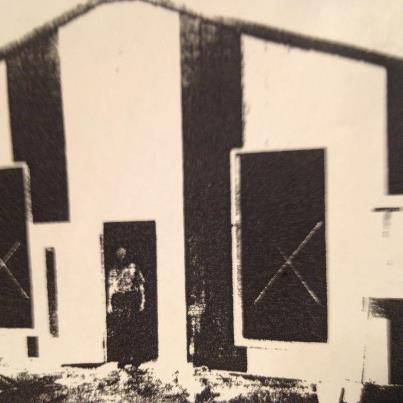
On North Main Street, the Thrift Shop provided warm clothing at a low price for so many in need and those who wanted a bargain. At this time the Rev. August Binder was the chairman of the shop. It was a non-profit organization. How many school children in need of some assistance of used clothing benefited from this store with the help of donations of the community? The cost was around $16,000 at the time it was completed and they hired a few "handicapped" individuals to work under supervision expanding their opportunities. I have dropped many a box clothes off that I out grew. I am sure you have also.
To Honor Memory of Mt Vernon Founders.....1973
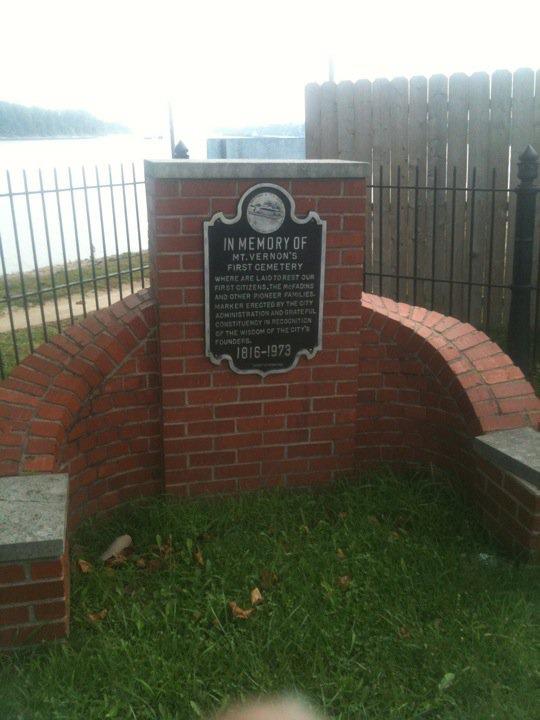
Must have took a little longer than they hoped as an article said, "Plans of the Posey County Historical Society, inaugurated several years ago, are to be realized and the memory of the founders of the city of Mt. Vernon, the McFadin family, will be honored with the placing of a suitable marker over their graves on the bank of Mill creek near Water street and College avenue. The work of placing the marker in position was started last week. It is a block of Vermont granite, presented by Dr. R.E. Wilson, which will bear a memorial tablet and will be set in concrete. Around the graves and the marker will be lengths of chains, supported by stone posts. In 1930 the Posey County council made a general contribution to this work and the city council acting on the suggestion of Councilman Edw. Stallman, agreed to donate the site and be responsible for the labor of erecting the memorial. Following the completion of the work, the Posey County Historical Society will hold a fitting ceremony to properly dedicate the marker." Evidently, this is not the original marker. Anyone have any information or pictures of the original?
Brittlebank Park Dedication.....1973
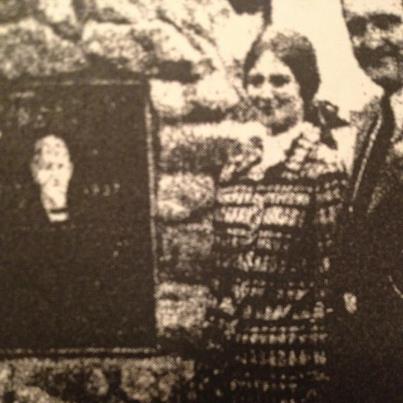
Barbara Givens, former park board member and Mayor Jackson Higgins.
"If You Got It, Light It".....September 1971
That was the stage announcement at a concert in Evansville, labeled "A Peaceful, Heavy Happening." Muscle, Gandalf, Bloodrock, Crow, Rare Earth, Jimmy Spheeris and Richie Havens were the performers. I was not at this concert; Uncle Sam still had me in his grasp but from all I read this was quite a scene. Over 4000 were in attendance at the stadium and pot was smoked openly. Jimmy Spheeris and Diane Davidson provided the good vibes opening the show with earthy folk-rock and then two local bands played the hard core stuff. Crow was a surprise I was told with "combined motion and sound created a almost electric environment." Those my age remember the backdrops of swirling globs like a big lava lamp. Tripy! Their hits, "Evil Woman" and "Don't Try to Lay No Boogie-woogie on the King of Rock and Roll" were said to be masterpieces of showmanship. Rare Earth got things jumping with "Big Brother" and the blend of vocals and instrumentation was praised by the faithful. Bloodrock came on. This is a band I was familiar with later on and that day the lead singer was said to have possessed, "a definite sexual overtone" and the crowd ate it up. My "contact" for this show said that by this time the crowd was ecstatic and everyone was on their feet passing the wine skins and the "other stuff," dancing, jumping and screaming for more. Richie Havens, the Woodstock legend entered and had everyone sit down and he mellowed everyone out with lyrics of peace and harmony and everyone went home happy. "Sometimes I feel like a motherless child," but not that day....it was more like, "Here Comes the Sun."
Sunlight Mill Demolished.....May 1971
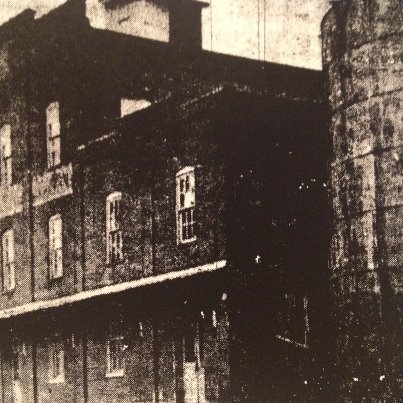
Located on the 200 block of East Water, it was built in the early 1900's by Charles Kreie. Louis Schnur was the head miller at the mill for many years and suggested the name. The name came from observing the position of the mill and the arch of the Ohio River reminding him of the sun. The mill closed in the late 1920's or early 30's and the land was acquired by the Mt. Vernon Milling Company and was sold to J.R. Short Milling Company in 1947. The mill was incorporated in 1902 and the President was Charles T. Johnson. In the early years it was said to consume about 150,000 bushels of wheat annually. One old employee, Herman Brakie who worked there said in the 1920's the mill produced about 15 barrels of flour a day and there were eight employees not including the office staff. The mill had several brands including Sunlight, Best, Sifted Snow, Peach, and Belle of Mt. Vernon When Sunlight introduced self-rising flour, people thought it was bad so the wife of the president baked biscuits and went through the town giving them away to show they were delicious. A fire gutted the inside of the mill in 1947 and Short used the mill only for storage of machinery and parts thereafter. It was torn down as a "beautification program."
Rare Earth at Robert's Stadium.....January 1971
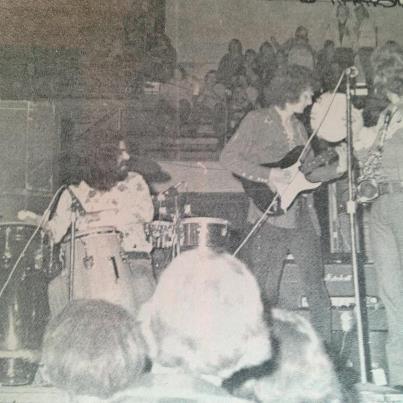
They played with a San Francisco band called Wizard and a local Evansville band called The Herd.
Groundbreaking of GAF plant on Givens Road 1971 or 1972
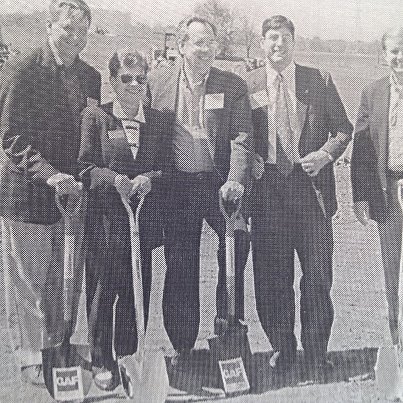
Junior High Remodeled.....1971
The old school on Canal Street was spruced up. Fire doors were constructed in the halls to help prevent fires from spreading from one floor to the next. New lighting and carpeting was installed in almost all the rooms and new lighting in the gym. Throughout the building the ceilings were lowered, the girl's dressing room was remodeled with new showers and partitions. Many new desks were brought in and new plumbing was added. The old barracks in the back of the school was torn down and covered walk way was constructed from the Junior High to Hedges Central. The old coal bin was cleaned and converted into an art room believe or not. The school board purchased magnetic blackboards that served as walls in the art room. The old art room became the teacher's lounge. In the balconies of the auditorium it was converted into science labs and air conditioning was added. New lockers were also added for the students. The remodeling cost was estimated at $342,528.13.
Police Arrest 78 Persons at Riding Stables in Beer Party.....1971
Not to be out done I guess by the great youth bust of 1968, seventy-eight persons were arrested on a Sunday night in a raid at the Double H Riding Stables. Forty of those arrested who were 18 years of age or older were charged with either illegal possession of alcoholic beverages or contributing to the delinquency of a minor in Black Township Court. State Police said charges would also be brought against the owners of the stable. The raid occurred around 11:30 pm when police received complaints on the party. Deputy Sheriff Carl Dick said the officers found a nearly empty half barrel of beer, wine and Vodka bottles, and empty apple cider bottles. Those arrested were transported from the stable on Hartmann Road in Marrs Township to Mt. Vernon City Hall where Percy Brite held court. All but one of the 40 pleaded guilty and charged $1 and cost by Justice of the Peace Brite. The 38 teens under 18 were turned over to juvenile authorities. Sure are some familiar names in that bunch, but I won't embarrass them forty years afterwards.
Boonville Police Treat "Long-Hairs" to Steak.....1971
A confrontation between police and a group of hippies resulted in a happy ending for the freaks. The cops lost a basketball game to the youths 42-38 which cost the officers a round of steak dinners. Amidst the calls of trash talk the two groups battled hard to the finish with pride on the line. Had the youths lost the payoff would have been a hair cutting session at mid-court. Boonville Mayor Bob Millis called the game and called it an "achievement in bridging the generation gap."
Sheriff's Grandson Catches Big Beaver.....January 1970
Hahaha...no Ray J is not going there! Fourteen year old Jeff Rogers, son of Mr. and Mrs. Kenneth Rogers of Griffin caught a 61 pound giant beaver during his winter trappings in the Griffin River Bottoms.
B&W Plant Union Votes For Strike.....January 1970
The result of the vote by Local 904 of the Boilermakers Union at Babcock and Wilcox plant was 740 for a strike and 7 against. The vote was taken at the Memorial Coliseum. The plant employs about 1200 hourly workers. A contract is said to expire in February and company and union officials are reported in negotiations. The previous contract covered 27 months and it was signed in 1967 after a month long strike.
The old Judge John Pitcher Home in 1970's.....530 College Ave.

This old home was said by local legend to have had the bricks laid by Governor-to-be Alvin Hovey and his brother. Pitcher, a friend of Abraham Lincoln loaned law books to him when he lived in Spencer County and law books to Hovey when he studied for the bar. The house was constructed in 1867. It was purchased by C.H. Fullinwider and used as a home and medical office in 1908. It remained in that family until the death of Miss Ann Fullinwider in October of 1978. An effort was then made by Ron Greenfield to have the home placed on the National Register of Historic Places. If that would have happened it would have been able for grants to restore the building. i don't what if anything came of that. In February of 1979 the home was sold at public auction and purchased by John R. Keck, representing Keck Motor Company for $32,000. Aubry Robison Jr. stopped bidding at $31,000.
City Signs Contract for Modern Lighting.....1970
City Council passed and signed a contract with Southern Indiana Gas and Electric Company for installation of 52 new lights. Mayor Albert Blubaum said of the program: "It makes Mt. Vernon look like somebody lives here!" That's a good one and from a Republican. hahahaha. The installation of 37 new 400 watt mercury vapor street lights and 15 new 175 watt mercury lights will replace outdated incandescent ones.
"Let dogs delight to bark and bite; For God hath made them so.".....1970
Back in 1970 the Independent Pentecostal Assembly was at the location of 300 West Second Street and here behind an old store front building was the city dog pound. One Sunday morning the animals were especially noisy. Yips and howls, barks and growls and the pastor was having a very difficult time relaying his long sermon to the congregation. In desperation, he turned toward the wall behind him, stretched forth his hands like Moses at the Red Sea and ordered the canines to be silent in the name of the Lord, Jesus Christ. A deadly silence followed for the remainder of the service. "Let it be said, Let it be done."
1960's
Ice Skating Rink?.....1969
An attempt was made by the Mt. Vernon Park and Recreation Department for an ice skating rink. It was built near the river on Canal Street. It ran into a problem though...an embankment was put up around the rink, filled with water by a nearby fire hydrant and fire hoses, but the weather never stayed cold enough to freeze and then half the water drained out. Another attempt was promised, but I don't know what became of it.
"Nixon Will Get Double Pay Paid to LBJ"....Presidential Salary History....1969
The House voted to pay Richard M. Nixon $200,000 a year as president, twice what his successor made. In the debate, members said the pay scale was still "chicken feed" for the nation's highest office. One said however, that this action opened the federal checkbook to outlandish increases for other government workers. The President also was to receive $50,000 per year to cover expenses and $40,000 for travel and entertainment expenses. I looked up the history of Presidential salaries and found that George Washington was paid $25,000 per year which in 2009 dollars would be the equivalent of $566,000. In 1873 when Republican Grant was in office it went to $50,000 or $865,000 in 2009 bills. During the Republican administration of William H. Taft it hit $75.000 or the same as $1,714,000 per year today. Forty years later under Democrat Truman we hit the $100,000 per year wage...the same as $906,000 today. In 1969 Nixon got his $200,000 payday which is like $1,175,000 now and Obama makes $400,000 which is like only $487,000 in 2009 dollars. Of course this doesn't take in the perks like residence, bowling alley, gym, movie theater, chefs, etc. I doubt a raise will come up during these times!
Wildcat Word Staffer, Debra Dunning has Interview with the Band ....January 14, 1968
It was a Friday night at Roberts Stadium in Evansville where Mt. Vernon student Debra Dunning was lucky enough to get permission from their manager to take pictures of the group and do an interview. Their next stop was Albion, Illinois then Springfield, then Chicago. At the end of their tour they would be in Mexico City. They invited her into their dressing room, bought cokes and sat and talked for an hour. During the interview the roadies were loading the bus and then there came a knock and it was time to leave. The band was staying at a local Holiday Inn. A few more minutes passed, and Gary promised to send postcards to her of the different points on the tour. Debra said it was a moment she will never forget. Deb is no longer that "Young Girl" as she is a "Woman, Woman" and has lots of "Lady Willpower" I would suppose. .....Cute huh?
"Motley Crew", no not the band...passes through eventually ....1968
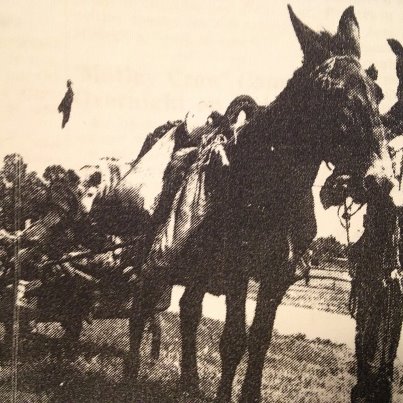
Weldon Minnick on the road for seven years since he left Connecticut finally got across the Wabash Bridge. His traveling companions-a pet wolf, a Shetland pony, a mule, and a mongrel dog waited out the rain in Mt. Vernon before heading to New Harmony then northeast to "wherever." The day before the crew camped overnight on Indiana 62 west of Mt. Vernon when the burro refused to pass over the bridge and turned back. "Stubborn cuss," Weldon said.
Senator Vance Hartke in September 1965 of Uniontown Lock & Dam Groundbreaking.
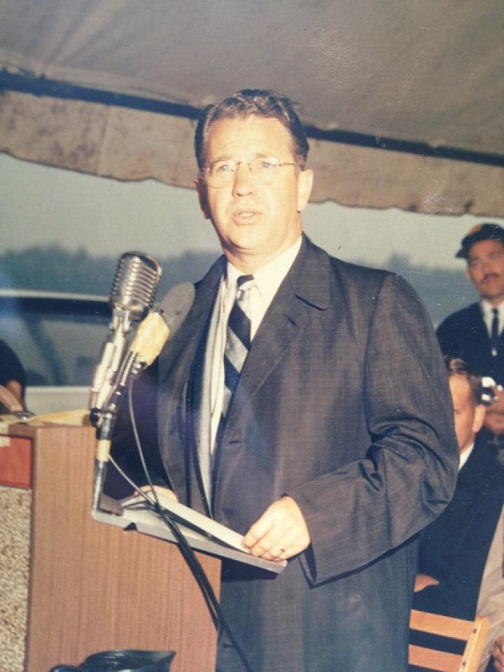
Esteemed Mt. Vernon Lady, Dies.....August 1965
Mrs. Mary Jensen Andersen, 70, who came to Mt. Vernon with her husband, the late Holger Andersen, carved a name for herself in our community. A native of Jamestown, Kansas, she met her husband there who ran a creamery. The Mt. Vernon Creamery was Holger's pride. Mary was prominent in the community with church, cultural and homemaking activities. Her Christian character shown through in all her activities. At the Mt. Vernon General Baptist Church she was for many years superintendent of the Primary Department of the church school. She was an officer of the women's organizations of the Church Sunshine Philathea Class, Ladies' Aid and Women's Missionary Society and many charities. She was a past noble grand of Helen Rebekah Lodge, a member of Sunbeam chapter, No. 1, Order of Eastern Star, a past president of Mt. Vernon Coterie and a member of Harrow Relief Corps and the Busy Homemakers Home Demonstration Club. She taught ceramics at the Evansville YWCA and pursued the arts of painting also. She maintained a studio in her home and her works drew wide attention. She was a member of the Posey County Art and Crafts League and Tri-State Ceramics Club. Mrs. Andersen became ill while visiting her brother, Martin Jensen, world famous aviator and one of the Pacific Ocean conquerors in Los Angeles. Heidi Schaffer Henderson has contacted me recently about College Point School on Holler Road. The Andersens bought it after it was no longer a school and renovated it from a one room school into a 3 bedroom home with kitchen and a bath. The Andersens didn't really live there but used it for company parties and community activities. It was here I remember going to a huge Easter egg hunt. I too was a member of the General Baptist Church, then on College Avenue. Heidi's family moved into this building after Mary's death, residing there 33 years and she tells me there were painted murals on the walls including an apple orchard in the hallway, swamp in the living room, ocean with whales in the bathroom and a vineyard in the stairwell. Costumes were stored upstairs for Christmas and Easter pageants. There were even puppet shows. Mrs. Andersen kept a journal and in it she refers to the school as "Hobby Hill." Heidi has graciously decided to give me the journal to go through and then donate to the Posey County Historical Society which I will be most happy to do.
Local Students View Watts Riots in LA.....1965
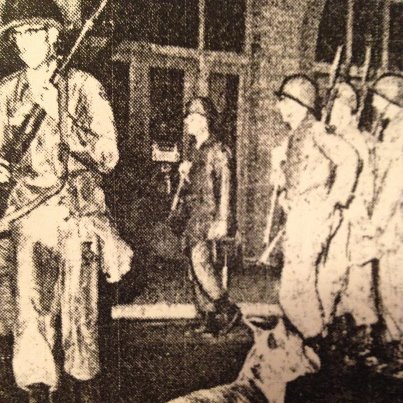
Fourteen Mt. Vernon High School pupils, members of the Junior Classical League were attending the national JCL convention at USC and had a firsthand look at the race riots as they broke out. Florence Kouts was their sponsor and chaperon. The riots spread to the campus area on a Friday night and all the students were segregated by sex and locked in buildings of the dormitories. From their windows they watched the rioting and burning of buildings and cars. The bus they had charted however was unscathed and early Saturday morning at 4:30 a.m. they passed through the wreckage. They learned later that between 5 and 5:30 the rioting became severe on campus. The tourists also visited Juarez Mexico as well as Carlsbad Caverns and came back the following Thursday. The group included: Phyllis Rohlman, Amy Vollmer, Nina Marie Kelley, Joe Moll, Beverly Imsande, Evelyn Scherer, Deboralh Hatch, Mary Lou Dick, Susan Cox, John Russell, Steve Dick, Larry Gregg, Ann Atkins, Charles Scherer and Mrs. Kouts.
Eddie Howard ....Pitcher Deluxe....1965
I checked the records once and Ed a four year baseball starter at Mt. Vernon only lost one game in his career and that an extra-inning game in his freshman season!. I watched him from the bench when I was in school and played half dozen years of softball with him. He was the best baseball player I saw in my opinion from Mt. Vernon. Here are a couple of highlights from his American Legion days. Against Vincennes he tossed a one hit shutout (9 innings) at Athletic Park striking out 21 batters. This was one strikeout less than the record held by Carl "Windy' Wade in 1963 vs. Ferdinand. The only hit was a single in the hole through the infield in the third inning. Mt. Vernon won the game 10-0. That same year, Howard pitched a no-hitter vs. Mt. Vernon, Illinois striking out 20. He could hit too. I saw him hit two out in one game at Jasper in high school and play the heck of shortstop. Military service came calling and Ed never got the chance to show what I am sure would have been impressive in pro ball. He hurt his arm, but I think his first year back from military service he led the Double I League in hitting.
Site Chosen for Neu-Way Cleaners.....1965
For 18 years Neu-Way Cleaners ran a successful operation at 409 Main owned by Mr. and Mrs. Louis Risch. In 1965 they announced an expansion at 119 West Fourth by leasing 2400 square feet of ground in the 100 block of West Fourth directly east of the Sinclair Service Station. The property is owned by Mary Rose Weber. A modern building was to be erected which will handle receiving of apparel and pickup. Pressing equipment would also be housed in the new unit. The central cleaning plant will continue on Main and steam line from the central plant to the new building will be installed. There will be parking for five cars at any one time.
What's wrong with this picture? Circa 1965
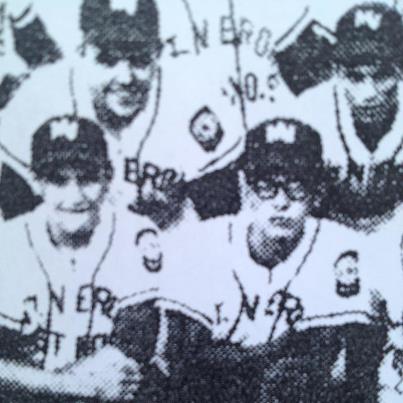
This is part of the American Legion team I played on in 1965 and 1966. This photo shows Gary "Bucky" Burns, Ed ""Sneak" Howard, Jim Estes, and Jim Poshard. What was wrong is that Mt. Vernon is spelled wrong on the jersey. There is no n after the r. We wore them for years. They were nice...red and blue and a heavy duty zipper up the front. The trim was nice, even around the back pockets like the Braves had at that time. It was a winning season. I remember we were all MV players except Kae Moore of New Harmony and Gary Weinzapfel whom I believe played for one of the Evansville catholic schools. It was a good defensive team, .300 hitters, good pitching with Howard, Burns, Paul Mason, and Court Rheinhardt. Jim Roeder hit well and David Trout was an excellent receiver. Bob Ozinga had a fine arm in left field, and Bruce Schrieber was a fine infielder.
"Street Fight'n Men".....1965
Battery B, Mt. Vernon's National Guard unit held multiple drills at the local armory over a weekend on riot control and civil disturbances. They pulled out their howitzers earlier in the week for display. I've faced tear gas canisters, but howitzers?......no way.
GE Lexan Had Role in Space Walk....1965
When astronaut Edward White walked in space the space helmet he wore was constructed of three layers of Lexan polycarbonate manufactured at the Mt. Vernon plant. The outer layer, tinted blue green protected the astronaut's eyes from the rays of the sun. The middle layer was tinted gold to guard against heat. The clear inner layer sealed pressure inside the space suit. Lexan resin was selected for this critical application because it is the toughest and most unbreakable transparent material available and retains those qualities even in extremes of hot and cold temperatures. Use of this plastic material in safety hats, crash helmets, face shields, etc., was increasing rapidly.
"Just a Half a Mile from the Railroad Track".....1965
Now this is a story of the Mt. Vernon Depot Massacre without the three part harmony. Now it all started around forty years ago, forty summers ago in Mt. Vernon it was....The class of 1965 was planning a senior trip to St. Louis aboard a train. They all got their ticket, walked in, sat down, the teachers walked in, sat down at for a while all was good reading the magazines and looking out at the weeds flying by on the tracks. After a while, the train came to a screeching halt...errrrrrrr! Somebody pulled the emergency cord! Girls flew into the aisles and one certain business teacher and sponsor spilled coffee all over his dress shirt. Laughter turned to stern looks as the culprit was sought. It was fast becoming the great mystery of the Midwest. If they would have had a Officer Obie, he would have taken him down to the police officer station along with 27 glossy photos with pictures and arrows explaining the crime. Well they went to a cinema and one student who looked 21 bought beer by the case and distributed it to his classmates as I have been led to understand. Meanwhile he stood in the foyer looking out for the fuzz. They got to the zoo I believe and one fella jumped the fence and got into the duck pond with the ducks. "Kid, get out of there, we don't like your kind, we are gonna send your prints to Washington." Finally, they all got back in the train, sat down, teachers walked in, sat down ...trip had another emergency brake incident, but no one found the truth to the matter. The students knew, but no one ever had to face the heavy hand of the law or sit on the Group W bench because of it. Of course on the way back some had to relieve themselves off the caboose and others just to hurl, I imagine. Oh the massacre, I almost forgot. The class was given a box lunch and probably wasn't the best Thanksgiving dinner that could ever be beat so they saved it and waited, and waited...they waited a long time; because you see somewhere long before them a tradition arose to throw the food at the juniors waiting at the depot as a food fight between the two classes was expected. Well, they got to the depot, the depot in Mt. Vernon and there were the juniors, the juniors right there in Mt. Vernon, at the depot. Everything was cool man, but for one little thing. You see the juniors came unarmed, but what the hell, the seniors destroyed them with cups of cole slaw. Now friends somewhere there are survivors of this massacre who probably remember this differently and they are probably rehabilitated. I wonder if they picked up the garbage. Anyway, that my friends is why you didn't get a senior trip!
Sorry Court!.....1965
Being a pack rat, I was looking at a old scrapbook of mine with American Legion newspaper articles of some of the memorable games I played during the sixties. Funny how I was good enough to start in the infield in Legion ball but wasn't able to make much of a dent in high school. Nevertheless; I found this game vs. Ferdinand at their place I remember. Court Reinhardt started this second game a doubleheader. Court was a hard luck pitcher our senior year. That season we lost 7 games in a row by one run and 13 of the 16 we lost that season by a single tally. We did make it to the finals of the sectional losing....you guessed it by one run. On this particular night, we opened the first inning with a walk and two errors and I got a hit to give us the only run of the game. Court carried a no-hitter into the bottom of the seventh inning when the hitter hit a high chopper over the mound that I charged from my position at second base. Meanwhile, the shortstop, can't recall if it was Jim Poshard or Stan Billman also tried to field. We couldn't get out of each other's way and it went for an infield single. Looking back it should have been the shortstop's play coming across. I messed up lefty..."my bad."
Roger Zion Speaks at High School.....1965
Republican candidate for the 8th District, Roger Zion spoke to about 150 people in the Mt. Vernon high school cafeteria on his take on the Republican Party. He said the landslide by the Democrats in 1964 was because of negativeness placed upon them by the Democrat's well-oiled machine which influenced their voting. Come on Mr. Zion! Let me say right off, Congressman Zion was not a favorite of mine. In 1967 he made headlines calling anti-Vietnam protesters, "traitors" and that they should "have their hair cut off like the French did to collaborators with the Nazis." He went on to say that some of the positive programs we should support were: "free enterprise, less government spending, fewer farm controls, the present immigration laws, a progressive foreign policy, states' rights, free gold market, independence for Puerto Rico, lower taxes, pure food and drug laws, separation of church and state, and a sound dollar policy." Well, he won three terms as congressman finally defeated in 1974 by Phillip Hayes. Of course, like many politicians he stayed in Washington D.C. and from time to time I still see a letter in the Courier pushing his views. Mt. Vernon treated him well that night with a delicious buffet dinner prepared by Mrs. Florence Krietenstein and her staff with attractive table decorations of Lincoln silhouettes and elephants. I wonder who won the door prize.
Throwing Newspapers.....I Guess the Art is Gone.....1960s
Back in the sixties...you know like six or seven U.S. wars ago I can remember Marion Shuler and his sister Anna Kay sitting on the step next door folding the Mt. Vernon Democrat to deliver. Just folding them would be a chore. Maybe he will comment on the art later. I can remember how papers could be thrown and they would sail like a Frisbee with a nice screwball effect curving just right to land on a porch. Now if you were throwing the Courier or the evening Press you had a heavy object with a rubber band around them. Some of these boys could let her fly from the street on a moving bicycle-a distance of thirty or forty feet and sail it through the porch and bang up against the metal screen doors of your home. Ours was always banged up. I don't remember people complaining much....they would come outside look in the bushes or the driveway for their paper coffee in hand and wearing shoe slippers and wave at the neighbors picking up their milk bottles. I wasn't much of a paper boy....sold the Grit once in a while and flower seeds; people would feel sorry for me and buy it. If there is a Grit and a sales boy however, come on by. I'd like one.
"Jackie" replies to tot's letter....March 1964
Ellen Cochrum, daughter of Mr. and Mrs. Charles Cochrum of rural Mt. Vernon received from Mrs. Jacqueline Kennedy acknowledgement of her letter to Caroline Kennedy. Ellen was sitting in front of the television in her home on the day of President Kennedy's funeral and remarked to her parents: "I feel so sorry for Caroline; I believe I will write her a letter."
New Mt. Vernon Cafe Opens....February.....1964
For the first time since the Shario closed, Mt. Vernon will again have a Main Street Restaurant...in fact the name is the Main Cafe at 221 Main, recently occupied by Tom's Sporting Goods. The restaurant is owned by Mr. and Mrs. Ed Lancaster of West Third Street. Mrs. Maimie Harris, with 15 years as experience will be the head cook. The cafe will serve dinners, lunches, steaks and chops and open daily, except Sunday. Plate lunches are 75 cents with coffee included.
Thieves Score at Nudie's Store.....January 1964
You like that? Haha. This was another rash of burglaries occurring in town that month. This one occurred at the Nuding Office Supply at 128 East Second Street. Owner Paul Nuding discovered several valuable items of stock missing when he opened his store as usual. First thing he did was to turn on the radio, but it was missing, and a check behind the counter revealed that the contents of his pen and pencil sets were missing as well as a set of field glasses. Value was set at $500-$700. Entry was gained by breaking a window in the rear of the building. Some loot was left behind in that area upon exiting.
"Whoo Hoo, Yeah....Firehouse"....January 1964
Bring the fire to the firehouse! Don Yates, a truck driver for Bonified Truck Lines of Evansville did just that. Yates had a tire blow off his semi-truck trailer and drove the burning rig in front of the First Presbyterian Church next to the station, where the blaze was extinguished. Four tires on the tractor were damaged and eight wheels on the trailer will have to be replaced, but his quick thinking saved the truck from being consumed.
Paul Brenner Rolls First Perfect Game at Posey Lanes.....1964
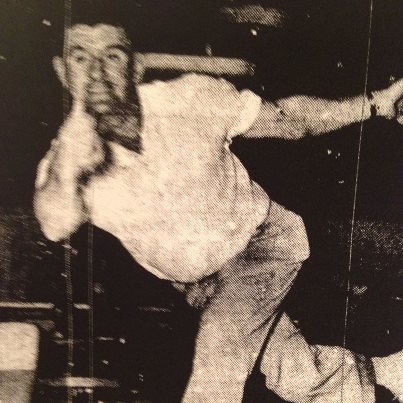
Paul was a regular bowler at the alley competing in three leagues and carrying an average in the upper 180's. Posey Lanes was in its fourth season when this 300 game was bowled. It came in his third game on the heels of a 203 and 179 giving him a 682 series on the night. He had a higher series however in 1962 when he rolled a 714. The previous high game had been a 289 at Posey Lanes by Tom Hendrix in 1963. Among the awards he got for his beauty was a wrist watch or diamond ring from the American Bowling Congress, $100 from Posey Lanes and a US Savings Bond from the company which manufactured the shirt he wore while rolling the perfect line. XXXXXXXXXXXX!
Local Teens Letters Show Up in Advice Column of "Dear Abby.".....1964
A 17 year old school boy wanted to quit school and wrote "Dear Abby," otherwise known as Abigail Van Buren. School librarian Mrs. Charles Rachels found the story compelling and she asked ten students in her home room class to respond. The letters were written and sent into Mrs. Van Buren. Rachels received back a letter of commendation plus personal notes to all the writers complimenting them on their "insight and maturity" and saying that their "parents had done a good job." A couple of days later, the Evansville Courier was contacted by "Abby" and the Teen Page staff published six of the letters. Later the "Dear Abby" syndicated column ran one or two or the letters. The ten Mt. Vernon students who wrote the letters were: Mary Russell, Jeff Saltzman, Judy Schmitzer, Gary Schneider, Mary Schoening, Connie Seifert, Donald Shelby, Frank Slagle, David Stevens and Lynn Stubblefield.
"Beat Bosse, Beat Bosse, BEAT BOSSE!!!".....1964
Mt. Vernon after several poor seasons on the hardwood was starting to get better. Bosse had won state in 1962 and had stomped us 83-37 with Gary Grieger netting 39 against us. As the 1964 team unfolded we were 6-6 with a win over Memorial and two and one point losses to Mater Dei and Harrison. We were hoping for some pay back. The team under new coach Don Stanton had veterans like Gary King, Jon Uebelhack, Mike Ashworth, and Max Dieterle. That wasn't all.... there were new blood like Eddie Howard, Bob Ashworth along with Bob Ozinga. A new deeper bench with the likes of Charlie Hopper, Paul Mason, David Junker, and Tom Collins were there too among others. We caught the Bulldogs at our place in January and for over a week the school and town had been buzzing about the Bosse game. The cheerleaders proclaimed it 'Beat Bosse" week and all calls in the business community answered with "Beat Bosse" as their greeting and as you passed someone on the street you said, "Beat Bosse." The town was hyped. Pep sessions were held, speeches were given. This was going to be a big thing for the community. We had faith in our boys! The game came and our boys came within a bucket....we lost 62-60. Jim Heinrich's one hander from the free throw circle with 43 seconds left gave Bosse a 61-60 lead and then a Ken Mills free throw with 2 seconds left finished us off. Bosse led at the end of the first quarter 20-17, at the half 39-32, and by nine early in the third quarter. MV started whittling and by the end of the third we trailed only 49-45. The entire Mt. Vernon crowd stood and the yell of "Beat Bosse" was thundering. No other yells were given....none; nothing but BEAT BOSSE! It brought chills down your spine. It was said to be the largest crowd at the gym to that time...over 2500. Dieterle had 14, Howard and King 12 each and Bob Ashworth 10. Mt. Vernon had not beaten the Bulldogs since the 1953 Evansville Sectional. It would take until 1966 to defeat them again when the fine sophomore class were seniors.
Remember "Booster Seats?".....1964
That's what I remember child safety seats being called when I was young. I don't believe they were very safe. Nevertheless, I can remember my kids sitting in the front seat with no harness or anything. I would be slowing down and steering with my left hand and holding out my right arm to catch one of my boys from bashing their heads into the dashboard. Funny how that works. When I was a child I would climb up in the back window and lay down in those old Chevy Impalas. Sometimes I would fall asleep on the floorboard too. Anyway, the story I got is of a Mrs. Arthur Ricketts of 728 College Street who collided with a parked car. She was driving in the 300 block of West Eighth Street when she turned around to catch her baby who was about to fall. She lost control of her 1953 Chevy and plowed into my uncle Ken Kessler's 1959 Chevrolet at 315 West Eighth, causing $75 damage to her car and $150 damage to uncle Ken's. No injuries and no citation issued. Go my lady and prosper!
Going Back to an Old Idea...Foot Patrolman.....1964
A walking patrolman was assigned to the business district nightly from 9 p.m. until 5 a.m. Patrolmen on this shift would alternate in walking the beat including streets and alleys. The patrolman would be in communication by radio with both the Police Station and the Police Department cruise car. 'We feel that a walking patrolman will be an aid in curbing vandalism and theft," Mayor Harold Gentil said.
Gary Bayer Wins Evansville College Drama Award.....1964
I remember Gary, a Mt. Vernon High School graduate, the son of Mr. and Mrs. Paul Bayer when he came to our auditorium and performed in the play, "Comedy of Errors." In 1964 he was a sophomore at Evansville College and he was presented with the Sammy Award by the College Theater for the member of the cast contributing the most to an ECT presentation. That year he had the male lead in "The Playboy of the Western World," by John Millington Synge. He played a young braggart with a fiery tongue. After graduation he was off to Hollywood. I know he has had many roles in films and television As far as I know he still works. Maybe a reader can fill me in on his career.
90 Years; Same Address.....1964
Miss Mary Elizabeth Weckesser, 90, passed on and lived her entire life at 401 1/2 Main Street. Her family once operated a saloon there in the early 20th century. Just think of the change she would have witnessed looking out her windows or sitting on a balcony watching the Weckesser and later York's Tavern, the stables across the street and later the construction of People's Bank. The traffic going into Wassem Grocery then Niblo's then Tresslar's...all beneath her perch. From dirt roads with horses to concrete and automobiles. From darkness to street lights. Her parents came over from Germany and she was buried in the Catholic cemetery. She would have been two years old when our court house was completed. That's a lot of history.
Local Wins Drawing...Attends NYC World's Fair....1964
Mrs. Clarence Stofleth, RR!, Mt. Vernon left for New York City by airline and attended a cocktail reception along with other winners at the St. Moritz Hotel. They were guests of the Woodward Cosmetic Company. Her name was drawn from those ladies who sold their quota of cosmetics from the company. The winners also were guests at the Top of the Fair Restaurant at the Fairgrounds. They stayed at the Park Sheraton Hotel during their three day stay. She was accompanied by her husband, a cabinetmaker for the Mt. Vernon Lumber Company.
LBJ in Evansville 1964.. Sign for Vance Hartke. He later became outspoken opponent of Vietnam War.
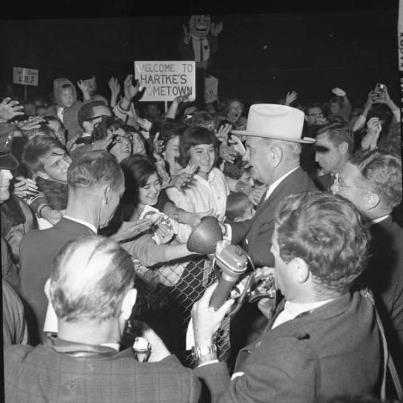
Old New York Newspapers Found in Walls of Old Leonard Home.....1964
Not sure of the address of this home, but I believe the Leonard in question is the old historian of Mt. Vernon of the 19th century. The house was said to be a local landmark built in the 1850's. While being razed for the owners William Keck and Clarence Miller several copies of the New York Independent were found. Issues dated back to March 15 and May 25, 1876 and March 29, 1877 were found between the lath and studs of the old home. One advertisement in the paper showed a Winchester model rifle, "perfect for those living on the Indian frontier."
Old New York Newspapers Found in Walls of Old Leonard Home.....1964
Not sure of the address of this home, but I believe the Leonard in question is the old historian of Mt. Vernon of the 19th century. The house was said to be a local landmark built in the 1850's. While being razed for the owners William Keck and Clarence Miller several copies of the New York Independent were found. Issues dated back to March 15 and May 25, 1876 and one of March 29, 1877 were found between the lath and studs of the old home. One advertisement in the paper showed a Winchester model rifle, "perfect for those living on the Indian frontier."
Mt. Vernon Pay Homage to Slain President Kennedy.....November 1963
I still cannot believe we played a varsity basketball game the night of the President's death, but we did. Mt. Vernon finally rethought its policy and suspended school that following Monday. Mt. Vernon Milling Company closed as well as the Exylin Company, General Electric, and Babcock & Wilcox. Banks and the post office also closed their doors. The American Legion and the Elks Home did not open and Civitan erected flags, with black ribbons donated by Roth's Department store flew at half-staff after being hoisted at daybreak. Many churches open for prayer and special meditations. Battery B of Mt. Vernon took part in the State's tribute at the War Memorial in Indy when ten enlisted men and Captain Bill Loehr joined other units in firing a 21 gun salute. Several days of mourning and as we stayed glued to our TV sets watching on live TV Jack Ruby rush in and kill Lee Harvey Oswald as he was being transferred. I watched as did the nation almost all the coverage until the President was laid to rest at Arlington Cemetery. The world changed dramatically at that point in time in Dallas, Texas.
September 1963
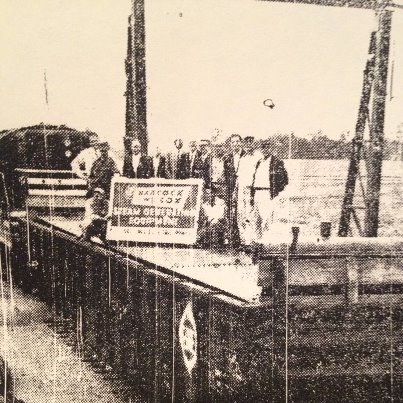
First fabricated material from B&W rolls out of the plant on railroad car bound for an electric power co-operative in Arizona...
Civitan Flags on Veteran's Day.....1963
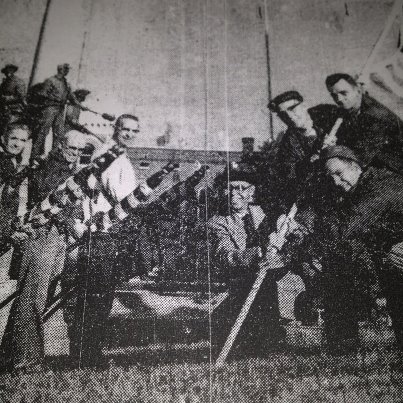
Mt. Vernon Screw Factory.....1963
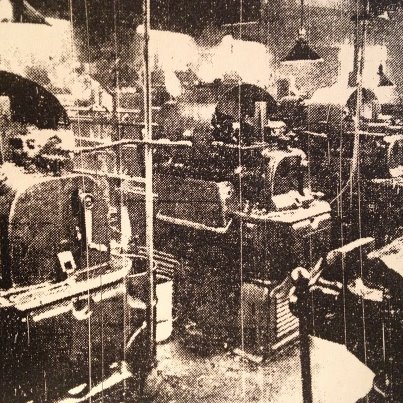
Our New School by Jewel Burris.....1961
"As I sat up there before the crowd; I couldn't help a feeling proud. That I, an uneducated man, this massive school had helped to plan. Proud too, of students and their pride, of this fine school, they couldn't hide. Proud of Mr. Bryant and his great band-about the best in this free land. Proud of Miss Lawrence and all her troops; seldom have I heard a better group. Proud of Mr. Novak and his teens so fine; would that they all were mine. Proud of Mrs. Allen, the way she can sing; My, oh, my how the tones did ring. Proud of the faculty most of all. Without them, education soon would fall. Proud of Mr. Price who set the pace, not knowing the criticism he'd have to face. Proud of the ministers, their prayers to God. Have led us along the paths we've tread. I could have stood and yelled aloud! People, I'm really and truly proud. That I, an uneducated man, this massive school had helped to build."
Bobby Kennedy speaks at the Courthouse, September 1960.
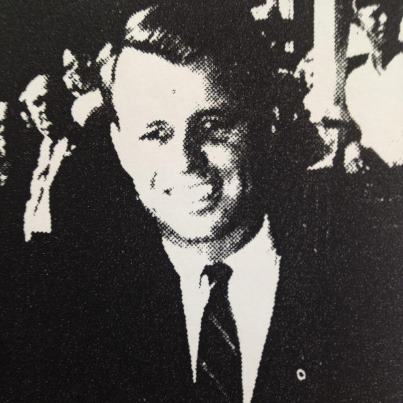
8:16 in the morning and spoke for about 20 minutes before heading to Evansville, Rockport and Jasper. He was introduced by Rep. Denton and spoke on east side of courthouse. He spoke on the issues rather than "What church my brother attends on Sunday." Kennedy told a crowd of 250 that his brother would follow an "absolute principle of the separation of church and state." He was given an official escort into Mt. Vernon by County Sherriff Edmond Rutledge at the invitation of County Chairman Loren Johnson. He departed for Evansville at 8:47 a.m. Chairman Johnson praised the excellent turnout on short notice and the early morning hour and said that was "evidence of Democratic enthusiasm in Posey County." In November however; Nixon defeated Kennedy in Posey County 5369 to 4457.
On September 1, 1960 E.B. Schenk Hardware at 208 Main Street celebrated their 90th anniversary without ceremony
The firm was founded in 1870 by Eberhardt B. Schenk an early influential citizen of Mt. Vernon. Schenk started in his father's hotel business for a few years at the old Union Hotel but then became engaged in the pump and steam pipe business keeping stock of stoves, tin and hardware. Good Democrat.
Echo 1 in Local Sky.....August 22, 1960
Back then we were fascinated by space. People ran outside to view Sputnik and we watched all the Gemini space launches starting with monkeys and then Alan Shepard's short trip. That summer the papers told us when objects in space would appear like: Look to the southern horizon at 2:45 a.m. This communications satellite made six passes over the Tri-s State area and the Democrat office interviewed people as to what they saw. "It looked like a big star with the naked eye." Thrilling wasn't it?
Baseball Hits Auto...Mailman is Injured.....July 1960
Benny Newman, 35, a substitute carrier of the Mt. Vernon post office had a glass particle removed from his eye at the office of a local physician after a baseball had shattered the windshield of the post office truck he was operating. The mishap occurred at College Avenue and West Eighth as Newman was picking up mail from collection boxes. The ball in play was by a group of youngsters and hit the windshield of the truck. I bet they all ran a dozen different ways.
Dawson's General Store - Solitude 1960's
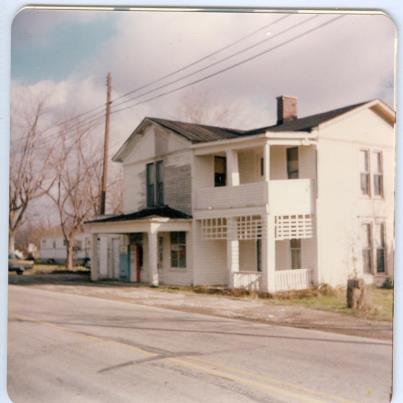
"Me and my good Buddy Weiser".....1960's
"Now this is a story about a man named." well, I can't tell you the name, but he was a prominent school teacher back around 50 years ago. You see it was New Year's Eve. The daughter of this teacher wanted to have a few friends over to celebrate. "No party young lady!" Finally, he came around; but, "No booze!" ..."Yes father, you and mom have a good night out." Soon as the door shut, kids started arriving and of course -with booze in hand. During the evening someone got sick and puked on a throw rug. They quickly put it in the washer and afterwards were going to put it in the dryer as her parents were on their way home earlier than expected. Opening the dryer door they found it was loaded with alcohol. The daughter was in panic and thinking it was her friends, she took it all and threw it into a nearby cornfield. Now here comes dad and he realized that his stash was gone he thought he had hidden and he blew his top. I wonder if he ever got it back.
Pony Express Rides Again.....1960
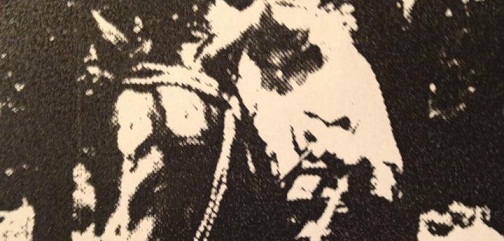
That summer the Mt. Vernon and New Harmony post offices joined in the observance of the centennial year of the Pony Express with a unique show. Mail bearing commemorative postage stamps was delivered starting at Smith School and was escorted to both post offices by the Mt. Vernon Community Saddle Club. The rider shown here is Warren Kishline from Mt. Vernon and the other was Thomas Hickman of New Harmony.
Balloonist at 4H Fair.....1960
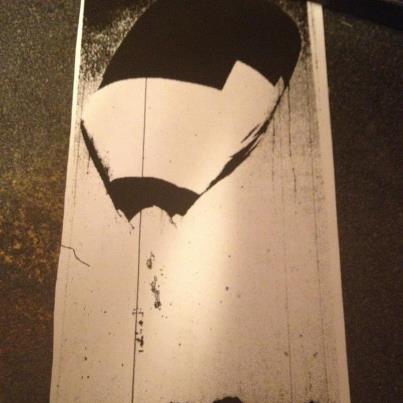
For a hundred years in the papers I have read of these at the fairgrounds. In 1910 a balloon burst and a man fell to his death in Mt. Vernon.
Major George Kimball Views President Lincoln in Death.....1865
Only a small amount of time existed between Appomattox and the assassination of President Lincoln, but a local Civil War soldier was a witness to one of the darkest hours in American history. As a young man of 22, Kimball caught glimpses of the grief as the thousands tried to intercept the funeral escort from the national capital with the body of the martyred president. In Indianapolis the column was military and civic headed by Mt. Vernon General Alvin P. Hovey chosen to represent Indiana to lead the throng to witness Lincoln at the capitol building in an unceasing rainstorm. General Hovey was in complete dress with military bearing. At the capitol rotunda the body of the President was laid upon its bier at the side and above an improvised platform of which people would pass by to view the body. Kimball stood in the rain, helpless from the elements and was approached by an older cousin of his, Major Jesse Walker of Evansville, who was "aide de camp" to General Hovey, and had in hand the details of the viewing. He asked Kimball if he would like to sit in a chair beside the body to which he consented. He was permitted to remain nearly two hours to witness the depicted look of the silent throngs of people passing in review without a sound. Two blue coated soldiers bearing arms with fixed bayonets stood on each end of the casket. The casket seemed to be some seven feet in length. Lincoln's body was in full dress, plain black. "The eyes were sunken deeply as if at much loss of vital blood at death. The limbs were long and slender, hands large and bony, veins not much distended. The facial features were somewhat drawn from natural causes, a small mole in the crease of the right cheek, the hair dark brown. I cannot recall the cut of the beard." Kimball saw only one demonstration and that was of a "colored" woman of middle age, "who gave way to much emotion and loudly exclaimed, "Oh Massa Lincoln" and attempted to pause, but was urged on. Kimball in 1933 at age 90 gave an address to the Mt. Vernon Kiwanis Club about what he saw as a young man. "To us who lived contemporaneously in that period it seemed crucifixion of a martyr for and to humanity. It was his destiny." The New Harmony Register in May 1868 said on the very morning Abe was assassinated, his son Robert Lincoln came into the room with a portrait of General Robert E. Lee in his hand. The President took the picture, laid it on the table before him, scanned his face and said, "It is a good face of a noble brave man. I am glad the war is over at last. I trust that the era of good feeling has returned with the close of the war, and that henceforth we shall live in peace. "
1950's
Grade School Memories.....late 1950s
Teachers were the only ones allowed to use a red pencil and speaking of pencils I loved those bright colored pencil boxes with the ruler and a sharpener at one end. That gave way to cool cigar boxes for crayons. Remember those large ...no huge bottles of paste? I can still smell them. Valentine's Day you put valentines in a decorated cereal box...good stuff right there. The girl I liked was younger than me. I put one in her home mail box. Her mom gave me her picture in a baton twirling outfit. Now that's a memory! I was a fair yoyo guy in school, but better at jax or is it jacks? Anyway, that's a strange thing for a male to admit to, isn't it? I was a patrol boy and very good pole vaulter with that cane pole. My favorite teacher with Gerald Jeffries Sr. I also remember, Lorraine Zimmerman, Miss Boatman, Mrs. Hall and Mr. Root and a Causey I think. I liked sliding down the halls of Hedges with my taps on the bottoms of my black engineer boots. Learned I couldn't dance...stepped on somebodies toes ...not sure who it was now. Always thought it was Sharon Rowe, but it was a long time ago, memory has been repressed because of the embarrassment. I won't ask her to dance at the reunion, but keep my head down, even though she has a wonderful smile.
Workers Apply Finishing Touches on Wabash Memorial Bridge.....June 1956
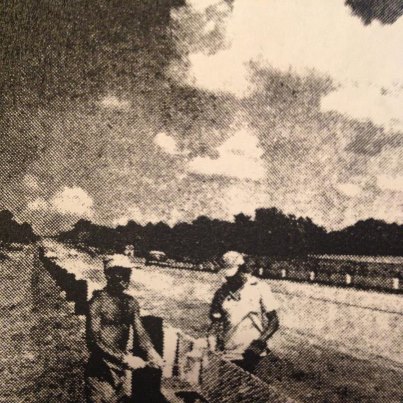
The next month the bridge would be opened connecting Illinois to Indiana with a great parade. From this moment industries like General Electric and Babcock & Wilcox would find us more attractive for jobs. The less we became isolated and the improvement of the Highway 62 a decade or so later, meant the end of a prosperous downtown sadly.
LaDuke Accepts Award at White House.....1956
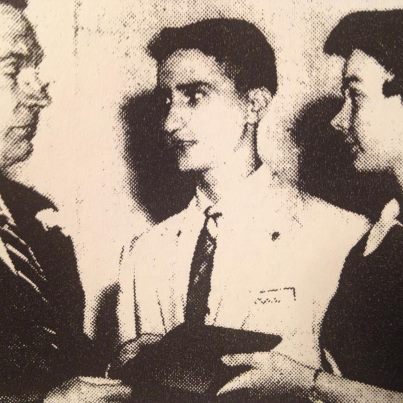
Jeanne LaDuke, a Mt. Vernon movie star and now receiver of the highest award ever given to a Posey County resident in the field of youth leadership. Jeanne was named the first place winner in the girl's division in the sixth annual youth leadership contest of the Benevolent Protective Order of Elks. The first place in the boys division went to Joe Pendergraft of Joplin, Missouri. She received the award from Bernard Shanley, secretary to President Eisenhower in a White House ceremony. There were over 55,000 contestants in all 48 states in a contest to encourage America's junior citizens to develop their talents of leadership. The two winners received their awards and a $1000 U.S. Savings Bond. Ike was supposed to have given the award but was hospitalized. The two winners were selected from twelve finalists by three state governors. Jeanne had been active in church groups, school clubs, girl scouts, 4H, winning state championships in 4H. She was the highest scoring girl in intramural high school sports, received two band letters and was varsity cheerleader for three years.
"Buy Candy" Umpah, Umpah.....1956
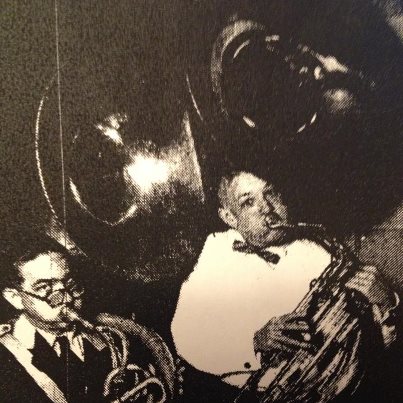
George Tomlinson and future Republican congressman, Joe Deckard play the old Sousaphone and the new horn the school wishes to buy in a candy sale to finance the purchase.
Sometime in the 50's
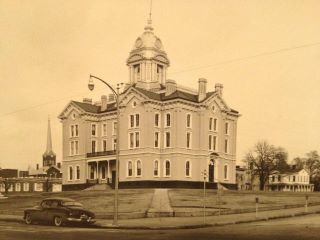
WPCO is "On The Air".....December 1954
Erection of Mt. Vernon's first radio broadcasting station was completed and it was granted a license by the FCC in Washington for a 1590 kilocycle broadcasting station of 500 watt power, daytime only with fifty mile radius coverage. Under favorable conditions you might get 100 miles with a tower 195 feet high and employing around six people. The letters PCO were for Posey County and were assigned at the owner's request. The W designates location east of the Mississippi River. West of the river the letters start with K. My uncle Ken Kessler worked there getting his start in radio and made a long career of broadcasting.
Oliver's Jewelry Store.....December 1954
Job Oliver and his wife had the grand opening of their new store at 220 Main Street. Following graduation from the Southern College of Watch Making at Memphis, Tennessee, Oliver, a world war II veteran on September 6, 1949 opened his jewelry store and watch repair shop at 118 West Fourth street in quarters occupied jointly with Robison's Men's Wear. The two firms moved in August 1951 to the Leonard building at Third and Main Streets. Expansion of both firms necessitated separate mercantile quarters for both. The building housing Oliver's was completely rebuilt on the interior and a modern front added. The sale to Oliver from U.T. Fox brought to an end 40 years of watch making and repairing by Mr. Fox. Fox first came to Mt. Vernon twenty years prior opening a grocery store with his watch repair bench. Three years after he moved to Main Street.
Mt. Vernon Indians Defeat Texas Cow Girls 64-58
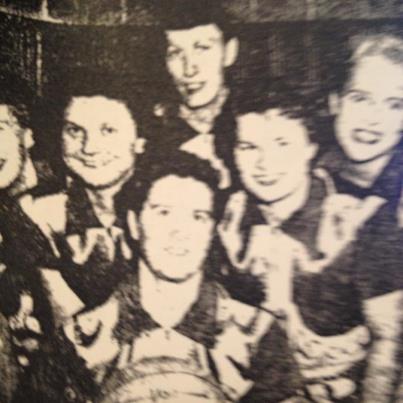
Heralded as one of the nation's most colorful professional women's basketball teams, playing out of Bismarck, North Dakota, they lived up to their advance billing before a packed gym against the undefeated Mt. Vernon independent team. "Technically, the game was supposed to have ended in a 64-64 tie as the Indians were leading 64-58 when Manager Dempsey Hovland put on a dance record on the phonograph and the Cow Girls grabbed the Indians and started dancing out on the floor while the sixth member of the team, Joan Rupp, took the ball and scored three times unmolested, but they did not count." The visitors appeared on the floor to take their warm-ups in 10 gallon Stetsons, cowboy boots and two guns swinging at their shapely hips, but shed their cow girl duds when the game started. The Texas Cow Girls have played the Minneapolis Lakers several times and have made a movie short with them including the great Laker...George Mikan. They were founded by the former manager of Jack Dempsey of boxing fame. Florence Holder led the Cow Girls with 22 points. Gary Farris and Jackson Higgins led Mt. Vernon with 14 and 13 points. During the game, Bob Wagner was roped by the Cow Girls as they chased him all over the gym and Jesse Walker played part of the game with a cow bell tied around his neck The game was played for a benefit for youth activities. Other Mt. Vernon players were: Weir, Brauser, Huey, V. Dickens, Meinschein, and Benthall. This game was in November of 1954.
Mt. Vernon Locker & Packing plant on fire....January 1954
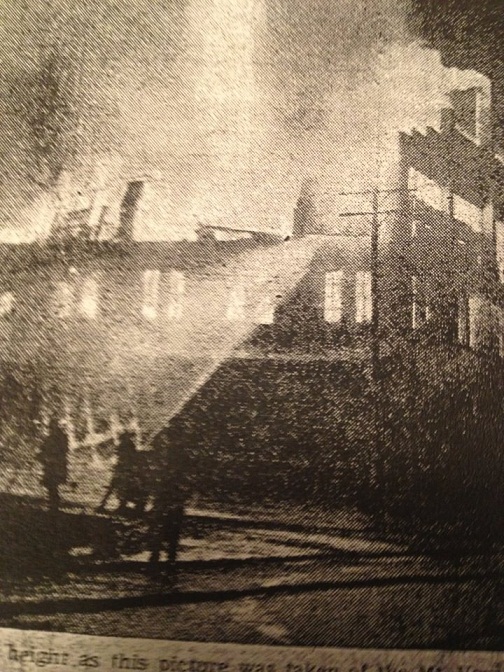
On the 300 block of West Third Street once stood the Mt. Vernon Locker & Packing Company. A fire originating from the basement from a stoker-fed coal heating furnace, it spread rapidly through the interior wood framework and destroyed the 14,400 square feet of floor space. Only a few jagged walls were left standing and they were pulled down. An estimate of the loss was $80,000 of which $35,000 in contents. The contents included custom butchering equipment, 580 individually rented lockers, 450 of which contained stored food of large quantities including turkeys from Uebelhack Farms. Six persons were employed at the firm Mt. Vernon's semi-volunteer fire department with three trucks fought the fire along with about 20 townsmen who aided. This fire came just three weeks after a $60,000 fire on lower Main Street. Company was partially covered by insurance.
Excerpts of Letter to Editor on Road Safety.....1954
A letter in the local paper signed only "I'm a Driver," spoke of another bloody weekend on state highways. "I saw something in the paper the other day about asking for raising the already too high gasoline taxes from six cents to eight cents to pay for more state troopers. This is not the answer to the traffic deaths on our state highways. Take, for instance, Highway 62 from Mt. Vernon to Evansville. Did you ever start through one of the first two bridges and find a gasoline transport bearing down on you from the opposite direction? Yes, a swerve in either direction would result in sudden death. This goes on all over the state, day in and day out. There is not a culvert between here and Evansville that hasn't had the banister knocked off or is still off. Why? Because the Highway Department has not kept pace with the times. These bridges and culverts were built during the Model T and A days. Of course, the Highway Department will say, no money is available. It is none too early to start widening the bridges before more traffic than ever is turned loose on Highway 62 when the Wabash Memorial Bridge is completed. Let's start now to improve our roads and deaths will decline." Ike in the late 50's started the interstate highway programs allowing us to bypass cities with more lanes and higher speeds. Highway 62 became 4 lanes in the early 1970's eliminating the travel over hills and narrow bridges. Highway 69 to New Harmony is now a wonderful road so different then the death trap it was of my youth, and you can now get to Poseyville without making right turns around every farm thanks to I-64.
Frozen Slop Buckets is Collection Problem.....1954
Cold weather came and as usual being a garbage man became more difficult for collector Harry Hardin. Hardin appealed to housewives to drain their garbage to take out as much moisture as possible before putting it in the slop pales. "Those were the days." Dad had a slop bucket on a pole so animals could not get into it easily and it was right next to an old barrel that we burned trash in. I loved taking out the trash and burning it. A kid with matches having a good time. We burned leaves too. I always did like the smell of burning leaves in the fall.
Auto Stalls, Hit by Locomotive, Dragged 20 Feet.....1954
A L&N railroad freight train hit a Mt. Vernon motorist at the Locust street crossing and the occupant of the auto crawled from the wreckage. James Schaeffer, 33, of East Grant failed to see the train as he approached the crossing traveling north. The train had checked his speed preparing to make a stop at the Mt. Vernon yards. The auto, a 1946 Nash Rambler was demolished carrying the occupant inside for twenty feet down the track. Mt. Vernon Police said that the Schaeffer's motor vehicle stalled on the crossing track.
Jerry Thompson Hurls No-hitter vs Savah Indians.....June 1953
Fireball ace Jerry Thompson of the Mt. Vernon Exchange Merchants set the Indians down without a safety in a 25-0 victory at the Farmersville Diamond in the Posey County Amateur Baseball League. Thompson struck out eight, but walked seven and hit one. Bill Bourne paced the 19 hit attacks hitting for the cycle plus a walk. Gary Farris was two for two, Jesse Walker slammed a homer and a double with two walks, "Chummy" Jeffries had two singles as did Thompson. Johnny Johnson added a triple.
City Extends Mail Service to New Areas....1953
The Post Office granted permission to begin delivery of mail to the 1100 and 1200 blocks of East Second Street, the 200 block of North Edson and the 200 block of North State Street, John W. Brown, acting postmaster announced. Patrons of this area until now had no delivery service available and received their mail in General Delivery at the Post Office and some rented boxes. To get mail however, each individual house must meet certain requirements....having a mail box or mail slot, street numbers visible from the street and an all-weather walk from the street to the house. The walk does not need to be paved, but should be of such construction that the carrier can travel over it in all types of weather safely and conveniently.
24 hour wrecker service.....1953
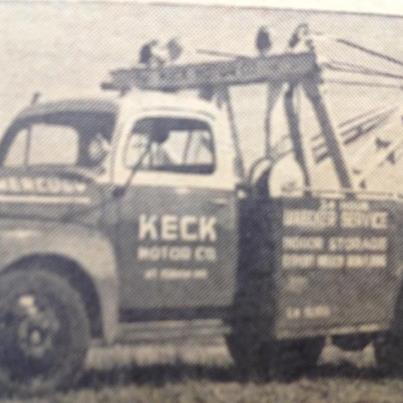
Frank Fessenden Steps Down as Scoutmaster of Troop 81....1953
Without fanfare, "Pop" stepped down as scoutmaster of Troop 81 after 28 years. He was there at the beginning of the troop sponsored by the First Methodist Church. Ray Digman became his successor. The decision was a hard one for Mr. Fessenden named, "Pops" by his boys over the years. "Scouting is primarily an outdoor program and even a scoutmaster grows old to the extent that he can't tramp over hill and dale as he once did."
Life Story of Mt. Vernon Native, Alvin Hovey, is Published.....1952
An autobiography of former Indiana governor, Civil War general, congressman, and minister to Peru was included in the 1952 Indiana Magazine of History. The autobiography was found in a collection of papers which stayed for years in an iron chest in a private home in Mt. Vernon. Indiana University, who writes the magazine, acquired the papers through the efforts of Lloyd Menzies Fitzhugh of Chicago, and Mrs. Esther Leonard and Mrs. Charles Johnson of Mt. Vernon. It was introduced in the magazine by Elfrieda Lang, formerly of Mt. Vernon who was the assistant editor of the quarterly magazine. Hovey was described like so many of that time, "born in a log cabin and by his own determination came to fame." He was one of seven children and he wrote of his father, Abiel Hovey as a wealthy merchant of Vermont who was reduced to poverty by the War of 1812 and came to Posey County to make a new start. "Here, Hovey wrote, with the weight of his misfortunes, and a broken constitution, he passed his life in comparative obscurity, and died in 1823, leaving my mother with the rich legacy of seven small children, and nothing to eat." Shortly after Mrs. Hovey passed on, "and my five sisters, and only brother and myself were cast upon the world to take care of ourselves." He continued, "Poverty is commonplace, cold and unromantic, and ragged boyhood has but few charms." He recounted hunting expeditions of the wilds of Mt. Vernon, his early reading, and the excitement of a teacher coming to town. This teacher (not named), praised the poor orphaned boy saying that his writing and learning showed great promise. His next important step was meeting Judge John Pitcher, well known lawyer and judge in southern Indiana and Mt. Vernon. Like Abe Lincoln before him, Hovey used Pitcher's books and at the age of 18 became a law student. As a lawyer he worked the first case in the new court house I am told. The autobiography speaks much of his love of law, but also his great desire for "that fairy like child, Anna Lowry." He told of the hopeless gap between himself and this girl, who was the daughter of a wealthy landowner. Relatives believe this to be Mary Ann James, later to be Mrs. Hovey. Well, that is part of the story of the general who died before completing his term as governor and buried near the south interest of Bellefontaine Cemetery.
Nickel Soft Drinks; Except Coke A Thing of the Past.....1951
On a cold day in January Evansville soft drink bottlers with the exception of Coca-Cola raised the price of soft drinks for the first time since World War 1. Pepsi, Dr. Pepper, Royal Crown, Double Cola, Vogel and Hillenbrand are all on board for the increase. Word is that grocers will sell them for seven cents and restaurants a silver dime. Some local grocers were not happy and vowed to store only Coke.
Flaming Meteor Sweeps Night Sky.....September 1950
A meteor landed 250 miles south of Mt. Vernon after floodlighting southern Indiana. Calls were made to the Evansville Weather Bureau and airport just after 2 a. m. Marsha Yockey received excited calls of people who said the light was bright enough to read by. Even the airport tower said the flash outside lasted four to five seconds. Some wanted to know if the light had anything to do with the Korean War or flying saucers. An American Airlines pilot said he saw it too at around 18,000 feet around Nashville. Four states reported seeing it and it was heard when it crashed in four cities in Kentucky. Cairo policeman said it sounded like a car crash. In Madisonville doors and windows rattled by the concussion. A small piece of meteor, about the size of a man's hand was found near Murray, Ky.
The Milkman Cometh....Too Early...Arrested.. ..1950
Anybody old as me that remembers when milk was delivered to the home?.....Anybody?....Oh boy! Anyway this story occurred in Evansville one August morning. In a cloak and dagger, no information operation, Homer Campbell was arrested and fined $1 which was suspended for delivering milk in a neighborhood nine minutes early. A Captain Wardrip;( nice name,) was hiding in waiting for the milkman. Homer was on his way to his regular route when he was hailed down by a resident who wanted a bottle of milk, then another nearby wanted one too. That was too much for Wardrip to ignore. Looking at his watch it was 6:51 a.m. A law dating back before cars when milkmen delivered by horses said, no milk deliveries before 7 a.m. The driver was arrested and taken to the pokey and there his arrest sheet, usually a matter of public record was hidden. The Police Chief was called by the reporter and he was equally mysterious and refused permission to see the sheet. The details never became available until City Court. Meanwhile, Mr. Milkman was taken out of jail and to a small room off the court room. What went on in there nobody knows. Later, milkman pleaded guilty and had no comment for the Press. I wonder if he was asked if he was a communist.
1940's
Giant Pecan Tree Felled for Elk's Addition.....August 1949
A large pecan tree that stood as a silent sentinel for the lodge of Elks since the group�s inception fell to the hands of progress. The stately tree the editor wrote, whose meager autumn crop provided a harvest time pastime to school children and their elders was uprooted by a winch truck following the cutting of surface roots. It stood in the path of the extension westward of the present club's edifice." The age of the tree was more than 100 years. Isaac Woof, then a 97 year old charter member of the lodge and Isaac Rosenbaum, 82, first initiate of the lodge remembered the tree in their boyhood. Rosenbaum said the tree was "good-sized when I was a boy." Editor Leffel went on to say, "Through sun and shade as time ran on, its lofty branches have bent as a benediction over the local lodge of a great American fraternity. It has rustled to the laughter of men drinking deeply at the fountain of leadership. It has stood as a great silent shadow when sorrow stalked the fraternal domain. It has roared its strength and power under the pressure of debate and argument that ever mark the councils and deliberations of strong-willed men. But the end comes to all good things.....to all that live and breathe. Other trees may come and go....new buildings may arise....the march of time move on.....but the leafy guardian of the Mt. Vernon Elks is no more."
DDT Sprayed On MV To Fight Polio.....August 1949
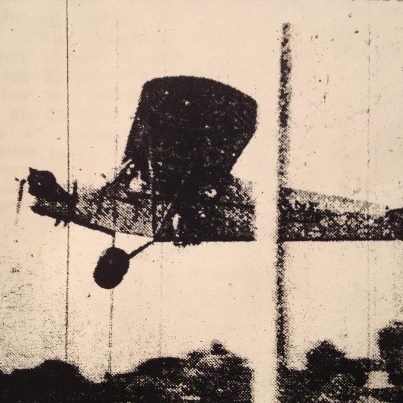
Finances for the spraying were provided by public funds totaling $1,754.15. Doane Aviation released 17 loads of DDT solution from the air and tractor powered ground spraying was done by Hasting Equipment Company and Stephen's Implement in alleys and dumping grounds. The fund was sponsored by the Mt. Vernon Kiwanis Club. Doane flew north and south patterns at low altitude over Mt. Vernon and then crisscrossed on east and west flights. The misty spray could be plainly seen and felt floating to the ground.
Rosenbaum & Bros. Passes From Scene.....April 1949
The oldest Mt. Vernon retail firm ended with the sale of the department store to the Greenberg Mercantile Company of St. Louis. For 95 years, the Rosenbaum family....grandfather, father and son did business generation after generation in Mt. Vernon and served not only Posey County but the tri-state populace. The Rosenbaum building still sits across from the courthouse over 60 years later and the memories still continue; maybe, not for the family with a tradition of honest merchandising and quality, but for the building and the Jewish influence it represented so well.
Pilot Wheel.....1949
The biggest pilot wheel for a steamboat ever assembled at the Keck-Gonnerman Company foundry was completed in February of 1949 and shipped to Vidalia, Louisiana.
Pinkeye, Trench Mouth Near Epidemic in Mt. Vernon Schools....1949
Two highly contagious diseases reached near epidemic stages in April of 1949 and Posey County public health nurse Elizabeth Thomas warned parents to watch closely for symptoms. Pinkeye begins with redness of the eye, a scratchy sensation, a watery discharge and perhaps sensitivity to light. Trench Mouth is a disease of the throat and mouth. It can be spread by use of common drinking cups, common towels, and unclean dishes in public restaurants or at home. Particular attention should be paid to oral hygiene keeping the mouth and teeth in good condition and having the proper diet. Symptoms of mouth infection were red, painful areas, white patches or ulcers on the gums. If symptoms are evident, "See your doctor and or dentist, follow his advice, and keep them isolated from others." All right, you got all that? Good. I think this was about the time the government started putting fluoride in the water to help prevent tooth decay.
Edwin Page: Former Mayor, Dies.....1949
A graduate of Mt. Vernon High School in the class of 1890, he was employed in the office of Rosenbaum & Bro retail store as a young man. Later he was an employee of the First National Bank, then Old First National and for a number of years was assistant cashier. He was first elected as city treasurer. In 1906, the Republican was elected to a term of Mayor of Mt. Vernon. Later in 1920 he was a candidate for Posey circuit court clerk and shattered the Democratic hold on Posey County major offices by being elected. He was re-elected also serving until 1929. Edwin, I guess had other things in mind and headed with his family to California and became a successful citrus fruit farmer at his orchard near Lindsay. He had developed that knowledge of horticulture here in Mt. Vernon as was exemplified at his home garden. Those ideas were put in practice in California and his son Edwin Jr. now manages the orchard. Edwin and his wife Alice, originally of Terre Haute had three daughters and one son. The body of the 77 year old native, born on the fourth of July, was returned from the San Joaquin Valley to be interred in the town of his youth.
No Pitch Count Here for Local Hurlers....63 Strikeouts!.....1949
The most strikeouts I ever heard of locally was 22 in an American Legion game. I once played in a game where we struck out 19 times, and I went 2-2. Thing is, I only hit .147 for that season! This game however is unbelievable. The Farmersville Aces and Owensville played a 12 inning 3-3 tie in Owensville. The game was called by darkness and was to be continued later. No telling what happened after that. Everettt Matsel and Everett Wilson of Owensville combined to strike out 31 Mt. Vernon batters allowing three hits. Mt. Vernon, or Farmersville got four hits and Jim Zink went all the way for the locals striking out 32! Now that is 32 of 36 outs! I think a bunt would be in order here in there, Wow!
Where Am I, Anyway.....January 1948
A new James Bennett city administration took office and asked for suggestions to improve Mt. Vernon. The Mt. Vernon Democrat reacted immediately asking for adequate street signs. "A stranger in Mt. Vernon can do but one thing to find a street here and that is to ask someone. Once in a while you'll come across a street sign. But not often. Those on people's homes are often times obscured by trees or they have gotten so old and battered you can't read them. Let's do something about it fellas!" And so it goes......
Local NAACP Holds Founder's Program.....February 1947
Founder's Day was observed in Mt. Vernon by the local chapter of the National Association for the Advancement of Colored People. William Smith, executive director of the Carver Center in Evansville was the guest speaker. He reviewed the achievements of the NAACP since its organization in 1908 and its future objectives. The organization had 520,000 members and over 1000 branches in various cities. Rev. W.A. Wyrin, president of the local organization gave the address of welcome. The origin of the NAACP was given by Mrs. Hubert Butler. A chorus of the local organization with Miss Kathleen Waller as pianist, and a girls chorus of Booker T. Washington school sang as well as a male trio. Mrs. M.R. Price was mistress of ceremonies and Mrs. Lorene Wilson and Mrs. Milburn Jones were the ushers.
Grandpa Ran a Sawmill......1947
Anna Kelley wrote to the Democrat about her maternal grandfather, Virgil Soper who operated the first steam sawmill on the riverfront and incidentally his great grandson, Nelson Kelly became manager of the Mt. Vernon Milling Company at the same location. Going east on Water Street you come to Owen Street. On the corner to the left was a very old house that was torn down probably in the early 1940's. It had seen better days, but it housed the family of Mr. and Mrs. Virgil Soper, pioneers of Mt. Vernon. Soper introduced the first steam sawmill, located close to the bank of the Ohio River. According to Anna, he moved from a farm, south of New Harmony to Mt. Vernon to school his four daughters and a son. "Schools were quite primitive then, and grandfather and grandmother were both Connecticut Yankees and were much interested in their children's education." The daughters were placed in the girl's seminary at the corner of Third and Store Streets and afterwards were taught at the Brettner Hotel. The "professor" lived in a private residence of Annie Larkin. The younger children attended school in the brick tenement house on Mulberry Street between Water and Second. Anna's mother Helen was one of the children who attended the seminary. Helen was a beautiful lady and she was a favorite for the boys to dance with at gatherings. All those happenings transpired before the Civil War. Anna's grandparents died within nine days of each other in 1859 on their homestead near New Harmony as they moved back later. In old age and aunt, one of the four girls mentioned came to Anna for a visit. She told of the formation of the island in the Ohio River above Mt. Vernon and in plain view of the waterfront. She said, that a boat sank on that spot and the island had its beginning in the wreckage. The ship was full of passengers and she remembered cries for help from those on board. After a bit the people were saved and the passengers were laid out on lumber stacks that belonged to her father's sawmill. Dry goods were also saved and left out to dry. In kindness, the Soper family was given some beautiful material to make dresses for the girls.
Doane Photo.....1947
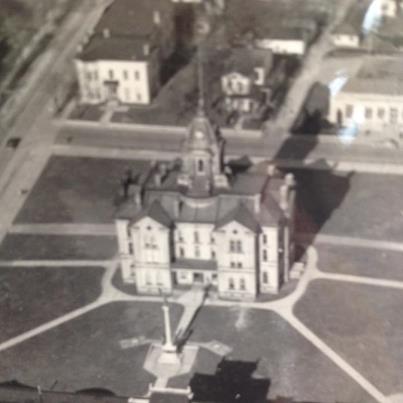
The empty concrete slabs shown are where the cannons were prior to 1942.
New Building Will Replace Old Store.....1947
Original plans for remodeling the building of Isaac Rosenbaum at 412-414 Main Street for occupancy as a Kroger super market were changed. Rosenbaum reached a decision to raze completely the present structure and replace it with a new building. The demolition occurred in March. At first it was planned to utilize parts of the old south and north brick walls in the new building.
MV Grad, Bill Walton at DePauw.....1947
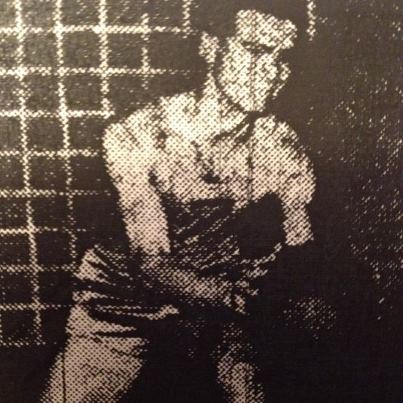
Bill Walton was the leading scorer for Mt. Vernon his senior year scoring 174 points. He went on to DePauw University as a V-12 pre-medic student. During the 1944-45 season, Walton scored 166 points and the team in free throw percentage with a 68.3% at the line. DePauw was 8-7 that season. Bill went the next season to Michigan University, but I do not have the statistics for that season. He returned to DePauw for his senior year and scored 195 points and again led the team at the free throw line with a 72.8% as the team went 16-3, their best in history. He was elected to the Mt. Vernon High School Hall of Fame in their inaugural year of 1985.
Temporary Buildings Being Moved to House Students.....August 1945
After the Central Grade School burned earlier that month, Mt. Vernon was in a bind. The United States War Department donated collapsible temporary buildings, shipped from Sandusky, Ohio by rail to Mt. Vernon. The dwellings were once a part of a dismantled ordinance plant. Kuhn Truck Line transported the buildings to the erection sites adjacent to the Mt. Vernon High School building. George Esche and George 'Jupiter' Payne, school employees assisted the truck firm in unloading. Concrete block foundations were laid and footings poured. School was delayed one week because they were not ready due to delays in obtaining building materials. Grade school pupils at Riley School, MVHS, and Booker T. Washington began school according to the original schedule.
Rev. August E. Binder
Binder came to Mt. Vernon in 1945 and was Pastor of Trinity Church of Christ for 18 years when he retired. He was instrumental in the founding of the Housing Authority of Mt. Vernon and the opening of the Cloverleaf Circle apartments for low income, elderly and he handicapped. He made a half a dozen trips to Honduras with mission work as well as other trips like to the Soviet Union. He called me during the Jimmy Carter era to discuss with me the reinstitution of selective service registration. I had been protesting that position in Evansville and had been interviewed by the Evansville Courier and the Mt. Vernon Democrat. We talked about humanity and not governments, similarities and not differences between people. We went over my opposition to war and the feedback I was receiving. He encouraged me on my stands of conscience and sent me a nice note later in the mail. I appreciated his comments both positive and negative.
Life in a Concentration Camp.....1944-1945
Arthur Roos was captured by the Germans at the Battle of the Bulge on December 19, 1944. My father was in that battle also. I remember how he said it was so cold and snowy. Roos was put in a boxcar and sent to a camp called Badorb and for four days and nights he had nothing to eat. On Christmas evening, the Mt. Vernon native was finally given some nourishment: part of a can of meat and a slice of bread. He was continuously reminded of the lack of food during the almost four months he spent at the camp. The 20 year old said that the typical meal was about one liter of soup. Sometimes during the day you might also be given a loaf of dark bread of which the main ingredient was sawdust. He slept on the floor in temporary quarters for maybe three weeks until he was assigned to barracks that had bunk beds three tiers high. Of course there was no source of heat that winter. Besides the lack of food, heat and freedom there was an abundance of lice and fleas and cleaning oneself without soap was difficult. Prisoners exercised to keep up morale and spent their time talking, reading, playing cards and thinking of anything other than their conditions. On Easter Sunday, 1945, an American tank crashed through the camp's gates and freed the prisoners. They were taken to a field hospital and then transferred to a general hospital. By Mother's Day he was home for a brief stay but returned to duty. Ironically, he was sent to Ft. Lewis, Washington where he guarded six German prisoners of war. On Thanksgiving Day he was discharged and he returned home. He later moved to Missouri and became a optometrist.
Coliseum Guns and Courthouse Cannons March to War.....1942
In Volume 3 of my "Ramblings" I touched on the two cannons and two artillery guns that were sacrificed for the war effort in 1942. During a period of great sacrifice and salvage drives and at a time the war was uncertain, Mt. Vernon went all out. The two artillery pieces were 37mm guns of French type which were of World War 1 design. These along with the 5000 pound cannons of Spanish American War design were donated by the county commissioners. The cannons at the square were placed in 1907, even predating the Soldiers and Sailors Monument. The date of the manufacture of the cannons was either 1855 or 56 as my copy is so faded I can't make out the last digit.
Confederate Dagger Given to Historical Society....1941
So many items have been lost from us when the Coliseum was robbed storing many Posey County artifacts. The above mentioned dagger was taken from a confederate soldier by the late Sylvester Kirk when he was 20 years old as a member of the 10th Indiana Calvary and upon his death as commander of the local G.A.R. it was presented to the Historical Society by his daughter Mrs. Charles Joyce.
What One Might See On a Typical Workday Morning.....1941
The down town porters putting luggage into the hotels, women walking toward the Garment Corporation plant....oil field workers coming out of the Heidelberg Cafe...early bird shoppers at Stinson's. There would be the usual hustle of delivery trucks, men in conversation over at Gentil's, women reading the war news in the newspapers and people waiting at the bus station for Bert Fowler and his Evansville bus. The town would be bussing as sidewalks in front of their stores would be swept and men would be tipping their caps to the ladies. Grab a paper at the Maurer News Agency, put it under your arm, light a cigar and head to the office. Have a good day!
A Dog & a Groundhog.....June 1940
Today's short story is about a visitor to Mt. Vernon from McLeansboro, Illinois and a local man who had enjoyed a day in Point Township and were heading back to town. Within a few miles of the city limits, they saw a groundhog, and almost at the same time so did the family pet and with a mighty leap the dog jumped from the auto and was hot on the trail. The "weather animal" immediately darted into a drain tile and the dog was a close second....both animals went farther and farther into the drain tile, despite the warnings and the calls to the dog by the two men. Finally, about a quarter of a mile into the tile the dog was stuck! Henry Young and his friend, Allen Adams had to dig the tile up to rescue the dog. The next day they went back and worked five hours replacing the dirt they had removed...and as far as they knew the groundhog was still in the land of the living.
Gentil Goes 12 Innings to Beat Michigan 4-3.....May 1940
Dale Gentil, former Mt. Vernon graduate and now ace of Indiana University gave the Hoosiers their first Big Ten triumph of the season when he went twelve innings allowing eight hits to the Wolverines. Dale later played in the minor leagues throwing one no-hitter.
Strawboard Company Razing.....April 1940
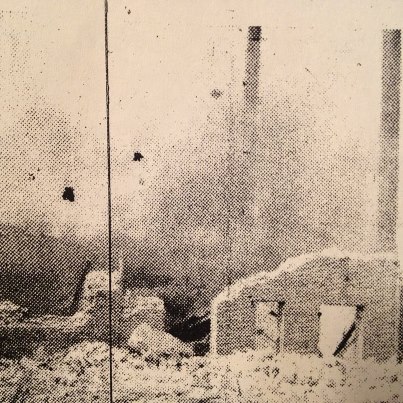
Photo shows the remains of the former rotary room of the old Mt. Vernon Strawboard Company which was being razed in order that the site could be occupied by a pipe line terminal of the Texas Company. 24 hours later, a fire developed in the old building damaging much of the salvage materials. Explosions were frequent tat week as dynamite was used to destroy the building and the largest smoke stack then in town. Once a leading industry in town, now gone...progress.
Bare-handed Catcher from the 1880's Visits Mt. Vernon.....1940
Hudson Park Jones, known as "Hud" was a star catcher on the Mt. Vernon Blues baseball team back in 1881-1885. He came back to see the old town for the first time since 1924. Mentally alert and physically active except for a limp where a mule kicked him he dropped by the Western Star newspaper office to talk baseball with old-timers. The 77 year old started playing at the "Commons" on the west end of town. Other members of that team were Al Weisinger, pitcher and pioneer undertaker; Dick Jennings; Paul Howard brother of Silas, shortstop Bob Sparks and then there were the Heager boys and Harry Weisinger. This team it was said was the best in this section of the state beating the likes of Evansville, Uniontown and New Harmony. These were the only teams playing back in those days. "Hud" and his battery mate, Al Weisinger were just like brothers and Hud's deep affection for him was evident as he told his stories. "Nobody south of Terre Haute was comparable to us," he remarked. He first started catching Weisinger with his bare hands! Now that was common practice back then and no shin guards and no mask! Can you imagine? I love baseball as much as anybody, but no way would I do that for a month's wages. Later he used a glove...not a catcher's mitt but a regular working glove with the fingers cut out. He used a rubber mouthpiece similar to a boxer to protect his teeth, but nothing to protect his face or head. Like I said, he must have been a little "off" to start with. They call the catcher's equipment the "tools of ignorance", but he didn't even have the tools!
Manus Bishop Looks Back to Depression.....1940
Back in 1927, "Bish" opened his pool hall and lunch room in the St. Nicholas building at Third and Main Streets. During the years ahead he paid rent to five different landlords and during the depression he was the only occupant of the large three story building by which in 1940 again had every room filled. During that time Manus had difficulty in securing coal which he had to fire, being the only occupant and that he secured a quantity of old automobile tires from the former Kenneth Cartwright garage, which he used for fuel!
1930's
Some Items Once Stored in Posey Museum of Coliseum Now Stolen.....1939
In a small room on the first floor of the Coliseum, relics, historical documents, pictures and antiques were once collected. Many of these objects are now gone due to a break-in which must have occurred in the 1940's. It had to be such a disappointment to all who donated their objects for this to happen. There were over 1200 articles housed in large cases. The cased devoted to war relics contained some from the Revolution, War of 1812, Civil, Spanish-American, and World War. "Most interesting was the effects of Mt. Vernon's three Civil War generals, Hovey, Harrow, and Pitcher, as Mt. Vernon was the only town in the United States which sent three generals to that war. I know there were daggers and a civil war trumpet on display as well as a dress uniform of Major George Washington Kimball with a plumed hat and a saddle blanket. There was also a G.A.R. flag on display. Kimball also gave a sword presented to him by Co. John Mahan for valorous service in the battle of Richmond, Kentucky. There was also a large doll collection; an assortment of historic rings from other countries, an exhibit of Indian and mound builder's relics; a case of needle-work laces, homespun sheets and blankets, historical deeds and grants, old pioneer furniture and antique badges and medals along with early American dresses, bonnets and shawls. Hanging on the walls were portraits of the three generals along with a portrait of Charles Frederick Leonard and his wife, grandparents of the late John Hay, secretary of state under Teddy Roosevelt and other pioneer leaders of Posey County. Mrs. Rudolph Schultz was the curator of the museum. Such a loss!
Around the Town.....1939
Excitement and giggles on Main Street one January morning as a half grown goat and a large black dog ran down the street. "Old Blackie" was having a swell time nipping the goats heals and barking when "Billy" decided to go on the offense and made a direct head butt to the canine's mid-section which sent him yelping with his tail between his legs. The animal wasn't hurt, but it sure was a topic of conversation in front of the pool hall.
Local Aviators Observe National Air Mail Week.....May 1938
Mt. Vernon "fly boys", Dave Alldredge and Dr. W. B. Challman had a part in the celebration. The airplane a "Waco A" of 210 horsepower with a Continental motor was purchased a week ago by the two men through the St. Louis Flying Service. The plane has a cruising speed of 120 miles per hour and a top speed of 140. It can carry the pilot and one passenger, both seated in the same seat. The plane had a red body, silver wings and a silver speed ring around the motor. Dr. Challman had only recently become an efficient pilot. Alldredge had been flying for seven years and had enough hours in the sky to qualify as a transport pilot. The Grabert farm, two miles east of Mt. Vernon on Highway 62 was used as the landing field. The two took the air mail from there to Poseyville and New Harmony delivering a mail pouch with 900 pieces of mail.
Ice Men Looking well, "Cool".....April 1938
Delivery men of the local Consumer's Ice Company left the factory in their new uniforms. They looked all "spic and span" with their tan trousers, shirt, jackets and caps. On the cap was the company motto, "Save with Ice." Manager V.D. Smith remarked, "I believe the uniforms are attractive enough to cause people to purchase ice whether they need it or not!" V.D. wanted his drivers to be distinguished from other delivery men in town. Good idea Mr. Smith, now do something about your initials! Afterwards ole V.D. had an outing and fish fry for his employees and their wives and friends at the club house at Hovey Lake.
Tri-State Gets Preview of Six-Man Football.....April 1938
On a Thursday afternoon before a diversified crowd of 300 local and out of town fans at Athletic park in Mt. Vernon Coach George Ashworth divided his team into squads of Red and White and played a regular game with shorter quarters. The Reds won 19-14. It was Mt. Vernon's first football game since the school dropped the regular 11 man game from the Athletic program in 1932. Heading the visiting delegation were coaches Hurst Livengood of Dale, Sidney Amy of Rockport, Ivan Hollen of Owensville, and Herdis Kolb of Poseyville. These four schools will have teams in the Pocket Athletic Conference next fall. Coach Livengood was accompanied by five of his Dale Golden Aces while Coach Amy had several of his gridders with him. The playing field is 40X80 yards and the ball must be passed either forward or laterally by the back who first receives the snapback from center. All players are eligible to receive passes. In six man football the offensive team is required to make 15 yards in four downs instead of ten in the 11 man sport.
Island Queen Excursion.....1938
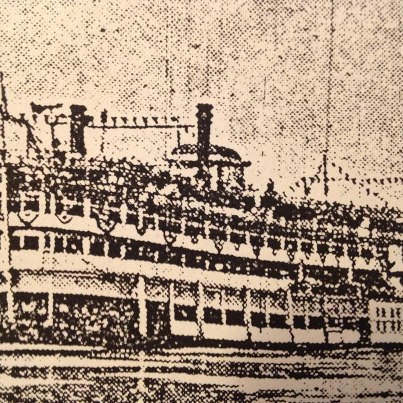
A moonlight dance excursion sponsored by the Tri Kappa sorority aboard the steamer Island Queen on the Ohio River. How much more romantic could it be? At 8:30 in the evening those who bought fares for 55 cents at the Fogas Drug Store climbed aboard the 286 foot steamer for a cruise where one could dance to the rhythms of the Clyde Trask 14 piece orchestra or just sit back and watch "the rest of the world go by." If you wanted you could play bridge or have a drink and a sandwich on the main deck. The Queen was all steel construction with glass enclosed decks with 36 water tight compartments. There were three separate electric plants supplying power for operation of 7000 lights outlining the boat. The ballroom was near 20,000 square feet of hardwood floor for dancing. Unfortunately, the Island Queen had two explosions in 1947 and sunk in Pittsburgh killing over 20 people.
Recreation Hall for Negroes Opened.....1938
A "colored" recreation hall for the benefit of the Negro residents of Mt. Vernon was opened at 108 Main Street and is a unit of the Posey County WPA recreation department supervised by Howard Howden. Facilities included ping pong, clabber, various quiet games, and handicraft activities under the direction of Tom Finney. The center now gives us two recreation halls in Mt. Vernon and one in New Harmony.
Store Building On West Side is Razed.....1938
Frank Werking, local contractor and owner of the store building on West Fourth at Chestnut has completed the razing of the structure erected in 1895. Occupants of the store over the decades were the Peter Egli Grocery, the Andy Kemp Music Store, the S.H. Smith Grocery and the Tigo Store operated by Dan Thompson.
Old Trees from Central School Used In High School Industrial Arts.....1938
Two walnut trees of the old forest at Central School had died and Superintendent J.G. Turner turned them into a practical use. Turner had them cut down and took the logs to a mill and had them cut into boards and then stacked in the basement of the high school. There the boys in the industrial arts department were given the privilege of using the timber at its actual cost and make anything desired. Furniture and ornaments for the home soon followed. Many students are making use of the wood after having joined the Juvenile Humane Society. One of the principle objects is to promote kindness and reduce delinquency of children. Here in industrial arts healthy minds are using busy hands. Walnut trees were once very numerous in Posey County but most made their way to markets or were burned to clear farm land long ago. The quality of the wood in Robb Twp. once had 20 acres of forest owned by T.C. Jacquess who produced 75,000 feet of first class walnut timber. The walnut wood was used for rails in fences by our early settlers. If the woodman's axe had not touched some of those forests I wonder what the wood would be worth today.
Santa Drops in by Parachute.....December 18, 1937
On a Saturday afternoon at 1 Pm, Santa is said to have landed on the courthouse lawn by parachute. The event was to bring out a spectacular crowd for one of the heaviest shopping days in Mt. Vernon. The announcement was made by Dave Alldredge, president of the Chamber of Commerce and Ike Rosenbaum, chairman of the retail merchants committee. The contract was signed with the West Wind Flyers of Decatur, Illinois. The role of Santa was taken by Jack Lewis, World Famous parachute jumper. Pilots of the plane were Reg Pattinson and Wayne Parmenter.
Keck-Gonnerman Helping out at Water Works During 1937 Flood.
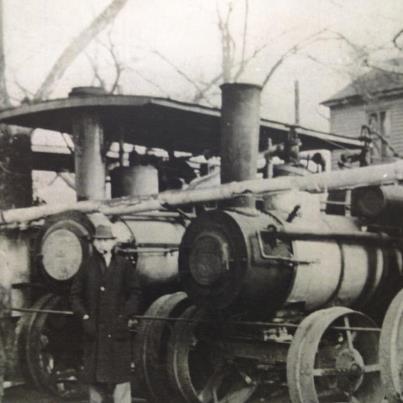
1937 Flood at Water Works. Notice the McFaddin Monument almost submerged.
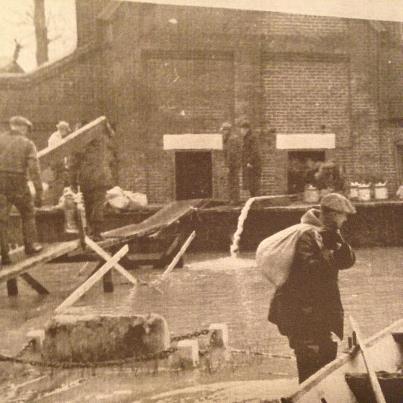
This is the monument that preceded the one just recently removed. I had read of plans for an earlier monument in the early 30's ....I believe it was a goal of a earlier Historical Society. Until this picture and another one I have during the flood , I have never seen it. Do not have pic of the inscription.
1937 Flood at Waterworks
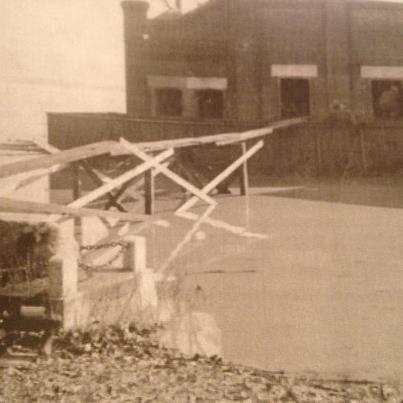
Skating on Thin Ice.....1937
One day Mary Ann Goffinet, 10 and Mary Helen Holder, 11 had a desire to go ice skating in the backwater at the site of the old Tile Factory and they walked into the country with two companions, Martha and Mary Katherine Isham. Mary Helen was first to break through the ice and fell into about four foot of water. Mary Ann hearing her cries for help went to the rescue and she too fell through the ice. The two girls for about twenty minutes fought the ice breaking it in front of them in order to wade out. Half frozen and bleeding from cuts by the ice, the girls made their way to the residence of Mack Curtis where he revived them with hot towels and a warm fire.
Washer Pitching Tourney Results.....April 1936
Simple times bring out simple pleasures I reckon....The WPA recreation department sponsored a singles division for throwing washers at little cans stuck in the dirt at the "courts" at Fifth and Main Streets on a Saturday afternoon that drew over 900 spectators for the various singles and doubles matches held over three days. There were 32 entries in the singles competition for the mythical city champ. The final four advancing were ex-fastball pitcher of the Mt. Vernon Arrows, Walter "Polly" Cusie, Maurice Crowe, George "Jigs" Pfister, and Herschel "Cotton" Aud. In the finals Cusie defeated Aud 2-1 with scores of 23-25, 25-17, and 25-6. Now there is something for River Days...washers and hand churned ice cream.
"Negro" Scout Troop Installed.....March 1936
Troop 2, newly organized unit of Negro boys was formally installed at the Free Will Baptist Church by District Scout Commissioner Frank Gore of Evansville and Robert Stinson, chairman of the Posey County Scout Council.
Sunday Night Robberies in 1936
Burglars were active but received little loot for their booty. Efforts were successful at the store of A. Hartung, the A.A. Schenk grocery and the Herschel Blackburn service station. Attempts were made at Stinson Bros. Dry Goods and the business of Edgar Alldredge. At the Hartung store, the thieves secured maybe $5 from a cash drawer but no merchandise. Entrance was gained by breaking a basement window in the rear of the store and forcing open a locked door leading from the basement to the first floor. Edgar Alldredge noticed the broken window as he drove his car through the alley and notified police around 9 pm. The thieves gained entrance to the Schenk grocery through a rear window in the store room. Locked doors prevented their way to the store proper but merchandise in the store room was not molested. A panel was broken off a rear door at the Blackburn service station and a small amount of coal was dumped into the building, but nothing of value was taken. Police were inclined to believe that burglary might have been a prank. The burglars were frightened away at the Stinson store when John Wesley, "colored" who was firing the furnace, heard the noise at the real basement floor and investigated and noticed three men heading down the alley. An attempted burglary at the Alldredge place was averted at 1:30 in the morning when Alldredge investigated a noise in the rear of his building and saw an automobile drive rapidly out of the alley. Ok guys! "Closed Sunday, See you in Church."
Civil War Memories by Eugene Wilson.....1936
Back in 1861, Eugene was a boy of about ten years of age and in a letter to the Western Star newspaper he recalled vividly many memories of the war years in Mt. Vernon. He could remember the safety operating military units (home guard) forming and citizens holding meetings and passing ordinances for the safety of the community. He said the armory that held all the guns and ammunition were stored in Henry Brinkman's building on the east side of Main Street and at that time known as the James & Lowry Bank. The artillery captain was Jesse Oatman and they had five big brass cannon, three six and two twelve pounders, all brass mounted. These were all housed in the cannon house located at the northeast corner of the Public Square. He remembered where each was placed, one at what was known as the rocks at Oatman's landing, one at the James and Merckey distillery, another was on what was called Haw Hill, just across a ditch from the Water Works is, and two others at what became Sherburne Park. All the talk locally in those days concerned the raids of Morgan and women and children were frightened that at "any moment they would be devoured by John Morgan and his gang." Eugene lived on the corner of Eighth and Mill streets and at night the neighborhood would congregate at the resident of John Bradley, who lived on the southwest corner of the same street. They felt there was safety in numbers. The nights were quiet and still. Nothing was heard but the occasional patrolman on his beat making rounds on horseback. Mothers would peep out the door just enough to see what was going on. He remembers the rumors and of one man who went off with a lantern in Point township looking for Morgan. Wilson said he would be more afraid of wild hogs and turkeys than Morgan back in those "sticks." "It was nothing but ponds, deer, nuts, acorns, and wilderness back then." Wilson remembered the home guard firing their cannons in practice. He and other boys were always after the powder bags to put their marbles in. It was prized very highly and sometimes one of the men would surrender one. He said he remembered Charles Hovey being killed at the riverfront when the guard was firing salutes to a northern victory. Charles was five years senior to his brother General Alvin P. Hovey. The ramrod went through him and knocked him a considerable distance. Wilson said sometime in the 1880's the large guns were dismounted by the street commissioner as he wanted to use the gun carriage in his street work. (My note: I had heard all the guns were returned to the military after the war, but one which was hidden). Anyway Eugene said one of the guns was discarded in an alley beside the Magill Blacksmith Shop on Mill Street and they converted it into their shop and it was still there in 1887 when Wilson moved away from Mt. Vernon.
Violence Breaks Out Again at Local Garment Factory.....1936
Up to 100 strikers and sympathizers congregated at the entrance of the plant on North Main Street and attempted to keep workers from gaining entrance. City police and county authorities were forced to swing fists and clubs to enable workers to enter. The near riot was the second one in three weeks since picketing started at the factory. Injuries were minor and six arrests were made. Chief of Police Basil Cox, Sheriff Charles Frieg, Police patrolmen Burges Bivin and William Davis and Deputy Sheriff Butland Pisley tried to make control of the situation. Those arrested were Mr. and Mrs. Merle Alldredge, John Brown and three for assault and battery were Goldie Burnett, Mrs. Helen Lienau and Otto Uhde. All were booked then released on $250 bond. The city council went to work to adopt an ordinance to regulate picketing to six people registered 24 hours in advance at the city clerk's office. Violations would range from a $10-$300 fine and imprisonment up to 60 days.
Three Bandits Rob, Kidnap New Harmony Bridge Toll Taker.....1936
Three bandits kidnapped and robbed Don Blair, 26, New Harmony bridge toll taker, shortly after 6 PM, Saturday night. The trio bound and gagged Blair during the escape and put him out of their car between Crossville and Carmi, Illinois. Blair freed his feet from the bonds and walked nearly a mile in the January air for assistance. His hands were still tied tightly behind his back and he mouth gagged when he stumbled into Stanley tavern near Crosssville, suffering from the cold. He was hatless and in his shirt sleeves. The robbers obtained between $150 and $200. At first Blair thought the holdup was a joke. Three men drove up from the west and as Blair went to take the toll one of the bandits opened the door and held a gun on him. Then the other two men brought out their guns and told him to get in the car. It was not possible for the car to turn around on the bridge so they drove on the Indiana side and turned around. As they proceeded west on the bridge they picked up the third man who had taken the cash drawer and bound and gagged Blair. During the ride the bandits kept their faces hidden as well as possible and after being put out Blair was unable to get the license plate number, which was a black Plymouth sedan.
Local Spitball Pitcher Dies.....1936
Tim Keeler, 56, whose real name was Thomas Creanens, was a well-known hurler for Mt. Vernon at the turn of the 20th century. For three years, Keeler and Harry Smith, local court house custodian, and one of Posey County's best catchers made up the battery of the local team. Old-Timer says he was one of the best spitball pitchers seen locally and that his famous delivery "surpassed that of "Red" Faber, of the Chicago White Sox, known as the most outstanding spitball pitcher in history. Keeler's temperamental ways it was said prevented him from a big league career. He was at the height of his career around 1906-1911 and passed up so many opportunities to play with professional teams because of his friendships with his teammates and local fans. Keeler whose father died when he was young, took the name of his mother's second marriage, his stepfather. After his playing days he was a painting contractor but always could be seen around the diamond. Speaking of baseball, back then when Tim played, Athletic Park was not here which came into being I believe thinking off the cuff around 1920. Baseball before that was played in many places, but the more important games were either played at the "Commons" where Farm Bureau Co-Op is today on the Westside or the Fairgrounds on the east side. From 1897 for instance we had a game on a Sunday between the White Caps of Carmi and the Mt. Vernon Rabens that drew a crowd around 1500 with a gate receipt amounting to $83. There was a time when Sunday baseball was unlawful, and boys were chased off the diamonds or even taken to jail. Over time, Sunday baseball was the most popular time to have a game and for decades it was a pastime in our community to view the Motts, the Arrows, the Merchants and many other local semi-pro nines.
The Steamboat Washington.....1936
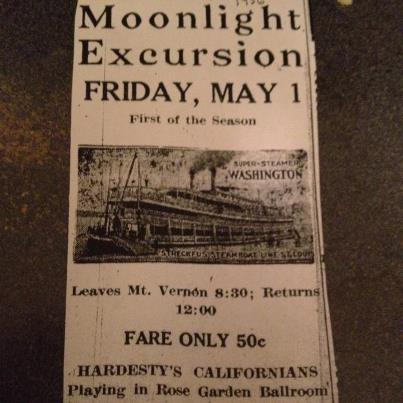
Got Moonshine On a Cloudy Day.....December 1935
The Feds, the State Boys and the "County Mounties" made two liquor raids in Posey County one Thursday back in the old Bonnie and Clyde days. Two men were arrested, and two stills were eliminated and moonshine whiskey and mash were taken. The prisoners were George Bennett, 31, of Point Township and Alfred Morris 23, of New Harmony, both arrested on Mackey Island in the Wabash River and placed in the local jail. A 100 gallon still and 25 gallons of moonshine was seized. That evening another raid produced a 150 gallon still and 10 barrels of mash, but officials waited in vain for the owner to appear in a raid, northwest of Mt. Vernon. The two prisoners were fined $100 and costs and sentenced to 60 days on the state farm.
City Meets Acute Fire Department Need....January 1935
Mt. Vernon finally purchased a pumper. It was amongst the last of Indiana cities of its size to purchase a fire engine. The new truck was purchased from the General Fire Truck Company of St. Louis at a cost in excess of $5000. The old truck we had was to be retained. Tests of the new equipment were made from a barge in the Ohio River and it proved satisfactory. The new pumper, the first ever owned, was equipped with a Hercules motor and capable of supplying pressure for three large streams of water. Lack of sufficient water pressure in time of emergency has been a handicap to the efficient fighting of large fires for a long time cited retiring Chief Frank Fessenden. It was also a "feather in the cap" of the outgoing Mayor E.F. Bamberger administration.
High School Student Injured by Thrown Eraser.....1935
Ruth Smith, daughter of Mr. and Mrs. Raymond Smith suffered an injured eye at school when struck by one of the boys in the room with a blackboard eraser. The accident occurred before 8 am in the "rural section." This was the area pupils went before they were allowed to start the day in the class rooms. A number of boys had started throwing erasers at one another and poor Ruth, who was studying at the time, was accidently struck. She was taken to a specialist in Evansville and it was believed she will not lose sight in her eye. She was sent home to her parents to recover.
I Wonder What It is...The 'X-Ray Girl".....1935
The "X-Ray Girl," a mysterious attraction proved to be very popular at the Stinson Bros. Dry Goods Company. Many visited the store to see the performance without charge. "The mystery was first presented in the ancient temples of China over 2000 years ago and is being presented at the Stinson store in practically the same manner as it was in the Buddhist temples," the paper said. Well, that leaves out mechanical marvels...hmmn...no idea. The attraction came to Mt. Vernon after nine weeks in leading Evansville stores. Anybody got an idea?
Reno, "The Great Magician", Plays the High School.....1935
Edward Burdick, AKA, "Reno the Great, Professor Reno, and The Grand Old Man of Magic" came to Mt. Vernon with one of his delightful shows. "Reno" a name probably taken because it was short and memorable started practicing magic as a youngster in the 1870's against the wishes of his father. Reno was hurt by his father's non-acceptance and until his death in 1949 always stopped for a youngster and did a few tricks to encourage and amaze him. Reno played the circus routes and the Chautauqua circuits as an illusionist doing over 50 tricks, usually without an assistant or one from the audience. He would deliver a rapid fire commentary as he did his tricks...the ones we see all the time of pouring water into a hat and producing a dove or bringing out a rabbit. His programs could last up to two hours. His flyers proclaimed he had been on a world tour to such exotic places as India, Syria, and Egypt. No real evidence of that as it was common practice to embellish one's resume. He was born in New York and died in Illinois.
Publisher, Lawyer, Legislator Born Here Dies in Salt Lake City.....1935
Richard Shepard, 80, proprietor for 34 years of the Shephard Book Company in Utah died on a Christmas morning. Richard was born in Mt. Vernon in 1854, grew to manhood here. He became a lawyer while residing in Indiana then went west. In Colorado he was admitted to the bar in 1878 then moved to Kansas and served a term as city attorney for Anthony, Kansas and as attorney for Harper County. His next stop was Utah where he was admitted to the bar in 1892, practicing actively until 1903. Then following terms in the first and second state legislatures in 1896 and 1898 he opened a book store. So in 1901, Mr. Shephard became quickly an authority on old, rare Western volumes as well as a publisher of such. He and his store were the subject of a "Little Journey," written by Elbert Hubbard, one of the highest tributes that could be paid him.
"Colored" Fraternities Hold Lincoln Birthday Progarm....February 1933
Walden lodge and Sheba chapter, "colored" fraternities of Mt. Vernon held a Lincoln birthday program at Community Hall Sunday afternoon before a large audience. The program included an address by Mrs. Sallie Stewart, president of the women's federation of clubs. Entertainment was provided by a jug band of Lincoln High School of Evansville.
MVHS circa 1933
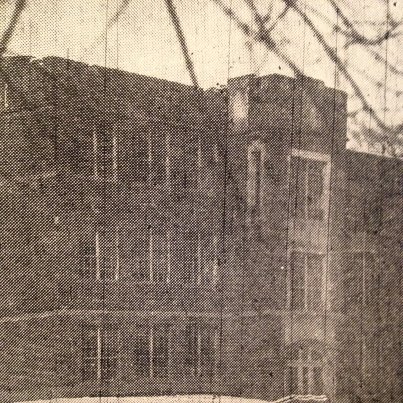
MVHS circa 1933 before the distinctive concrete wall was constructed. Opened February 22, 1929. Auditorium had seating capacity of 750. Picture appeared in 1933 Western Star, but could be older.
Former Resident Describes Long Beach Earthquake of 1933
Roy Utley at the time was living in Coachella, California, 131 miles east of Long Beach where the quake was most severe. "The quake (later said to be a 6.4 magnitude) started at exactly 5:55 P.M. (Pacific Coast Time) and lasted for more than a minute. I was sitting near the radio listening to the news of the banking situation and all of a sudden the radio stopped and the lights of our store flashed as though a severe electrical storm was approaching. Then I look toward the back bar of our soda fountain and it was rocking end-wise, just as a log or board would on a rough body of water. Then I ran from the building into the street, only to see hundreds of others there also. The quake shook the earth so hard that telephone wires swayed to and fro for five minutes after the shock. At the time of the quake my wife and baby were visiting in Colton, 81 miles away and I tried to get a long distance call to them and it was one hour and 15 minutes before the call was completed. Long Beach, a city of 160,000 was almost entirely demolished and 63 are known to be dead and 1000 injured with property damage of 25 million dollars. Ten thousand sailors and marines and many American Legion are protecting property and the city is under martial law and all telephone communication is disrupted. Water mains and gas lines are broken and people are boiling their water. In the beautiful Lincoln Park in Long Beach are tents, emergency hospitals and relief stations. In another small town, Compton people are living in the public square and loads of oranges, cabbage, flour, etc., have been piled up there to help in the relief work. It was here that a giant gas tank burst, and 85,000 gallons of gasoline flooded the streets. Please pray for us!" The earthquake thankfully happened after school was out. 230 schools were destroyed or severely damaged in the quake. New laws were enacted after the quake setting guidelines for earthquake resistant schools.
As Others See Us.....1933
The following article on Mt. Vernon appeared in the Hagerstown, Indiana Exponent:" The southwest section of the state offers some interesting surprises if you have never toured the pocket. Mount Vernon, county seat of Posey County, is a quaint town, full of rich history and interesting characters. If you're the great granddaughter of the ex-governor Hovey of Indiana or the grandnephew of a former ambassador you're all set. You don't necessarily need a lot of sheckles in your pocket but you must have "blue blood" in your veins. The town has some talented musicians, well-read physicians and lawyers. Most of the farms are owned by large land owners and tilled by tenants. It is common to see farms of 100 to 1000 acres. Horses are rare. In this section they have Hinnies, a cross breed between a mule and a stallion. They stand hilly country better than horses. The Saturday night shoppers in this section are interesting to study. Fishing and duck hunting are favorite sports. Hovey's Lake, a short distance from Mt. Vernon, offers both. The fish include chiefly cat, crappies, buffalo, carp and bass. Three hunters recently shot 73 ducks and were prosecuted for bagging more than the limit. The bottom of the Ohio River belongs to Kentucky and you can fish in a boat as long as you don't have it anchored. As soon as you drop an anchor you're on Kentucky soil. Cypress and pecan trees are plentiful. Pecans sell for ten cents a pound and they beg you to buy them! A 650 acre stock farm is located on an island. The only woman on the island is a "negro mammy" who keeps house. Corn is raised in the lowlands and farmers there depend on the overflow of the river to fertilize. Some years it floods and they work desperately to save their crops. Houses and barns here are built on stilts so they will be above the water mark and during flood seasons the least expensive homes are deserted.
"Retired Rube" Goes Historical.....1933
?Retired Rube was the pen name of John S. Williams a retired school teacher in Mt. Vernon. Back in the thirties he would write some short stories in the Western Star as well as some great one liners on everyday life. On this particular day he said that Mt. Vernon was never called McFadin's Bluff by the pioneers. A point about a mile and half below Mt. Vernon was called however, "Hagemann rocks." He went on to say that two McFadin brothers lived on the high bluff down there and each had a log cabin about forty yards apart, "and they gave no posterity the name McFadin's Bluff." He said they left no descendants. Another McFadin family lived at the foot of what is now College Avenue and that family contributed the name McFadin's Landing. The head of this family was a cousin of the two other heads. His first name was Andrew, nicknamed "Teedle-de-dum." One of his five children, Katie, grew up to maturity and married Thomas Black, a great uncle of "Retired Rube."
Retired Rube tells a Fish Story and a little History.....1933
"One hot day in July when I was a boy eight or ten years old, I went to my grandpap's to ketch him a mess of fish. There was a small, muddy pond down in a sink hole in his field about 75 yards from the house which was full of little mudcats. I remember running nearly all the way over there and that I was awfully hot when I arrived. Also that grandpap said: "Why Johnnie, you have been runnin' like a work hoss. Sot down in the shade of the house, lean you back again' the wall and, here take this turkey wing fan and fan yourself. I don't intend to let you do no fishin' till you cool off." And I like a dutiful grandchild, "sot down" with my back to the wall and used the turkey wing fan rather vigorously. After I'd blowed awhile, I asked: "Grandpap, how big a place was McFadin's Landin' when you named it Mt. Vernon?" "Oh, hit wern't much of a place. There was only one store, three cooper shops, eleven saloons, five dwellin' houses and three or four houses built out over the river on posts. Then, threw was a sort of a blacksmith and gunsmith shop combined, but the feller that kept hit didn't git much to do 'cause us old pioneers managed to do most of our own blacksmithin' and gunfixin'. There was lots of drinkin' andn fightin' goin' on most of the time. You see, they was a big sand bar right out in front of the town and a steamboat landin' at the foot of hit, whicht give the town hits name. Sometimes there'd be a lot of flatboats tied up along the bar and their crews would all make for the saloons, and first thing you know some feller would start a fight. You see them flatboaters wuz a rough set, and so wuz the people of the town. Sometimes there'd be a big old steamboat at the landin' with 30 or 40 roust-a -bouts loadin' cord wood and all of 'em singin' as they trotted back and forth, nevery carryin' more'n one stick ata time. They sang "Nellie Gray," "Old Black Joe" and a lot of others." "Hit sounded like about 40 hives of bees all buzzlin' at onct. But clear out now, and ketch me a mess of feesh." I did and we cleaned white peerch and buffalo feeshes all day long sitting on a hickory log and tellin' stories."
Mt. Vernon Circus Performer Dies.....1933
Vincent Keefer, 62, was a battle ax juggler! Now that sounds bad. What would make you want to do that? Vince was the son of Ed, a cobbler in the city for many years that had a frame building on Main Street were later the Old First National Bank became located. As a youngster he lived on Mill Street opposite the county jail. For many years he made annual trips with show and carnival companies. With his brother they formed the team of Kiralfo Bros. and appeared in many circuses and on Chautauqua circuits during the 1880's. The juggling team was with the Wallace circus in 1888 and played with the famous "Black Crook" company through Texas. They appeared with the Terrell Brothers circus in 1889. He later moved to Evansville.
Vine Pruner, Gift from 65 Years Prior, Still in Use in 1933
When Fred Freimiller, 84, a well-known Mt. Vernon horticulturist was seen around town trimming grape vines and shrubbery for people, few realize that the vine pruner he was using was a piece of history. The pruner he had was over 65 years old and was presented to him by an employer when Mr. Freimiller worked in a flower garden in his home town of Zurich, Switzerland. The pruner was given to him as a New Year's present. Freddie came to the United States in 1871 and located in Mt. Vernon, shortly afterwards and brought with him his pruner. During all these intervening years he has used the tool in his work and continued to remain in good condition and Freimiller wouldn't trade it for a carload of new ones. "A piece of home."
Pastors Speak on Death Penalty and Smoking to Kiwanis Gathering.....1933
I can just see the local Kiwanis squirming in their seats, putting out their butts as local religious leaders from the tri-state talk about sin. One Methodist parson said, "The Christian teaching is that the body is a temple of the Holy Spirit and I think you'd have to call smoking a sin." A Roman Catholic said, "Those who fail to make a reasonable effort to stop smoking are committing a sin by unnecessarily incurring a danger to their health." A Rabbi jumped in and said, "Moderate smoking is not sinful but we are against chain smoking. A Southern Baptist exclaimed, "Those Christians using tobacco were hurting the cause of Christ." One minister said: "I am not prepared to call smoking a sin because the surgeon general's report on smoking was not completely conclusive." That's a good one. Maybe, one day they will write it on the side of the pack. hahaha. Now we get to the good stuff.....murderous capital punishment. They all seemed to be in agreement here that the death penalty was a deterrent to murder. The pastor of the Christian Church here in Mt. Vernon said: "The homicide rate will not be decreased until the criminals are given to understand that they cannot hold life lightly." I wonder what they would think of the many innocent men who died legally by the hands of men who were innocent? Jesus himself was a victim of capital punishment. Thomas Jefferson himself said: "I shall ask for the abolition of the punishment of death until I have the infallibility of human judgment demonstrated to me." And if you are into theology....I like Romans 12:17: "Recompense to no man evil for evil."
Memorial Day.....1933
Major G.W. Kimball, adjutant of Harrow Post, G.A.R. read the general orders and Damian Ofer delivered Lincoln's famous Gettysburg Address. Music included numbers by Mrs. Frank Fessenden, "Peace to the Grave, and "Let Us Have Peace," accompanied on the violin by Miss Barbara Fessenden. Rev. Buroker spoke on the subject, "Are We Americans?" Some of his remarks included: "To be an American requires something more than birth. But I wonder if we have not made too much of this matter of American birth, for it alone is no proof of one's Americanism. Benedict Arnold was born in America. Aaron Burr, who rose to the vice-presidency, though he was born in America, was guilty of treason. The larger part of our criminals could boast as well as us of their American birth. To be an American goes beyond the use of a ballot, for most people vote not as Americans, but as a political party. But party regularity does not put the seal of purity upon citizenship. In the final analysis it makes but little difference to which party a man belongs today, for the difference between the two parties is the difference between Tweedle-Dee-Dee and Tweedle-Dee-Dum. In one party there is moral rottenness and in the other there is political corruption. Loyalty and fidelity to the ideals of the nation are the things which make one an American in the truest and finest sense of the word." Following the address, the Woman's Relief Corps conducted ritualistic services placing flowers on the graves of veterans. After the benediction, a firing squad of the American Legion fired a salute over the graves and a bugler sounded "Taps."
Six Decades of MV Speakers Represented at High School Program.....1933
A unique program commemorating the observance of new and old graduates attracted over 300 to the Mt. Vernon auditorium. Music was furnished by the Mt. Vernon High School orchestra under the direction of Prof. Norman Beeson. In opening the session, M.N. O'Bannon, superintendent of schools stated that this high school was commissioned in 1874. For sixty years the Mt. Vernon High School has been recognized in the highest class by the state of Indiana. "There are 874 high schools, and Mt. Vernon is one of the 127 first class schools. Of 1,624 graduates from Mt. Vernon during the past sixty years, 713 were boys and 911 girls. In checking we have found graduates in all states of the union and foreign countries." A.S. Gronemeier, member of the class of 1895 and member of the board of school trustees, presided over the meeting. Mr. Gronemeir said, "It is quite a distinction to be able to say you are a graduate of the Mt. Vernon High School, whether it was back in 1874 or in 1933. We have only thank our good city and the good taxpayers for this wonderful institution, which has been kept going during the period of depression and we expect to maintain the same high standard in the years to come." The oldest living graduate, Thomas Brown of 1878 graduated in a class of five students. "In order to secure your diploma, it was necessary to write and delivery your own speech from memory. The fear was often expressed then by the public of too much education and discouraged." Brown told the recent graduates to smile and work and allow no side tracks along the way." James Blackburn, graduate of 1891, stated that his classmates were not so far different from today. "A uniform course of study was adopted by the state legislature in 1889 that made a great improvement in rural schools." His closing comments were of the making of great men , in military, literary and political life from Mt. Vernon. William Egil, graduate of 1897 spoke of his youth and that only one member of his class had passed away. He felt the students of today were granted more privileges then the strict upbringing of his time and felt that was better. "If I have any recommendations to offer, I would suggest that the Bible should be taught, and we should reveal political waste." Other speakers gave addresses to including M.W. Fuhrer a graduate of 1910.
"My Baby; She Wrote Me A Letter".....1933
Back when "leaving on a jet plane" was unusual. Miss Jesse Lamb of eastern Lynn Township wrote her mother in route by airplane from Chicago to New York. Of course this was before jet airlines. She wrote: "I am now 6000 feet in the air on one of the fastest planes of the United Air Lines and what a thrill it has been. This is the most perfect means of transportation-so smooth, clean and pleasant. The world is certainly beautiful from up here. We left Chicago at 9:30 in the morning and at 4:30 we will be in New York City. We are running along now at about 115 miles per hour but it seems as if we are hardly moving. We are now passing over Lake Erie and will soon be passing over the mountains. This is a wonderful experience and one that I will always remember."
What-ya-ma-call-it?.....1933
The Mt. Vernon Creamery announced a cash prize of $5 in gold to the person submitting the best name for their new confection....a chocolate nut sundae on a stick. The new treat is already been put on sale to local dealers. No word on what they called it...how about "Sundae Nutty Bar?"
Charles Smith Lumber...Later Mt. Vernon Lumber.....1933
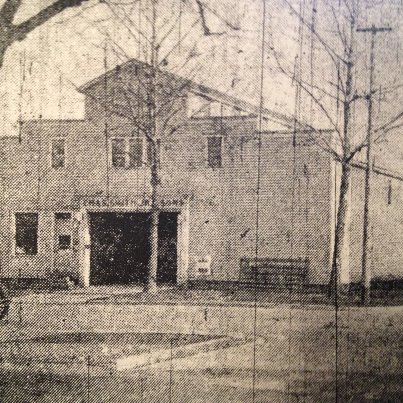
This business was one of the oldest in Mt. Vernon history right up there with the Alles Bros. Furniture Store and Forthoffer Bottling Works. Established in 1868 by the late Charles Smith and his son Charles Jr., the mill at that time was located at Sycamore and Sawmill. That mill was destroyed by fire in 1886 and in 1888 the plant was rebuilt on West Second Street. Many sons followed keeping the original name....C. Edward, Ira, and Clinton. Around 1925 there was another terrible fire and over $30,000 of materials were destroyed. Having faith in the community the buildings were promptly rebuilt. Eventually, in the early 30's they acquired a nearby concrete plant and then were able to supply concrete as well as lumber, shingles, roofing, sashes, door and window frames and building materials in general.
Mt. Vernon Water Works.....1931
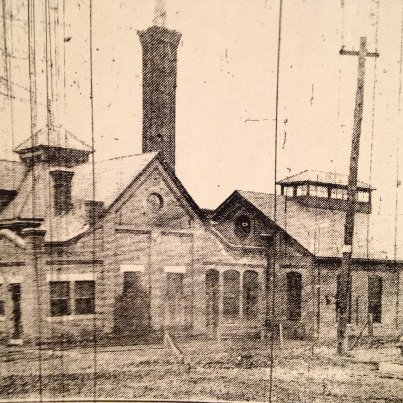
The plant opened in March of 1886 and furnished our community with an adequate supply of water drawn from the Ohio River. Some pipes existed until the 21st Century. In the thirties, pumps had a daily capacity of three and one quarter million gallons, drawing the water from the river and forcing it into settling tanks where impurities were eliminated. From the filters, the water flowed by gravity to a clear water well from which the high service pumps with a capacity of four million gallons a day force the water through twenty one miles of mains comprising the distribution system. The people and businesses of Mt. Vernon at that time were using between sixty and eighty million gallons of water a year and had 1300 customers with over 100 fire hydrants.
"Oh my, I wish they wouldn't do that, don't dance so close. Come on now".....1931
A big old liquor party in western Black Township climaxed at a dance when two men received knife cuts and a chauffeur was shot. Now you women gonna have to be more discreet...don't let them men get all up in your stuff and expect nothing to come of it.
The Tank Car Oil Company in 1931 was selling gas at 12.9 cents per gallon.
Also that spring the first electrically operated gasoline pump in Posey County was installed at the Gulf station on West Fourth Street with William Miller the operator. I guess "bad guys" thought they were making a killing down at the Tank Car station at 10th and Walnut, because a hold up occurred that year where the attendant was forced to lie on the floor while the bandit helped himself to $45 from the cash drawer of the station owned by Dalton Alldredge. John Starken the attendant was unharmed. There was a grand opening of the Shell station on East Fourth owned by Harry Green. For a buck you could get four gallons of gas and a quart of oil. Air is free. Retired Rube Sez: "In these times of depression how can many people afford to burn up two and three dollars' worth of joy gas every week, running around going nowhere?"
A Precious Little Wine Glass Now Apparently Lost.....1931
During the days of slavery, a family named Carter had several children, one in particular was a lad named Abe Lincoln Carter born into slavery. At around 17 the Civil War ended and the Carters like many ex slaves, came north looking for opportunity. They had few possessions, but one of them was a little wine glass that Cynthia Carter's master always drank his wine from. Cynthia was a fine lady who was always helping on the big days of the plantation like those of wheat threshing, butchering, and if someone had a baby. Mrs. Clarence Todd in Mt. Vernon in 1931 recalled that in 1882 her baby sister was born so Cynthia came over, cleaned up the house every few days, cared for the mother, and baked a huge jar of cookies. Cindy was a big woman and in summer she was barefoot. A hired man hitched the horse to the buggy and took Mrs. Carter home. Mrs. Todd rode along and when they got to her gate, Cynthia asked her to wait a second and she brought out the little wine glass and gave it to her young friend. She said, "When I was in slavery, I would fill up the glass many times for my master while nursing two babies at one time, one on each breast." Cynthia lost her husband and became blind and almost was paralyzed, but lived maybe to a hundred. Nobody knew for sure as no one kept records much of slaves. Mrs. Todd came often to visit Cindy from time to time and she would cry and kiss her hand each trip. That little wine glass was of little material value, next to nothing really; but Mrs. Todd kept it until 1931 when she gave it to the Posey County Historical Society. That little wine glass that survived slavery and the floods locally of 1884 and 1913 is lost for all time probably. You see the artifacts once preserved for all of us to see was stored at the Coliseum and was stolen in the 1930's. I hope that never happens again!
Tuberculosis Warning in Schools.....December 1930
Tuberculosis was said to claim more lives of people between the ages of 15 and 40. In fact, Posey County led the state in deaths from the disease in 1929 with 28. Teachers were put on alert to look for over fatigue and poor nutrition habits from their students to insure the health of our young people.
50 Years After Great Fire of 1880; A Witness Describes It.....1930
James Davis wrote an article published in the Western Star about the night of October 19, 1880...the greatest fire of the downtown district in Mt. Vernon. On that evening it was moderately cool and frosty. He was awakened from his peaceful slumber by the ringing of the old Methodist Episcopal Church bell that was rang when something within the town was on fire. The bell was mounted on a large frame platform, held about 25 feet in the air by large 10X10 inch uprights, substantially braced and the sound was such it was said that it could be heard over the four corners of town. The bell was located in the southwest corner of the old churchyard on Walnut Street. The tone was said to be peculiar and different from the other bells in the city. The bell a short time after the fire cracked and although repaired it was never the same. Anyway, James arose and while dressing went to the window to see where the fire was. He saw a bright glare in the southern sky and he knew the fire was on Main Street. He ran down Main and with neighbors and friends he yelled "Fire" at the top of their voices. He soon saw that the fire was in the business house of Gerding's candy and confectionery store, a three story brick building located on the west side of Main, between Second and Third. Just north of the burning building was the George Henrich gents' furnishing store and tonsorial parlor of four chairs, and the Mt. Vernon Banking company, the latter on the alley. Buildings south of the burning store were Rosenbaum & Harlem, dry goods and merchant tailors, the New Era dry goods and grocery store, opened and operated by George Naas, a former county treasurer, and a building on the corner occupied by Dr. William McArthur, a celebrated patent medicine manufacturer and druggist. This was the only building of the whole block that was not destroyed. "Other buildings consumed, located from the alley north to Third Street, were the Fuhrer-Boyce store, the John Burtis restaurant, Tischendorf & Sutcliffe's millinery, Peter Walter's saloon, James Dunn restaurant, Ike Kahn's saloon, John Zimmerman's shoe shop, George Feldman's barber shop, Freeman, Pfeffer & Wey's Meat Shop, Martha Overton's residence, Clark's jewelry store and Rhein's shoe shop." Arriving on the scene, Davis noticed that there were enough men on the bucket brigade and the best place for him to help would be with the salvage crew. "I first went into the confectionery store of Charles Gerding and carried out merchandise until the fire began to eat its way into the ceiling of the first floor. I then assisted in carrying out goods from the Rosenbaum & Harlem store until it was unsafe to re-enter and started on the New Era building." The New Era building was a large store and was later the location of the Stinson Bros. Dry Goods. "The building ran to the alley in the rear and on the north was the dry goods department and on the south was the grocery department. In the center was a large skylight. As I passed under the skylight with my arms full of dry goods the glass broke and glass rained down and cut my arms." James rushed home and his mother bandaged his hands and he then returned to the fire. The fire burned north consuming wooden buildings all the way to the corner of Third and Main. There were a number of saloons and restaurants and outside the street was littered with cigars. "The street was not littered with whiskey and wine however as it was consumed by the workers." Remember at this time there was neither fire department nor firefighting equipment.
Copy of 'Hunk-a-Dora" given to Posey Historical Society.....1930
Funny name for a paper isn't it? This paper was a four page affair, dated June 20, 1867 and was said to be published semi-monthly in Mt. Vernon. The paper was distributed gratis with a circulation of 500. This particular paper was given by Mrs. Ida Edson Jean of Houston, Texas visiting in town in the fall of 1930. The paper was said to be in a well preserved state with not even a faded mark being noticed. The Western Star newspaper looked it over and said the quality of paper was superior to what they were using then, but unfortunately, the publication did not mention the editor or the address of the office. News items of interest were few. There was a item on steamboats like the Mayflower and Mary Swan operating in our area and an article of the completion of the Solitude covered bridge by a Mr. Washer. A list of marriage licenses was noted. Among the advertisers were J. A. Smith and Bro., fancy tobacco; W.F. Stiehl, ice cream; Cafe DeParis, Leonard and Jones, dry goods; Patmore and King, groceries and liquors; Hollingsworth, dentist; Whittelsey, Jewelry; Hazle Weare, groceries; George Henrich, barber; Andrew Fogas, cigar mfg; Noel and Milner, dry goods; Pearse, physician; and Terry agent for the Cannelton, Sash, and Door factory.
The "Biggest Little Grocery".....1920's and 1930's
It's amazing the number of little groceries there were before they got large. It seems every few blocks was one...I continue finding ones I never heard of like Dunn's at Fourth and College Avenue. This business started around 1925 by Elmo Dunn. Although located in a small building it was said to have had a unusually large stock of items and had a "systematic arrangement of stocking." Patrons often marveled at the completeness of the store. Fresh vegetables were carried at all times. Dunn started in the business at age 12, employed in the Charles Joest grocery once located in a building on North Main Street which has since been torn down. He clerked for eight years in other locations too before starting his own business. He was assisted by his wife and Miss Edna Kost.
Retired Rube Sez to the 1% 'ers of his Time.....1930
The man who already has more than his share and is still trying to get more comes within two feet of being a hog.
The original McFaddin memorial from the 1930's at the riverfront. Where did it go?
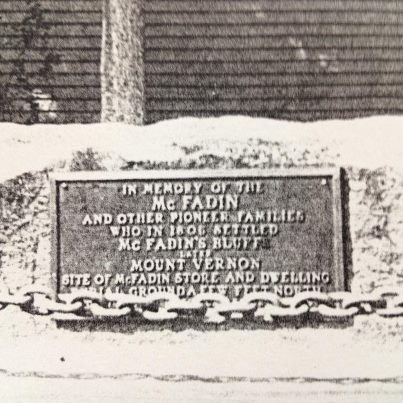
I have seen pictures of it during the '37 flood, but none since. I don't know where it is either. Was by there today and I guess Homeland Security is not concerned with workers taking there break under the tree.
1920's
A Mecca For Shoppers.....1929
The Niblo Variety Store, 403-407 Main Street was a popular place for decades. It carried a large stock of variety goods form women's and girl's dresses to dishes, curtain materials, notions, hosiery, enamel and tin ware, baskets, kitchen utensils, stationery, toilet articles, bric-brac, toys, and candles. Mr. Niblo came to Mt. Vernon from Olney, Illinois in 1913 and moved to the location on Main in 1924. Later my generation remember this as the location of Tresslar's. In the sales department assisting Mr. Niblo was his wife and their daughter Mildred, Miss Cora Shaw and Miss Grace Dixon. Fred Blesch was the janitor and other salespeople were added during the holidays.
A New School.....1929
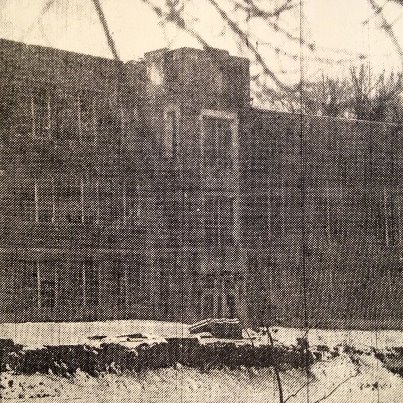
Erected at a cost of $200,000 the site was purchased in 1920 and the city council issued bonds in 1928 in the amount of $50,000 to assist the city in paying for the structure. It was then like 293 others in the state of Indiana, a six year high school. The building was 128 feet wide and 237 1/2 feet long in a Tudor gothic design both interior and exterior. All the outside windows were equipped with Draper adjustable shades and each radiator of the heating system was self-regulating. The building was said to be 95% fireproof with all stairwells being constructed of concrete and steel. It had a gymnasium and a auditorium. Built-in lockers were in the hallway and a trophy case and a bulletin board both built-in. Drinking fountains were located in the hallways. The auditorium sat 747 and had a balcony. There was a 20x30 foot stage with front curtains of red velour and a second of greenish blue velour. The stage had border and foot lights and controlled by dimmers. Dressing rooms were underneath the stage. There were biological, physics and chemistry laboratories and places for manual training like cooking, sewing and woodworking. There was a print shop and agricultural departments. The gym was 80X80 with dressing rooms and offices for both girls' and men's coaches. (We had a girls' basketball team until 1930). The gym playing surface was 41X76 with two glass backboards, one on each end and four wooden backboards on the two sides of the court. Could accommodate 1100 spectators. The ticket booth for the gym was as you entered from Sixth street. Much of the equipment was bought right here at Pearson's Furniture, Gronemeier's Hardware and others. Gates were installed in the hallways of the first and second floors to close these areas off to visitors. Doors were all made of oak and each room numbered, those in the basement being in the teens, the first floor the twenties and the second floor the thirties.
Don't Wreck It While I'm Gone Son!.....September 1928
William "Butch" Dieterle, driver for the Mt. Vernon Fire Department, returned from his annual ten day vacation which he spent with relatives and friends in Louisville, Jeffersonville, New Albany, Chicago and Genoa. During his absence his son, George had charge of the truck.
Stocker's Grocery Opens...1928
In March of 1928, Frank Stocker bought his store from the Gerber Grocery at 735 East Second Street. Frank also owned a store in Evansville. Charles "Jack" Hix was the manager of the Mt. Vernon store. Over the years into the late thirties and maybe 40's it made many changes. In 1933 it had a meat market, operated in conjunction with the grocery and then was equipped with a modern refrigeration system and they slaughtered their own fresh meats. As time went by, more equipment was added to meet modern sanitary standards, like a modern meat display case. Don't want all them animals just hanging from the ceiling. hahaha.
Big Bingo in town with Circus.....1928
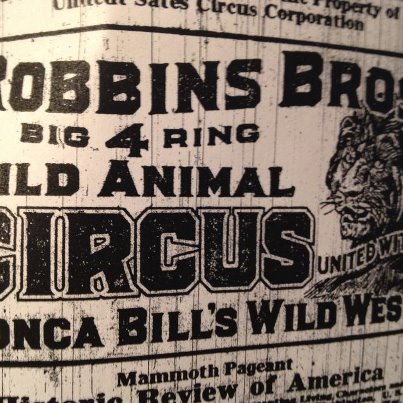
In September the Robbins Bros. Circus marched down the street in a large parade and the big menagerie were also features of the circus. The crowd was large for the free parade but did not fill the large big top tent. There were all sorts of things to see however and it went in a real snappy way with little wasted time between shows. There were 4 rings, 300 horses, 600 animals, elephants and camels, a band of Sioux Indians, ten sea lions, performing zebras, dogs, ponies and birds. Also there were African lions, tigers, panthers and pumas. "Big Bingo", the largest elephant in the world was on hand. Any two elephants it was said could hide behind this pachyderm. The ad said Bingo was born in India about 154 years ago! Really? Bingo is so old he just had to stand there and show off. He was not in the parade and no longer does tricks. There were several spectacles including a tribute to fairyland where a cast of 300 actors did a ballet of 100 fairies. There was classy riding as the Hodgini family did comic antics while riding. Applause was numerous for Hadji Be Linzeed tumbling act of Arabia and the Montazuma family from Japan which presented juggling. The closing feature was a salute to "Historic America" which depicted the historic events of America with characters representing Paul Revere, Spirit of 76, Grant, Robert E. Lee, Lincoln, The Rebellion, The Great War, Coolidge, and a patriotic musical finish. Oh I forgot much more like the polar bears and the high jumping wolf, a reenactment of an attack on a covered wagon by real Indians and much more including clowns, more clowns and even more clowns. When it was all done the circus packed up back into the 30 double length rail cars and moved to another town for another show.
Palace Pocket Parlor BIG on Ice Cream....1928
Edgar Alldredge, proprietor of the Palace Pocket Parlor on Main Street, was informed by the Tip Top Creamery Company of Vincennes, of which he is the local dealer, that he had exceeded the sales of all their customers for the hot month of August. During the scorching month he sold 621 gallons of ice cream and in the last eight months has sold 2887 gallons of the cold stuff. I guess the locals really love their ice cream as this does not include the hundreds of gallons of ice cream sold by many other dealers in the city representing other companies.
Something New for Mt. Vernon Gridiron Game with Oakland City.....1928
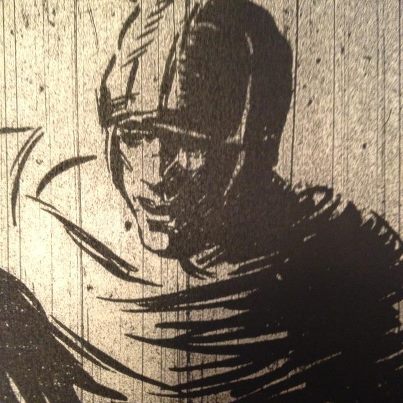
A snake dance, starting at Sherburne Park and making its way down Main Street preceded a monster pow-wow and pep session at Athletic Park...the first of its kind ever here. The affair was sponsored by the Hi-Y club of the Senior High. The snake dance occurred on Friday evening and on Saturday the Mountaineers (what our nickname was before Wildcats) defeated the Oakland City crew 25-7. Over 300 rooters were said to be in attendance. The "Scrappin' Pencemen" (Ed Pence was coach) consistently ripped the opposition with gains of five, eight and nine yards. Malcolm Abell and "Kelly" Defur were the outstanding performers for the locals. Another new item was that the yard lines were marked off for easier viewing. Each of the 5 yard lines were marked plainly in large white figures on a maroon background. The markers were permanent and can be taken up and used for future games.
More Words Found to School Song I Wasn't Aware Of.....1928
Was looking through a Memory Book that once belonged to the late Mildred Blake, a 1928 Mt. Vernon graduate, a fine violinist, and a school teacher. There were all sorts of memories in this book of recitals, orchestra clippings, girls' basketball mementos, even a wrapper from a candy bar that coach Homer Allgood gave to each player before an important game. One page struck my eye...the School Song. The first verse I was familiar with from standing and singing it at countless athletic events. Here is the full version: "We will shout for the red and white boys and we'll yell Mt. Vernon High. Never daunted, never taunted, we will rout M..V..H..S...Rah! Rah! Rah! Loyal to our school boys, till we die we'll praise her name. In victory or defeat, we'll never ever retreat, but fight for her the same. "March , march on down the field, shouting Mt. Vernon High. Break there the enemy's line, their strength to defy. We'll give a long shout for Vernon's men; We're here to win again. Fight, fight unto the end, Mt. Vernon High."
700 Mile Bike Ride for Boy Scouts.....Late 1920's
One spring three boy scouts, Malcolm Aydt, Frank Fessenden Jr., John Schenk Jr. and their assistant scoutmaster, Thomas Underwood took off on an adventure from Mt. Vernon equipped with only simple camping equipment. They traveled as far south as Clarksville, Tennessee stopping at such places as Providence, Kentucky, Bowling Green, Mammoth Cave and Frankfort. They visited the grave of Daniel Boone and of the birthplace of Abraham Lincoln. They saw Louisville and Indiana's first state capital in Corydon. They were gone for three weeks camping in farmer's fields and parks, cooking their own meals and repairing their own bikes. I think that should be worth a merit badge or two!
Keenie's Pop Corn Crispies On Market Soon.....1928
Mt. Vernon had a new industry manufacturing Keenie's Pop Corn Crispies, which was started by Louis Kuehn in a building constructed in the rear of his residence at 616 East Second street. Kuehn installed a King Quary electric popper at a cost of $250 which was to supply four bushels of popped corn each hour. After it is popped it is conveyed into a heating tank where the syrup is cooked into the corn. It is then molded, pressed and wrapped and ready for delivery. Kuehn is ready to handle all orders, large or small and will make deliveries of reasonable quantities to any part of town.
"The Shadow Knows".....1926
A new place in town to rendezvous and to enjoy the treats of ice cream, sherbets, tasty sandwiches, a cool drink and even a nickel cigar. Yes, light one up; nobody here to stop you, no state government telling you no....heck before it was "The Shadow" it was the Smokewell Cigar Company...you know it had to smell like an old ash tray! hahaha. August Gentil and his wife; however, have done a wonderful job of bringing in the trade of a "higher class" of people in an attractive setting. You can buy Elmer's box candy too to take home with you. Come on down and let Joyce Blackburn wait on you and fix you a cool treat.
Want To Play Some Pocket Pool? Hahaha..Head to the Palace.....1926
On New Year's Day of 1913, a fellow named Curtis and another named Edgar Alldredge opened a nice recreational pool parlor at 221 Main Street. Here friends met for hours of pleasure following a day's work. Must have been a nice place, doesn't seem like the ones I remember with gambling in the back room, smoke filled, cussing. etc. This one had a up to date fountain which served drinks and sodas and sundaes. It had candy boxes and Tip Top ice cream made in Vincennes in a wide variety of flavors. Then there were fresh fruits and nuts to put on them. They even delivered their ice cream in quarts upon request to your home. What was Mt. Vernon coming to? Oh, I forgot....it was Prohibition.
Weisinger Funeral Home.....1926
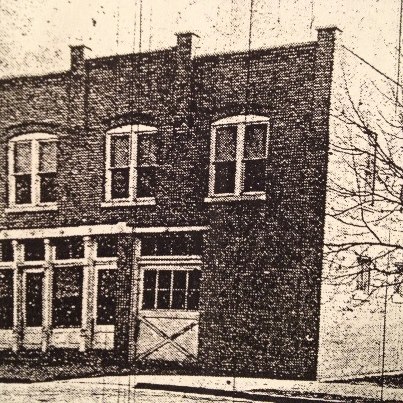
It was one of the oldest in town established by Henry Weisinger on the same site at Mill and West Fourth Street in 1866. It then went to A.V. Weisinger then to Merle. On the second floor were four show rooms and a preparation room. Today (2012) it is Funk's Carpet.
Griffin Destroyed by Tri-State Tornado.....March 18, 1925
After hearing Angela Mason who authored the book, "Death Rides the Sky," at the Mt. Vernon Library recently I purchased her book and quickly read it. What a story! The most destructive tornado in American history moved forward over 70 miles an hour and reached sustained winds of over 300 plus miles per hour. An F5 maybe a 6 that was on the ground for 291 miles and for over three hours killing almost 700 people in three states. I pulled up the Western Star and the Poseyville News for that date and looked at the pictures, read the stories, poems, and obituaries. A book could be written on Griffin alone, but this tornado destroyed many towns and farms along its path sometimes two miles in width. The book is outstanding. I came across something in the Evansville Courier in 1986 of a former police reporter by the name of J.C. Kerlin. He covered the Griffin tornado and shared some memories of it. I also found in the Democrat the reflections of James Linville about what he saw. Kerlin was sent to cover the storm. He drove from Evansville to Mt. Vernon in his Essex Six against a strong head wind. In our town he saw groups of people on the street looking skyward. He was told that Griffin had been hit and he should drive to New Harmony where survivors were being taken. He reached the new Ribyre gymnasium and saw the basketball court filled with injured and family members pleading for help and comfort. Surgeries were attempted in the dressing rooms off the small stage. He saw bodies of a woman who was so battered it looked like every bone in her body was shattered. An undertaker showed him bodies of two husky men in overalls. He lifted the man's hair and inside the skull was empty! In Griffin he was shown the remains of a Doll Store where five people trapped were burned to death in the basement. "When last seen they were huddled there, their arms around each other as the fire consumed them." Linville was a witness to the storm as it passed about two miles north of New Harmony. He stood in his back yard and watched a sight of a lifetime. "The huge cloud had variations of black, red, green and yellow in the billowing mass that tumbled across the sky." He left New Harmony and headed for Griffin and saw straws driven into trunks of trees and saw a woman's body impaled into a barbed-wire fence with the wires imbedded half way through her torso. There was a man decapitated by a large pane of glass. A section of railroad tracks 30 feet long was bent in a semi-circle like a rainbow. An aluminum teapot was found twisted out of its original form when it was blown against a tree and wrapped itself around it. A woman named Mina House had a piece of plank run through her body and ran a hundred yards before fainting. Her husband put her on a sled and hauled her to first aid. The next day in Evansville it was said it took eight persons to pull the plank out. Relief was rushed in from nearby towns and the injured and dead were removed to New Harmony, Poseyville, and Evansville. 25 people died in Griffin and 202 were injured in a town of about 400. Only two buildings were said to remain standing although damaged. The town was covered in mud and the victims too as the tornado picked up silt from the Wabash River and threw it against the village. The tornado continued to kill as it headed for Owensville and Princeton.
Bobcat Seen in Point.....1925
A large bobcat was seen in the vicinity of Pitcher's Lake in Point Township. The animal has caused alarm among the farmers living in the vicinity of the lake. Farmers once trapped the animals for their valuable fur and hunted them regularly who feared for their livestock. The truth is the animals were beneficial to mankind as their diet was mainly mice, moles and squirrels. Loss of habitat by the clearing of forests declined the population so much that they are now on the Indiana Endangered Species List. This particular incident had dogs refusing to take the trail after them.
Mt. Vernon Marshall Shot: Assailant Commits Suicide.....1925
John Derrington, auto dealer shot J.W. Moses, Mt. Vernon Marshall when the Moses advanced to read him a warrant for his arrest of inflicting a scalp wound. The shooting was done on the street in front of office buildings in Mt. Vernon. Derrington fled in his auto and later committed suicide in his garage. Bad feelings had existed between the two, and the previous night the home of Derrington had been searched and 48 pints of home brew and 3 of white mule were found. The shots that grazed Moses entered the dental office of Dr. McElhaney upstairs. Darrington drove up in a car and stopped. "What do you want with me?" Derrington asked. "You know what I want from you, John. I got a warrant for your arrest," Moses replied. "You have, have you?" Derrington answered and without further ado lifted the gun which was lying on his lap and fired. The police chief fell and Derington drove off. A crowd of over a hundred gathered in a few minutes and the injured man was taken to his home in an ambulance. Early in the morning, neighbors heard a shot gun in the Derrington garage on College Avenue and reported the incident to the police. Investigation revealed the would be murderer had shot his head off with the same sawed off shotgun he used to shoot the marshal.
"I am the eggman, they are the eggmen, goo goo g'joob"....1925
The Anderson-Fuhrer Company of Mt. Vernon and Poseyville shipped a large number of eggs that spring. On the train Friday they sent out their twenty-fourth carload. A car of eggs is said to average 400 cases, and each case contains 30 dozen and the 24 cars makes a grand total of 288,000 dozen eggs if my math is correct. The eggs were sent east, principally to the New York market. Mr. Byrd of Poseyville, manager of their branch said that the country is well stocked with chickens. Probably but we have too many hawks in my opinion and not enough doves. :).
"Back To the Future"....1925
Occasionally, I like to add a few stories that although have no local flavor I find them interesting. Here is one: Henry Morris lived in a cave in a forest south of Omaha, Nebraska for thirty years and had not visited a town or a city since the days of Buffalo Bill when Nebraska was yet young. At that time the wolves and the Indians ran free. An Omaha newspaper heard of him and brought him to Omaha to see the sights. Hank it seems was alarmed at the sight of an automobile and was frightened of an elevator and didn't care much for motion pictures either. He couldn't understand how a voice could travel without wires too. As a strange man in a strange world, he asked to be taken HOME.
Trick Played on Young Teacher, Catharine Howard.....1925
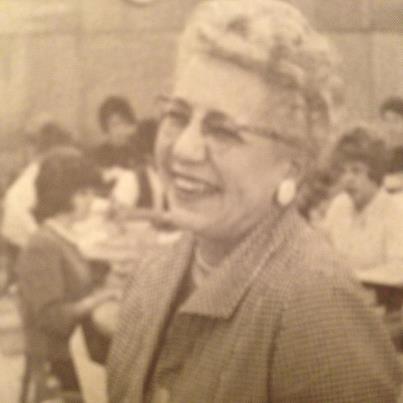
Miss Howard, Over 40 years of teaching the students of Mt. Vernon starting at the "Castle" on College Avenue in 1925. She taught debating, did some one-act plays, World History, English and Latin. She started the Drama Club at MVHS and the Footlight Performers. As a new teacher in 1925, she caught some culprits rolling hedge apples down the aisle and throwing corn cobs through the window. She turned the young offenders over to the principal and she felt bad about it. She cried for a while, but later took it as a challenge that she would be tested now and again by students. She looked for ways to mold them and get through to their minds. The next 43 years she never sent another student to the principal.
Every Fifth Fence Post is a Jug.....1925
I was talking to a man about Prohibition and the making of Moonshine in Point Township. I was told that there was a long line of fence on a prominent farm back then that had jugs of whiskey, corked with wax coverings buried at every fifth post. You could go up to the post and it would be loose and you could pull it up and there would be a jug of "shine." Markings like hieroglyphics were used on the posts to let you know if it had been taken or not. Evidently, stills were prominent near the cypress trees along the river.
"She's a Freak, Super Freak, She's Super Freaky".....1925
What do to with a cow with no eyes? That trouble adds to the problem a farmer already has in Poseyville. Such an animal, a Jersey breed was born on a farm of a Mr. Wade. Wade was formerly a professor at State Normal School in Terre Haute and for several years superintendent of schools in Wadesville. The freaky calf has small depressions, each about the size of a bean, in the place usually occupied by eyes. Otherwise, it is a perfect specimen. "The animal dashes straight ahead when frightened, frequently butting into a wall. It also has difficulty finding the lunch trough." Wade is undecided what to do with her.
Dietz Grocery 229-231 West Second Street. Probably 1920's or 30's.
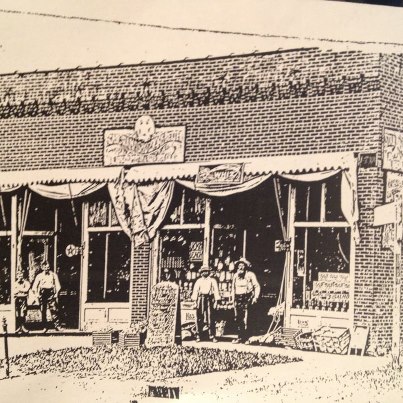
Later was Hironomus then Koodie Hoos....Woo Hoo!
Homer Shaw Shoe Repair at 837 Walnut.....1925
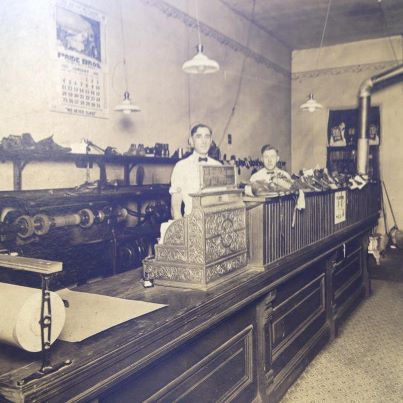
"A Little Bit of Ink, Makes A Person Think?".....1924
The metal signs bearing the inscription, "School Be Careful," purchased through Martin Smith by the city council have arrived and will be placed near the various school buildings. The signs were manufactured in the Michigan City State Prison and were purchased at the request of the city's club women.
Edison Musical Artists Play in New Armory Building.....October 1923
Three noted Edison phonograph artists were heard live in a recital at the Armory on lower Main Street. Glenn Ellison; baritone, Sybill Fagen; whistler, and Alta Hill; pianist applied their crafts and I imagine it was very similar to the little cylinders the audience had back home. Probably spun not like the 45's I knew; but more like 125.....haha. The Edison name was still pure genius; but the public was listening to more current popular music that was being sold by competitors like Columbia, Brunswick, and Victor. By 1930, Edison was out of record business.
Receipt of Threatening Letter Goes Unheaded.....1923
No clues were found to the identity of the sender of a threatening letter to the Keck-Gonnerman company demanding $3500 in cash to be deposited at a designated place in Evansville. The letter was signed, "K.K.K." The letter threatened death to members at the firm if they did not comply. No attention was given the letter and no precautions were taken except to turn the letter over to authorities.
~WavY~ Walks Down Main and Meets a Critic.....1923
Now if I had lived then, I probably would have been boarding say at the Garten Inn on Main. Nice fall day as I leave the restaurant having consumed a delicious chicken dinner. I drop into the post office and talk to the clerk, a Mr. Brown about how nice it would be to grow a few trees again around the court house. He seems to have a differing opinion. I turn to leave and run into the Western Star editor, Mr. Leffel. The old gentleman who has been editor since 1876 when the courthouse was built agrees with me about the trees and then we talk about the condition of the streets. "Don't you think Mayor Osborne should do more paving?" I ask. Leffel replies: "Yes Lemuel has tried to get more shovel ready projects on board and I have written about them in my paper." I add, "Probably them obstructionist republicans pushing for lower taxes that's the problem." "You are probably right, I am all for strong paved streets! Nothing gives a town that dressed -up look but paved streets, and they're not expensive when you consider how long they last!" We high five and I have one parting note: "See you around Sir, the sound of horses pulling their hoofs out of the mud isn't music to my ears. By the way, I hear the Pythian Band is playing down at the Sherburne. Want to go?" "Nah, he says, "I got a deadline and I am not much on music since they abandoned fife and drums....later."
Young Boy Ran Over By Hay Wagon and Survives.....1923
John Fletchall and his brother were playing in the hayfield and hanging onto a hay wagon. John slipped, and fell beneath the wagon and a wheel passed over his chest diagonally. The men at first did not know it had happened until John's brother, carrying the limp form of his brother got their attention. John suffered three broken ribs. His survival seemed to be a miracle as the weight of the wagon and the hay was said to be 2400 pounds. The only explanation for his survival was that the boy fell into a depression when the wheel went over him. The entire town held their breath for a complete recovery.
African-American Lodges in Mt. Vernon.....1922
There were it seems eight lodges for blacks located at three different locations. The Gay Flower Lodge and the Household of Ruth were at 806 East Third Street; the Waldon Lodge was at 108 Main Street and the Waymon Lodge, Friendship, Ohio Valley Court, Corinthian Tabernacle, and Ethiopian Tabernacle met at 107 West Second Street.
Youngsters Crowd Store to See Santa...December 1921
Kids, kids, kids took over the Stinson Bros. Dry Goods Store Saturday in their eagerness to see and talk to old Santa himself. The jolly old fellow, loved by all, arrived on the traction line at 1 PM and found quite an assemblage awaiting him. The wants of the little ones were made to Mr. Kringle and for a time moving was a problem as it was so crowded. Santa showed great patience and spent time with each and every little one and heard of their Christmas desires. The big man gave out whistles and "crickets" to all the kiddies and they all returned home with their souvenirs and dreams of a Christmas visit one week following.
Showboat in Mt. Vernon.....1921
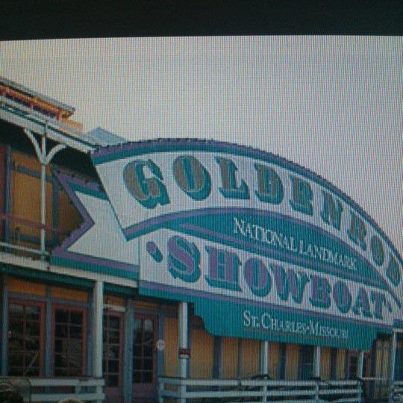
On May 16, 1921 the showboat, "Goldenrod" docked at our riverfront and put on the play, "Johnny Get Your Gun." The scenery was very elaborate and the cast was said to be superior to any on the river. The vaudeville was first rate. This is not a war play, but a comedy and the gun used was a fake gun from a motion picture studio, and "what he does with it would make the most rabid skeptic laugh right out loud." So it sounds like it was excellent entertainment for the tired businessman and all those lovers of clean, good amusement.
Flags At Polling Places.....1921
For the first time in the history of Mt. Vernon elections an American flag was placed at each of the polling places by the Harrow Relief Corp in November. Western Star newspaper urged all Democrats living outside the city temporarily to get an absent voter ballot from either City Clerk Lloyd Dixon or a precinct committeeman. No appeal was made to Republicans.
"John Boat" and My Fish Too?....Come On!.....1921
Chief of Police Wallace Maier made a trip down the Ohio River in search of a red "John boat," which had been stolen from the docks of John Vail at the foot of Mann Street. The thief was familiar with the Vail residence since he also stole a pair of oars and then loaded a barrel of fish; Vail had caught that very day.
Jail Overflowing but Streets Getting Repaired.....1921
Mt. Vernon continued its get tough policy of using prisoner labor under the administration of George Zimmerman. Twenty-eight prisoners were confined in the county jail with about half working on the streets in charge of Bill Brommeihaus and Heck Reagon. One of the tramps arrested for vagrancy has a father in Kansas whose wealth exceeds $100.000 and had not heard from his son in over a year. The young man is said to have an imaginary grievance against his parents and 18 months ago he left his home and has since seen most of the major cities of the United States. He has said to have "broke rock" in dozens of cities and despite a telegram from his parents he wants nothing to do with them.
Long Lost Ring Found.....1921
One year prior to his marriage, Andrew Lawrence presented his sweetheart who later became his wife a gold band ring and several years afterward while throwing some rubbish out into the lot back of their lot, the ring slipped from her finger and was lost. Mrs. Lawrence claimed a hog ate it! Twenty-two years later, Price Kennedy a tenant on the farm was passing through that particular lot and noticed a shining object and upon digging it out of the earth discovered it to be the ring. The initial and date on the inside showed it was indeed the ring of Mrs. Lawrence. The ring was delivered to Mr. Lawrence, but unfortunately, Mrs. Lawrence died two weeks earlier. Andrew took it as a sign from his wife of love.
"Better Than Bring That One Up We Decided To Throw Our's Down".....December 1920
It all started on Thanksgiving Day. 92 Thanksgivings ago, on Thanksgiving Day when Roy Jackson decided to have Thanksgiving at the home of Jas Crider. Now after a while Roy, age 16 decided to take out the garbage. He loaded up the 1200 pound bay horse on Mill Street and headed to the Third Street fill. He got there and found all the garbage down there, and decided this was the city dump. So he took what must have been a half a ton of garbage in the dray wagon, threw in all the shovels and rakes and implements of destruction in the back and drove to the embankment. He looked over the embankment and there, there over the side of the embankment was a large pile of rubbish. Being a smart lad this must be the place. Young Jackson was backing up the dray wagon when the misjudged the situation and got too close. The wheels went over the embankment and he urged the horse to go forward, but the load was so great and the footing so bad that the poor horse could not hold the load. Down they went....horse, wagon, boy, and slop to a depth of 75 feet before hitting bottom. There, there underneath a half a ton of garbage lay young Roy. Spectators proceeded down the hill to the rescue of the horse and after his release from the entangled harness and chains was found to be uninjured. The boy too after being dug out was fine.
Child Lost in Wabash Bottoms Found After 24 Hours.....October 1920
A six year old son of Mr. and Mrs. Louis Richeson, tenants on the Spencer farm wandered off into the Wabash bottoms about twelve miles east of Mt. Vernon looking for his father and got lost in a field of corn and was not discovered until the next day. The search kept up through the entire night with friends and relatives frantically calling for him. Around 11 AM the next morning the boy was found with his clothing almost torn to rags from his wandering through the tall cornstalks. He was described as hysterical with fright, but uninjured from the cold night spent in the field.
Mayor Zimmerman Liberates Homing Pigeons at Fogas Drugs.....September 1920
Mayor George Zimmerman on a Saturday morning released two homing pigeons from Fogas Drug Store and the instant the cage door was opened they flew down Second Street and rising above the Masonic Hall made one circle at a considerable height, and getting their bearings made a bee-line for their cove in St. Louis. Both bore a message from Mayor Zimmerman to the Governor of Missouri who was awaiting the outcome of 2500 pigeons released from cities all within 500 miles of St. Louis to advertise the Rexall Drug Convention in St. Louis. The pigeons were on display for three days at the Fogas Store prior to their release. They were bred from pedigreed stock. Two of the thousands of birds released were war heroes in the Great War. One of them, "President Wilson" started through fog, rain, and shrapnel fire with an important message a distance of 25 kilometers and arrived with one eye destroyed by shrapnel, but made the flight in 18 minutes. Another, "Mecker" came in home with one leg shot off and with a war message that enabled the American artillerymen to silence an annoying enemy battery in 20 minutes. Our birds didn't finish so well as three days after their release they hadn't shown up. Pigeons released from Arcadia, Louisiana got there first.
Decendant of General Thomas Posey Speaks to Posey.....September 1920
Miss Mary Posey, a great, granddaughter of General Posey of which our county is named was a guest of Mrs. Douglas Jones of Mt. Vernon. Miss Posey, a resident of Henderson, Kentucky had recently returned from China where she spent an incredible 32 years in Missionary work and on this subject gave an interesting talk during the afternoon to the Missionary society of the Presbyterian Church. She also told of her experience during the Boxer Rebellion in 1900.
"This Is The Way We Do It.".....August 6, 1920
Notice: All parties interested in the Old Beech cemetery bring their mowing scythes and forks. Oh, and while you are at it County Highways Superintendent Hungate says all farmers must cut the weeds alongside the roadsides adjoining their properties. Now do it!
"Motorize The Farm" Tour.....July 1920
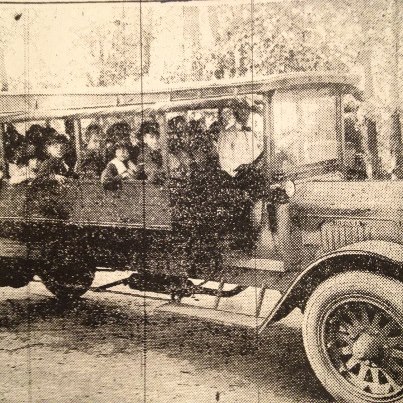
The photo is one of the trucks used in connection with the "Motorize the Farm" Tour, given under the auspices of the Evansville Auto Dealers Association that summer. This tour was one of education, covering the agricultural sections adjacent to Evansville demonstrating to the farmer and grower how to more economically operate their farms. The trend of people living in the cities and men leaving the farm was noted. Guide said, "It is a known fact that the pneumatic tired trucks will accomplish what it takes four teams of horses to do. It takes the products from five acres yearly to maintain each horse, while the truck does not consume anything unless actually at work." No attempt was made at making sells, just to inform and understand the tremendous burden the farmer has in feeding 4/5's of the nation who do not live on farms.
The "Commons".....pre 1920
This was a tract of land facing Fourth Street from Munchoff to the railroad and extending back to Eighth Street. At Fifth Street the western edge was Wolflin Street. This was pretty much all vacant except for a few houses on Sixth. Some of the people nearby had cows and would stake them on the commons to graze. Farm Bureau Coop takes up a lot of this ground today. Here we had circus shows. The parade would go through town while the tents were being set up. First to rise was the cook tent. A man looking for a short time job could normally find one at the circus. Tents were needed for the animals and the side shows too. Roust-abouts were needed for work, with the lifting and the caring of animals. Sometimes the elephants were even taken to the river for a bath. The circus grounds were behind the Western School so learning was interfered with when they were in town. The commons was also used for athletic events from baseball to football to track, to bicycle races. This was before Athletic Park.
Only Took 27 Hours From Chicago to Mt. Vernon.....1920
Harvey Breeze and John Doerr returned from Chicago where they drove home two giant two ton trucks purchased by Mr. Breeze for the Good Roads Construction Company. The drivers reported the roads in good condition, enabling them to make good time during the trip. The distance of about 400 miles was covered in 27 hours, which includes five hours of stoppage time for meals and slight repairs. The trucks were used to haul gravel in the construction of Posey County roads. "Your highway taxes at work."
The County Fair Experience ....the 1920's
Back then in the summer the county fair was a big time event. The mother would awaken the children early in the morning and prepared a picnic lunch maybe of fried chicken, pies and things children really like. The father would prepare the wagon and team for the journey to New Harmony with plenty of hay for the horses and for the children to sleep on during the trip back. While at the fair, the children would ride the Ferris wheel, the merry-go-rounds and visit the side shows. These side shows were anything from Wild West shows to the freaks. You know the bearded lady or the cow with two heads. I can imagine that these breaks from farm life were quite memorable to the children of that era.
1910's
War Relief.....World War 1

Members of St. Matthew Catholic Church organized during the war to make supplies and bandages for the American Red Cross. Picture was taken on the church steps.
Cotton Blossom ....Before the Crush.....1918
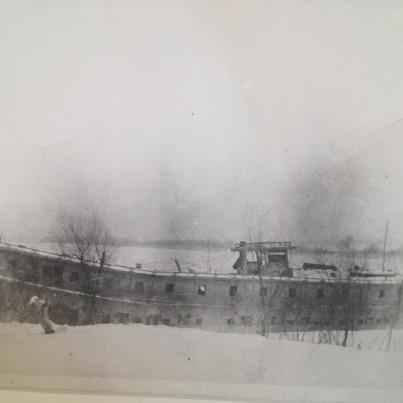
This is the best picture I have seen of the Cotton Blossom that got caught along with a couple of other steamers in an ice gorge of January 1918 at the Mt. Vernon riverfront. That was a tough winter with over 40 inches of snow during 1917-1918. On December 10, 1917 the Ohio River froze over and remained that way until February. Farmers from Kentucky shopped in Mt. Vernon after walking across the river. Large drifts stopped the trains and the interurban line. The Cotton Blossom, the Jewel and the steamer Clyde were all sank on a reef just west of the water works plant. Much of the contents of the showboat were removed. When the ice started moving, remnants of the Blossom were carried away to near where the Strawboard Factory was located. By the end of February, crafts of all descriptions could be seen floating down the river as wrecks...barges, house boats, gasoline boats all ruined.
Iron Banisters.....1917
In January of 1917, iron banisters were installed at the steps leading to the four entrances of the courthouse.
Young Man Drowns.....1917
Drowning of young people is always sad. This one the paper chronicled was that of 15 year old Edgar Graham. He came home with his companions and asked his parents if he could go swimming at the raft above the coal barges on the river. They agreed and after twenty minutes in the water as the boys were dressing they realized Edgar was missing. An alarm was given and about a half hour later, Edgar's lifeless body was recovered by Elijah Page with a drag hook. The young man was interred in the Bellefontaine cemetery.
Where People Voted in 1917.....
Today I am use to marking my ballot here in Black Township at the General Baptist Church, schools and the library are common places for polls. Back in 1917 it was a little different. I was looking at the sites of the twelve precincts back then and some were at the Cartwright office on Third Street, Sherriff's office in the Court House, Clerk's office in the City Hall, the Cronbach residence on West Second, B.O. Hanby's printing office, the Bailey residence on Store Street, the John Loehr residence on West Fourth and the Erwin Grocery Store.
Chautauqua in Mt. Vernon 1904-1932
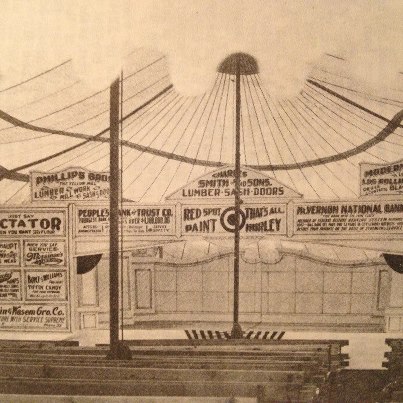
Those are approximate dates of the years Chautauqua's were a popular event in the Mt. Vernon area. The photo is from 1917. These were held on the grounds of the old Central building, now Hedges Central. Back when there were no entertainment of television and even before radio, circus, rodeo and Chautauqua's brought in entertainment. Here one could see vaudeville, and hear statesmen, orators, preachers and comedians. There would be bands and the entertainment was clean and family oriented. They usually lasted a week and drew great crowds in the hundreds each night for a small price. Sometimes a storm would blow and I imagine it was quite a scene to see furniture blowing off platforms and actors dodging falling tent poles. Maintenance men would patrol the grounds removing rain water from the tent tops and spreading saw dust. The streets around Central school would be filled with Model T Fords, Reos, and Crow automobiles. Beautiful women would be dressed in those God-awful long dresses to the ankle and probably large plumed hats. Men would have on their derbies and white shirts with tight fitting cuffs. Some may have even worn straw hats as they strolled the grounds. Children would be amazed at the fairyland atmosphere looking at trained dog acts and maybe for the first time see a motion picture. The adults would listen to prohibitionists rant and rave, even as the men probably snuck in a pint. Women listened to a preacher stomp his feet and clap his hands from the pulpit about the demon rum and the indecent dress of the modern world. Later the girls would huddle under a walnut tree in small groups talking about the entertainers and sometimes gossip about so and so who painted her face too brightly. After the recess, everyone went back into the tents and listened to the choirs and soloists which sent everyone home in a good mood. President Teddy Roosevelt called Chautauqua's...."the most American thing in America."
100th Anniversary of McFaddin Landing.....1916
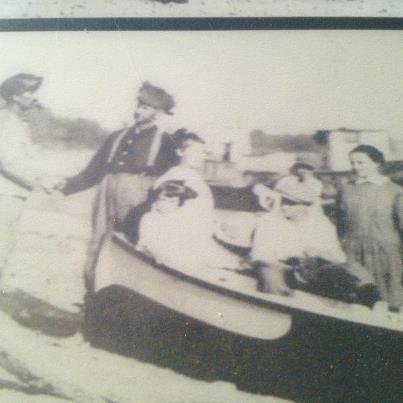
Doug McFadden who pushed the like button is a descendant of those hearty pioneers, a lawyer in Washington D.C., author, and a candidate for the Democratic nomination for Congress from the 8th District of Indiana in 1968.
A Gem of a Find.....March 1915
Everett Bridges, employed at the Mt. Vernon Strawboard Plant while cleaning out one of the pits over which waster paper passes, on a Saturday afternoon found a diamond. Not knowing the value of it, he offered the gem to another employee by the name of Darnell for fifty cents. After the purchase Darnell took the stone to Ike Rosenbaum, the jeweler on Main Street who informed him the diamond, though having several small flaws was worth at least $200.
Reward.....1915
By mistake a set of ladies in Poseyville laid their furs in the wrong buggy at the Poseyville hitching racks at a party and someone drove off with them. It was asked that they be returned for a reward at the Poseyville newspaper office.
If You Start Me Up.....1915
Walter Owens sustained a severe injury Sunday morning while cranking his automobile. The crank kicked back and struck him just above the wrist, breaking both bones and twisting the hand until it stood at right angles with the arm. Now that's got to hurt! Yep...Owens suffered much pain before he was taken the four miles into town to see a doctor. I bet it kicked like a mule~!
Jail Birds Making It Right.....1915
Virg Smith went to St. Phillips to look at a bridge that had settled five inches. Virgil decided to take ten to twelve men out of the county jail to rectify the problem. County commissioners gave their permission and off they went with a guard appointed by Marshall Hall. I hope they didn't go grudgingly!
Deacon Writes Minister in Illinois About Scam Artist.....1915
A deacon of Mt. Vernon sent a letter to Rev. Jones of Carbondale, Illinois about a one Major Flemke, a one arm Gospel Army worker working Illinois towns for cash. He had headquartered in Mt. Vernon a couple of years ago and worked Posey County over soliciting aid and held public services. He claimed to have lost his arm while an officer in the Russian Army. An article had been posted of Flemke in a St. Louis paper of the efforts of Flemke to raise money to establish a church in Herrin, Illinois. "The man is a fraud, a dead-beat and an all-around faker. He was in Mt. Vernon and we took him in and helped him along, but he proved to be a rank impostor. He had with him here another man named Jones, who we believe to be of the same stripe. Keep him moving, and notify the people of any town where he goes to do the same. It would take too long to tell you all he did here, but I believe this is enough."
City Hall circa 1915
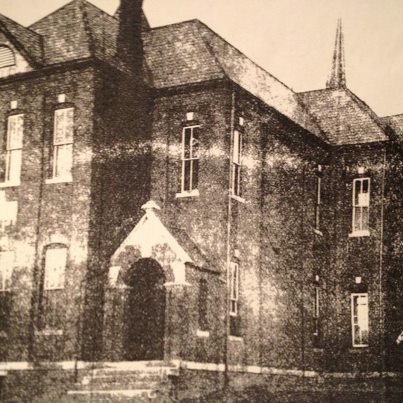
The early gay 90's in Mt. Vernon were an interesting time. The City Hall building was erected in 1893 at a cost of $7,295 and the furniture was obtained from the county commissioners. At the time the court room at the courthouse was being redecorated and the city bought the old furnishings. For many years those benches and desks were in use in the council chamber. On this site before it was built once was a "dog and pony" show held by the Gentry Brothers. The early 90's saw the death of Governor Hovey and Judge Pitcher, two famous sons. The library was first housed in this City Hall from the books of Matilda Alexander who was quite a poet. She even went to the World's Fair in Chicago and gave us her report. In 1893 the large Hovey Monument at Bellefontaine Cemetery was erected after first being mired down in mud pulled by two traction engines from the depot. A prehistoric horn was found in a river bank at Mackey's Ferry in 1893 and that year the African Americans of our town celebrated Emancipation Day in September with a big barbeque at the fairgrounds. The Hudnut Hominy Mill was erected on the riverfront using over 400,000 bricks from Henry Brinkman of Mt. Vernon. Bricks for the City Hall also came from his yard. At the same time as one mill was going up another went down to fire...the Fuhrer and Company Elevator. The Mt. Vernon Fire Department wore red shirts and they could be seen training their horses as they raced their wagons around the city streets. We had our usual fights and murders. Even had a guy sent up for stealing a lot of coon skins. We had a night watchman who early in the mornings would wake you at a certain hour to make sure you got down to the wharf on time to catch a steamer or an iron horse at the depot. The North Cemetery behind the old high school was already falling into neglect as a letter to the Western Star newspaper described. "After leaving the Central school yard and going into the City of the Dead, the contrast was so great it almost paralyzed me with astonishment and sorrow. We have shamelessly neglected our graves. Tombstones are scattered here and there promiscuously, some are broken into three pieces, and half covered with dirt as to almost hide them from view. Is this the proper way for an enlightened populace to act?"
Bygone Days.....1914
Vernon Posey wrote columns for a time in the Western Star and on this date in August of 1940 he looked back to his youth when he walked the streets barefoot or played in the snow. "Thirty years ago! Think of the number of tick-tocks it takes to measure out that space in time. Yet, within our minds, it was not long ago," he wrote. He remembered the fights of "boyville" around the coal pile back of the hominy mill, of riding down the incline at the tile factory. He recalled the fun at the old swimmin' hole below the bluff on the river road and at the mud hole, called Long Pond, near the second trestle on the interurban. Morlock's pond on East Fourth Street and Pfister's pond northwest of town were favorite ice skating spots in winter. He spoke of slipping in by way of the fire escape to events at the old opera house and getting "close-ups' of the local baseball and football heroes following games as they stayed at the St. Nicholas hotel. He fondly remembered listening to the World Series returns at the Western Union office on West Second Street and joining the crowd in front of the Craft Shop for election results. There were the movies at the Colonial Theatre featuring William Hart and Chuckle George, the thrill of the Klein & Wasem grocery fire, county fairs when outlaw Frank James started the races and all day excursions to Cave-in-Rock and Spottsville on board the Steamer Flesher and barge. He remembered seeing James Whitcomb Riley at Black's Grove and the old Central School with the hollow oak tree where he hid his cigarette "makings." On summer nights there were serenades ending at the beer house on East Fourth where tin cups were always at a premium. His story ended with: "Halloween nights! I can't go into it, but you old timers know what I mean."
Traction car nears Mt. Vernon 1913
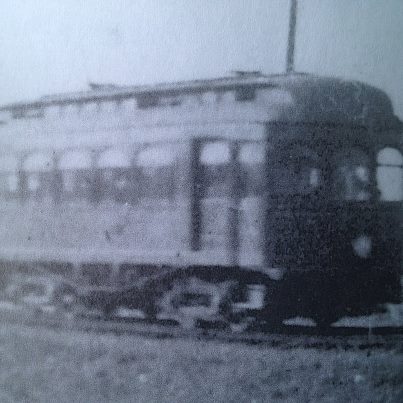
Malcolm Abell's First Electrically Operated Shoe Shop, Circa 1912
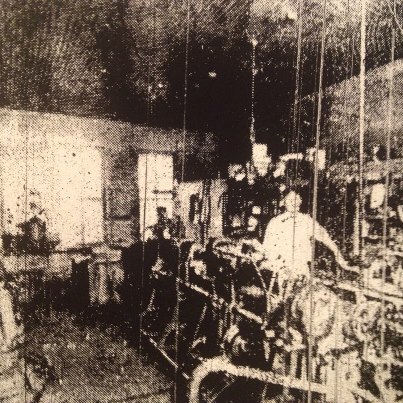
In 1967 Mac called in quits and soon afterward the dean of service in Mt. Vernon passed away. Malcolm Abell, Sr., of 423 Water Street for two years was the co-owner and co-operator of the Mt. Vernon Ferry across the Ohio River and for 55 years owned and operated his own shoe repair shop. He was 86 years old when he retired. For the past thirty years he also did gun repairs. He found time also as a trainer of hunting dogs and "broke" and trained horses. "His long association with the public and his pleasant disposition coupled with his high ideals won him many friends over three generations," wrote Orvan Hall in the Mt. Vernon Democrat. He started out in the Henderson KY, area overseeing farmhands in the horse and mule farming. He had 20 teams of mules and horses. He bought them as colts and yearlings and broke them for farm use. In 1910 he moved to Mt. Vernon and with George Zergibel as a partner he purchased the Mt Vernon Ferry with equipment including a 2 1/2 h.p. gasoline boat and a flat from Fred Hironimus. He sold his interest to George in 1912 and opened his shoe repair shop on the Mill Creek fill in the 300 block of West Second Street. Soon he was known as the "shoe doctor" and business grew. Here people "rubbed elbows, swapped yarns and socialized around a pot-bellied stove." The 1937 flood came and the waters coursed into Mill Creek and damaged his store. The shop was moved to 233 West Third Street and he stayed there ever since. The Depression and World War II years actually were the heydays periods of business for him as people needed their shoes to last. Mac soled and re-soled and patched and re-patched shoes for all ages. He also repaired harness and saddles, canvass wheat covers and side curtains for autos. He had signs up like: "Favors to all....credit to none...I've loved you all....but we need your mon." and how about this one? "We work for cash....and not for fun....we want your pay....when the work is done and I'm looking for the guy.....who started that lie....I'll pay you Saturday." He was a staunch and active Democrat, but he numbered many a Republican as his friends. He shrugged off many attempts to run for office and even was asked by a Republican mayor to be Chief of Police. He loved sports, from hunting to football and basketball. He never missed a local game and was manager of the Mt. Vernon Arrows baseball team in the 1930's when they were a powerhouse in the tri-state. He said the team was so good that his only concern was "corralling them all up after an away game and getting them home safely."
Crude Drawing of MV Fairgrounds Circa 1910
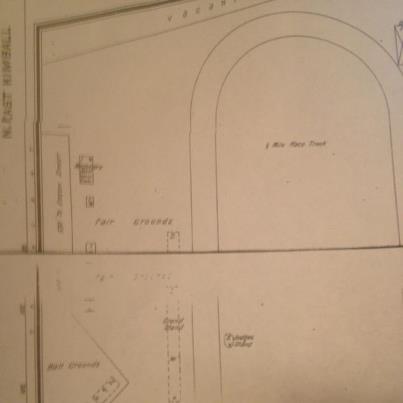
I know it is hard to see. This area was where the airport was east of town. The oval is the half mile track. Fairs, many a circus, athletic events, motorcycle events, etc. were held here. There was a floral hall on the grounds for exhibits and here balloon ascensions were held including one who fell to his death. Speaking of balloon ascensions which were very popular a hundred years ago, there was at least one near the old jail on Fourth and Mill Streets. There was an empty lot nearby the jail and what was then Wm. Barter's Blacksmith Shop. This was probably around 1900 or shortly thereafter. Parents would put their babies into their baby buggies as they looked up into the air and older children would stand between the buggies to prevent anyone from snatching one. I don't know why this was a severe threat, but that is what I was told.
1900's
Presidential Candidate Receives Poseyville Watermelon.....1913
William Jennings Bryan came to prominence during a speech at the 1896 Democratic Presidential Convention. He was selected as Secretary of State during the Woodrow Wilson administration. Wilson came into office with great hopes to have his reign built on moral principles instead of materialism. Bryan was a man of great moral character and did not shy away from controversial issues. He was a pacifist, prohibitionist, trust buster, wanted to do away with the gold standard, rejected evolution, and didn't care much for the monopolies of the railroads or have a high opinion of banks. While Secretary of State he had quite an admirer in Poseyville by the name of Charles Nix. Nix sent Bryan a 72 pound watermelon! Mr. Bryan acknowledged its receipt with this note: "Mr. Dear Mr. Nix, I hasten to thank you for the splendid melon just received. We are enjoying it. It was a quick way of renewing acquaintance. Reciprocating your good will, I am very truly yours, W.J. Bryan." Posey County and the local area seemed to be a favorite of his as he came to the "pocket" many times trying to win the nomination for President. He ran three times in primaries and each time ole Posey gave him her vote. He rode in a parade in Poseyville and spoke as the central speaker at a great democratic rally. He died in 1925 just days after the Scopes "Monkey Trial" ended. Irrespective of the views of others, Bryan's were sincere in all his controversies and once decided on the issues he fought for them and did not waver.
Knife Fight Over a Prostitute.....July 1909
Fred Cabel and Henry Stone met at the home of Maggin Wilson on "Smokey Row" in the eastern part of town and as both were suitors to the fair hand of Amy, a daughter of the Wilson woman, who conducts a "colored" house of ill-fame, a quarrel soon arose between the two men and in the fight that ensued Cabel painfully cut and stabbed Stone about the breast and head. After a hot chase, in which a horse and buggy were used, Detective Smith caught the cutter in the western part of town, and brought him before Mayor Page the following morning. He was bound over in the sum of $500 to answer the charge of assault and battery with intent. Maggie and her daughter were also brought before HIs Honor, and the former was sent to jail for 110 days, while Amy, "received a package which will entitle her to board with Sheriff Grant for ninety days," whatever that means.
Indianapolis News on Soldier's and Sailor's Monument Oratory.....1909
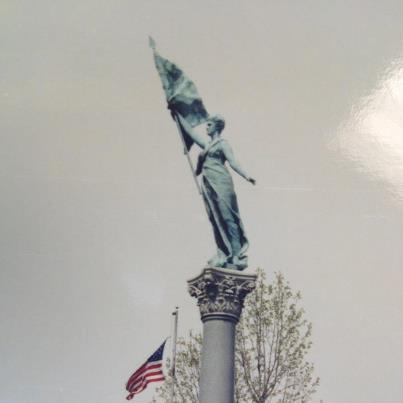
Nine months after the dedication in July of 1908 or our new monument the Indianapolis News said: "One of the impressive features of the monument dedication was that all of the speakers were native born. Major Menzie's presentation, Governor Durbin's acceptance, Riley's poem, Foster's oration and Lew Wallace' little gem by way of introduction were notable contributions and all from Indiana. Distinguished men from abroad were impressed with this feature more than any other. What other state, they declared, could carry out a great demonstration of this kind and speak entirely through the mouths of her own sons? It was indeed a notable fact, and one of which Indiana may well be proud."
Trinity Church.....1909
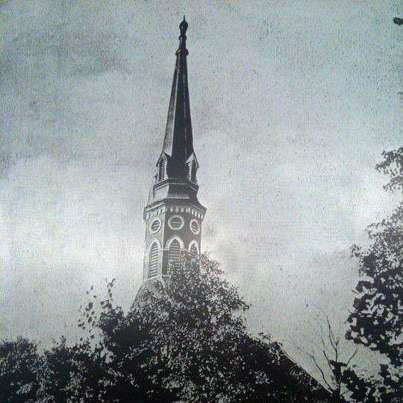
Drought Ends.....October 1908
As I write we haven't had rain in a month and temperatures have been for several days here in June 2012 in the mid 100's. Looking back I found a time when rain did not come for 48 days until finally a fine rain of several hours came to Posey County giving some relief in a time of no air conditioning. Wells were bad, streams and ponds dried up, and farmers quit working in the fields. I hope and pray we get rain soon for all of us. Be careful as fires are starting to break out from the extreme heat...check on your pets and the elderly. Stay cool.
Main Street Graveled.....October 1908
The finishing touches are being put on Main Street from one end to the other with completed curbing except for the dirt to be put back on top to make the graveling pack more firmly. "All are glad to see the work completed."
April of 1908
In April of 1908, Rowe McPhee, 16, was pulling a one ton load of straw to the Straw Board Plant and fell into a 16 foot cistern containing about four feet of water with the load of straw on top of him. He was retrieved, but from the injuries inflicted he was not expected to survive.
Unidentified Football Player of MVHS undefeated Team of 1908.
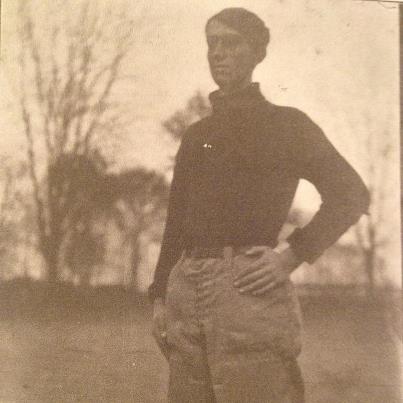
Carbon Arc Lights.....1907
Around this time Mt. Vernon paved Second Street, but the streets around say Keck-Gonnerman on Fourth Street were very bad and muddy. It was not unusual to see the sheriff or a deputy working prisoners with ball and chains on their ankles breaking large rocks into little ones to put in the holes. A funeral around that time brought a body down West Fourth to lie in state as was the practice back then at the person's residence. The hearse could not get to the home due to three large ditches, large rock and deep gutters on one of the side streets. The casket had to be off loaded and carried to the home. The lights there were the old style carbon arc which came about probably around the 1880's or so in parts of town. They had a carbon filament in them and once a week or so a man would come around and change burned out carbon. He would clean the glass globe, take out what looked like a giant stick of black chalk about 4 inches long and 3/4 inch in diameter and give it to the curious children gathered about watching him. The kids liked to use them like a giant pencil to make big black marks. The lights were hung on poles with a pulley for raising and lowering.
The First National Guard Unit in Mt. Vernon.....1905
Company L was organized in this city in August of 1905. The first officers were: Captain Winston Menzies, First Lt. Arthur Miller, and 2nd Lt. Merle Weisinger. The quarters for the unit was the third floor of the Masonic building (Alles) at the corner of Store (College) and Second street. Before it was on the second floor of the old Hagemann building on Lower Main Street, and the second floor of the Klein-Wasssen grocery (Tresslar's). Company L attended its first camp at Benjamin Harrison in 1906 and saw it first military duty as a companion unit of Company E of Evansville at Tell City in 1909 when woodworkers of the industries there went on strike. Fear of more violence following a slaying of a police officer by a drunken striker caused the guard to be called in. No more trouble materialized. Their second mobilization occurred in 1913 when the state's entire National Guard units were called into Indianapolis during a railways employees strike. Our unit remained there for fifteen days. That same year our unit helped in relief work during the 1913 Ohio River Flood. In 1916 this unit was sent to the U.S.- Mexican border for eight months as there were war clouds brewing between the two countries. They did patrol duty alongside the Eighty-Fourth Division. Not home long, the unit was sent in March of 1917 to Jeffersonville, Indiana for duty at the quartermaster's depot. War was brewing in Europe and in September the unit was sent to Mississippi to join the 152nd Infantry, 84th Division training at Camp Shelby. Keeping track of the unit then becomes difficult. Almost all the original Posey County men were transferred to other units and saw action overseas. Company L eventually got to France. By the time they were mustered out in 1918 in LaMans, France not a single soldier, non-commissioned or officer was from Mt. Vernon. Close to 900 different men locally served in this unit from 1905 until it left Ft. Shelby in September 1917. Twenty-two local men made officers during the "War to End All Wars" fighting in the trenches.
Hey, How About a Living Wage?.....1904
R.D. Daniels, mail carrier stopped to talk with a few farmers hauling straw and putting coal oil on hogs to kill "varmints" long enough to say he sure hoped Congress would increase his pay. He says he needs a new suit and at his present salary he is unable to purchase one. As it is now, he is unable to make both ends meet and cannot leave his mail wagon to greet his patrons on his route as he would wish.
A Girl Named America.....1902
In 1902 in Griffin, Indiana a little girl was born to John Fisher and Missouri Fisher. Now Missouri hated her name and when her father Samuel Griffin, of which Griffin was named for, wanted to name his grand-daughter America she protested. Samuel was a very prosperous landowner and he was very persuasive and the couple reconsidered and named the daughter as he wished....America. Samuel was very proud and America became his favorite. He took the train to Evansville and came back with the most beautiful baby buggy he could find with a silk umbrella. He lived another 13 years to the age of 88 and she was always the "cat's meow" to him. Sam was very old and blind, late in life. America would run ahead of him on the road and hide in the ditch going into town. Here he would come with his cane feeling across the side of the road making sure he was just enough off of it and not too close to the ditch. America said he talked to himself and she would try to understand what about, but never could really tell. America's father John was a very patient man and he would take Samuel, America and America's brother to Long Pond at least once a week to fish all day. She marveled later that her father could have so much patience to bait all the hooks and take off all the fish. They would take a lunch of radishes and minced ham and enclose it in a gallon bucket. When opened the smell was so great that they thought they had the best appetizing meal on earth. America went on to study at DePauw and later at what was called Indiana State Normal in Terre Haute. She came home, taught school right there in Griffin and then at Cynthiana. While a teacher at Cynthiana the great tornado struck in 1925 and when she got to Griffin she had lost her brother, many cousins and friends. For a few years she and their husband, an electrician moved to Arizona as gold mines were prosperous at that time. They were homesick and came home to start farming near Griffin. America down through the years taught Sunday school and worked on many committees and in 1974 received the Jane Award for her 15 years of working for the cause of mental health. America Welch was her name....another fine citizen of Posey County.
"Blue Laws," Challenged in Local Court.....March 1901
The Western Temperance Union put pressure on Mayor Alfred Owens to issue a proclamation ordering all places of business in Mt. Vernon closed on Sunday. All complied with the exception of the dairymen and Pete Walter a local baker. Charges were then brought up against Mr. Walker. The case was delayed and most of the evening was taken up trying to find a jury, finally both sides concluded to get the ball rolling "with the timber they had in the jury box." Major Menzies and Walter Jackson appeared for the defendant and prosecutor Wm. Espensheidt and his deputy, Asa Williams represented the State. In exactly one minute and nine-tenths, the jury said the prisoner was not guilty, and amid a shout of applause, he was carried out on the shoulders to his place of business, which be open as usual this coming Sunday. The Western Star editor said, "Mt. Vernon, at its best, is a dead town, and while we don't advocate that all business should be open to the public, on the Sabbath, it is necessary that some should, especially the meat markets, groceries, and drug stores. If we are fortunate enough to own an ice chest, in which to stow a pint or two, as some of the leaders in this movement are, we might, perhaps join them." In other developments the Princeton saloon keepers petitioned their City Council to pass an ordinance forbidding free lunch to be served at a bar. The council refused to consider the matter. The saloon men offered the "wholesome suggestion" that to abolish the free lunch would decrease intemperance. New Harmony Times chimed in: "We know lots of people who drink five cents worth in order to eat a full meal."
Was It a Tornado? Paper Said So.....March 9, 1901
On a Saturday night between 8 and 10 o'clock our citizens were witness to one of the "grandest displays of electricity in the firmaments since 1872, at which time every telegraph wire in the city was ablaze." Around 11:30 the weather changed from a electrical display to a "genuine cyclone" with the electric lights extinguished and the city in darkness. The storm came from the east striking Bluff's Mill in the eastern part of the city and extended as far west as Hagerman's residence, one mile west of town, which had a tin roof taken off the building. In the western part, Ford & McGregor lost two large stave-sheds; the Infirmary was damaged to the extent of $500; Chas Smith & Sons sawmill lost their smoke stack and lumber was scattered throughout the neighborhood; C.F. Tente's residence was unroofed and all out buildings were carried away. On Store Street, Will Lawrence had the heaviest loss, his buggy shed being torn down, falling on the tops of ten or twelve buggies, completely mashing them. Just opposite, the electric light plant lost their roof and their large smoke stack was carried far away. Rosenbaum's lost the entire roof of their warehouse, filled with grain, which was then damaged by the rain. The smoke stack at the Water Works was also destroyed. No lives were lost. East of Main street many buildings were badly damaged, especially those owned by Henry Brinkman and Dr. Hardwick. The two large silver leaf poplar trees in front of grandma Thomas' residence, corner of Second and Store streets, having stood side by side for 57 years, fell victim to the storm, both being uprooted, one falling upon the other. Throughout the entire city fences were blown down and trees uprooted. "Had the cyclone been 25 feet lower, our city would have been wiped out of existence."
A Look Back at 1901.....
We look at our old deteriorating buildings on Main Street and remember when we had a downtown. How did people in 1926 remember 1901? Well, "we had 27 saloons and six or seven houses of prostitution. We had a large number of miserable homes, with women abused by drunken bums and children farmed out as house servants growing up ignorant. Drunken loafers lined the streets making insulting remarks and gangs of people out of work. Men in trades were hired for maybe 17 cents an hour and common labors for a dollar a day. The town was in an unsanitary condition with ill smelling stables, cow and pig pens, and a lack of sufficient sewers. No strawboard factory, no Keck and Gonnerman, no Staples foundry, and the mills were worse than what we have today. There was no Vollmer factory, no Farmer's Elevator, no beautiful garages, or other industries. Improvements have been made on our river front, the Central School grounds, the sports field, the improvements of streets and houses etc. Some of the business men , they may not be making the profit they did 25 years ago, but the general condition of the people and the town has been upgraded. So, cheer-up, cheer-up."
Livery Stable to be Built.....September 1900
Charley Foshee was awarded the contract to erect the livery and feed stable for Kreie & Hagerman, on Main Street, between Water and First, and yesterday began to remove the old frame eye sore. The stable will be 50X 142 feet, constructed of brick, two stories high, with elevators and all the latest improvements. The price will approach $10,000. One think about this story bothers me....."between Water and First". I have seen several references of First Street and I have always been under the impression that Water was first called First. Am I wrong or is the editor?
"Are You Ready to Rumble?".....September 1900
I guess politics has always been polarizing. Try adding the Scopes Monkey trial to your debate on creationism and evolution. Well I imagine that came up that year as the Democrats in Mt. Vernon opened a new headquarters just a door south of Kahn's Hotel on Main Street. Here they had all the county and regional newspapers on display. Maybe even a Chicago or New York one too. They invited their Republican "friends" to come make this your "loafing place" and discuss issues. Pull up a chair, sit a spell, light one up. If you want to bet on the election they would do that too. By the way, Democrat William Jennings Bryan and Adlai Stevenson defeated Republican William McKinley and this time with Teddy Roosevelt again in Posey County 3177-2553.
Metal Steel Ceilings Installed.....August 1900
Simon Gronemeir, our enterprising tinsmith and hardware merchant worked for a month putting up metal steel ceilings in the Western and Central school buildings. Eleven rooms in total were done, with none of the patterns the same. The work was very artistic with borders extending down eighteen inches on the side of the walls, which were painted to correspond with the ceilings in the various rooms. The appearance of the rooms is greatly enhanced.
"Please Take Care of my Baby".....April 1900
Dr. August Harloff, of Point Township upon rising, found a strange carpet bag on his porch and upon examining the contents discovered a healthy baby, about two or three days old. The child's lungs were good as soon the whole household was up. The doctor did not know what to do with it, so he telephoned Sheriff Thomas who advised him to turn the babe over to the township trustee. I don't know if the identity of the mother was ever found or what became of the child beyond being turned over to trustee Morlock who took upon himself to look after the little stranger.
One of operators of Rosenbaums Store.....1900
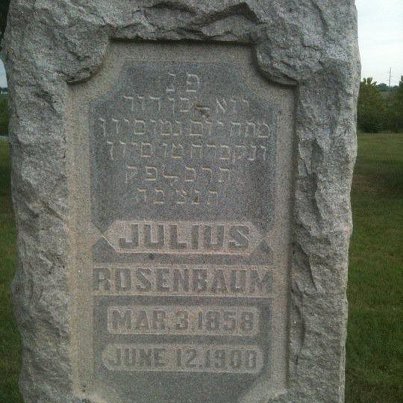
Rosenbaum & Bro was established in Mt. Vernon in 1854 by Moses and Daniel Rosenbaum. The building we now see is the second building built in the late 19th century. Upon the deaths of Moses and Daniel, Jacob and Lee, sons of Moses, and Julius and Mike, sons of Daniel, continued the store and dairy business. In 1919, the business went to Jacob and his two sons, Herman and Jesse. Jacob died in 1931. I took this picture at Bellefontaine on the east side where many of our Jewish friends are buried.
Guess How Many; Win a Prize.....1900
I've seen people guess the number of gum balls in a fish tank, or the number of golf balls in a Volkswagen Beetle so I guess it is not too much of a surprise to see an ad from the Klein Company locally to guess the number of shot contained in a sealed bottle. To play you had to buy one can of Perfection Baking Powder and the nearest guess won an elegant five piece set of Parlor Furniture. Only 150 guesses were to be made. I wonder how long in time this gimmick was used. Hmmm. "Guess the number of pelts nailed to the barn and win a powder horn with some hardtack, only two bits."
Patriotic Parade Leader....Early 1900's
Captain Frank Greathouse lived red, white, and blue. He would often lead our patriotic parades especially Independence Day or what was then Decoration Day, out front in his old Calvary uniform mounted on a white horse carrying the colors. He was also appointed Chief Marshall of the Soldiers and Sailors Monument dedication in 1908. He died in the fall of 1916. Captain Greathouse was at the battles of Fredericktown, Helena, Pine Bluff Mt. Elba, and Mark's Mills during the Civil War. At Pine Bluff he was highly credited with his scout work that led to the destruction of 35 enemy wagons loaded with supplies and capture of the paymaster's safe contains over $60,000.
Mad Cow.....1900
No, not the disease, but a vicious cow attacked two ladies; Mrs. John and Mrs. Jas Bluff near their homes on East Fifth Street. Both ladies were knocked down before the animal was driven off by men. Beyond being scared to death, they escaped injury. Okay, should we have an ordinance for this type of behavior? Maybe a fence?
"Kicks Just Keep Getting Harder TO Find".....1900
A lady named Julia, a well-known "character" in Mt. Vernon, died at the Poor Infirmary. Known on the streets as "Aunt Julia, she was always addressed by all, as she was demented, caused by the constant use of eating morphine, which she purchased by selling the clothing given her by the many ladies she visited in town. "Her age was unknown, but she must have reached 65 or more."....."That road goes nowhere, and you better get straight."
Old Maid's Society.....1900
"Tis a shame that a town like Mt. Vernon which has produced so many pretty girls per square inch of real estate felt compelled to organize the above named society, but it did. Here are the facts: At a meeting held, a committee was appointed to draft resolutions. They resolved: "that we, here assembled need more manufacturing employment for young men who have the grit to earn a living and the nerve of purpose. Any old maid is eligible to join this organization, but handsome widows are to be excluded." Now isn't that somethun? I guess they figured a pretty girl could get a new man. I wonder if they served tea?
Opposite Side Civil War Rivals Fight Again in Town.....1900
One April spring afternoon while in front of Ike Kahn's saloon on Main Street, Henry Baldwin, a man who wore the Union blue and George Washington Smith who wore the Confederate gray began with a handshake and then a "friendly" scuffle which ended when Smith was pushed through the large window of the saloon. Damages were $100 to the building but to the men mistrust abides. Smith was quoted as saying, "I never turn my back on my enemy."
Kentucky Sand Bar.....Early 1900's
Viola Kohler, a local resident, was born in 1892 and she put down on paper later in her life about the sand bar. She said skiffs were a major means of transportation for family picnics across the Ohio River in the early 1900's before motorized boats. The Kentucky shore was a very large sandy beach reaching from the ferry landing directly across from Sherburne Park to about where the ADM Mill is then tapering off. During the ferry hours, the ferry boat, "The Alfred D. Owen" made regular trips but they quit running at sundown or 6 PM. Some didn't want to come back so early so an oared skiff would allow them to come and go as they pleased. A picnic supper was enjoyed and I guess like those today, adult beverages would be consumed and horseshoes thrown. Viola says not all that much swimming was done because of unexpected deep holes while wading. That bar was still there in my high school years and I remember camping overnight there back in the sixties with Terri Utley whose dad, Elmo had a boat. We woke up the next morning and the craft was beached due to low tide. We had a tough time pushing it back into the water. Viola goes on to mention that during a whooping cough epidemic in the city, many folks took their small children across the river, believing that the moist air would ease their coughing.
Eyewitness to the Sprague.....early 1900's.
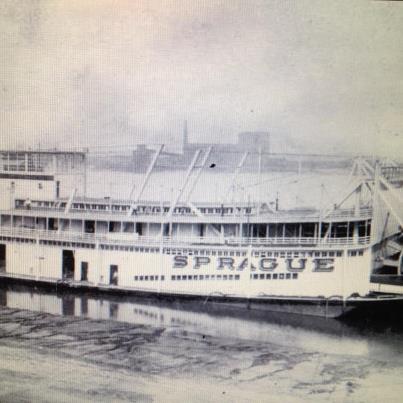
Local resident Viola Kohler as a girl living at 101 Pearl Street came out the back door of her home onto the lattice enclosed porch and glanced up the Ohio River. As far as she could see was nothing but black. She turned and looked down river and it looked natural. Again turning up she saw waves of black. Wondering what was going on, she strained her eyes through the locust trees along the bank to finally see a red post arising out of the black and then discovered what she was looking at was an immense tow of coal which the "Sprague" was bringing down river. The towboat, built in 1901 was the world's largest steam powered towboat ever with a capacity of pushing 60 barges at once. Once she said the "Sprague" was in need of repairs and landed here for Keck-Gonnerman foundry to do the repair work. She said that everyone interested in mechanics tried to find some way to go aboard to examine the machinery.
Miss Mary Munchoff... Mt. Vernon Famous Vocalist.....1900
Born in Mt. Vernon, the daughter of Mr. and Mrs. Herman Munchoff she later moved to Omaha, Nebraska. She began her study in Berlin with Frau Prof. Selma Niklass-Kemper and continued her studies in Paris with Mathilda Marchesi for two years. She came one of the prominent concert singers of her day. Numerous tours were arraigned for her to Germany, Russia, Switzerland, Great Britain, Austria, Denmark, Belgium, Holland, etc. One tour was 28 of the leading opera houses of Europe. Her tours would sometimes last an entire year. On several occasions she would return to Mt. Vernon to spend the summer visiting with relatives of the Munchoffs and Schenk families. She displayed her talent with some of the greatest conductors of her time such as Arthur Nikish in Leipzig, Saronoff in Moscow, Mengelberg in Amsterdam, Weigarter in Munich, Steinbach in Cologne, Hausegeer in Frankfurt and Herz in New York. Her debut was in a concert given by the Leipzeg Mannenerchor in 1898. A large write up was on her in the Illustrite Zeitung magazine in Berlin in 1901.
Pin Point Control.....1900
While driving up Third Street, on his hack, Dolph Stevens, the manager of our town's baseball club, received a severe cut just below the left eye. "Red" Marsh, newly acquired pitcher, attempted to attract the attention of Dolph by yelling, and failing in this, picked up a rock and gave it one oh his peculiar drops, which caused a yell and the hack stopped instantly. Marsh knew where the rock would strike and gave warning to "look out," but Dolph "looked in," just in time to catch it below the eye. Somebody is likely to be banished to the bull pen and when he does play he best throw strikes!
1890's
In 1899 you could get a bath and a cigar
In 1899 you could get a bath and a cigar at George Henrich's Tonsorial Parlor at 213 Main Street. You know when you ride into town all dusty and sweaty and you leave your horse at the livery stable, why not get cleaned up for the night on the town? Pick up a pack of Sweet Corporal Cigarettes, tip the waitress at the Arcadia Restaurant, smile pretty....you might get lucky. If not, you can always hit one of the dozens of saloons in town, chew some Battle Ax tobacco plugs, and get into a fight at the levee. Get you a "to go" whiskey and crash at the Hotel Brettner...only $2 a night.
Marshall Duke Quick Captures Uniontown Murderer.....1898
A man at the Uniontown, KY fair was murdered when his neck was cut from ear to ear. Sam Keith, 17, lived with his father in Walnut Bottoms, about six miles above Mt. Vernon. The father had been ill for some time so the young boy had been running the place. His mother gave Sam permission to take a load of watermelons to the fair. Arriving at the grounds he hired a strange man to sell the melons, agreeing to pay him 50 cents. The man soon sold them all out, but before they were disposed of he was paid for his work. After this he sold more melons, but did not turn in the money (50cents). Sam asked for the change, but the man had lost it in a bet and told the boy to follow him and he would get the money. They went out of the fairgrounds, crossed the railroads and entered a cornfield where the man sprang on him, cutting his throat. After robbing the victim the brute fled. The boy with a severed windpipe attempted to climb a fence but weak from the loss of blood fell. An engineer on a train saw what had happened and stopped the engine, took the boy onboard and took him to Uniontown. News spread like wildfire and less than ten minutes a posse was formed. Marshall Quick, from Mt. Vernon was down there and joined the search. Wasn't long that Quick was hot on the trail and captured him. As news of the arrest spread, a mob shouted "Hang him and Burn him!" It was with great difficulty that the officers saved him from the infuriated throng. He was spirited away and placed in the Morganfield jail and into the evening a mob stood outside and were wild with passion. Later around midnight the mob of around 500 took the man from the jail and he was hung. He was cut down before death, but he later expired.
The Ramblers Club Organized.....1898
At the Posey County Historical Society are many scrapbooks and the minutes of I guess every meeting of the local Ramblers Club back to 1898. This was formed locally on March 17, 1898 when 16 women met at the home of Mrs. Oscar Haas in response to something called, a "Blue Stocking Party." Here the ideas of a literary club were formed. The Constitution and By-Laws were adopted in 1901. The advancement of "intellectual and social culture and promotion of love and good literature amongst its members, " was the Rambler's objective. The club was federated in national and state in 1907, district in 1909 and in the county in 1921. Several local women became officers in the state and district levels. In 1900 the first major project was to bring a lecturer to Mt. Vernon with the proceeds used to purchase 53 volumes for the public library. The first PTA was organized under their sponsorship. The first safety patrol equipment was provided by this club and interest in child welfare was generated by sponsoring a series of five weekly lectures in 1916 and a baby show in 1917. They purchased articles made by the blind and sponsored Clean Up Days. They were responsible for beautifying and landscaping of school grounds and Sherburne Park and sponsored the Boy Scouts with projects of birdhouses for sale. Contributions to the school lunch programs were made for low income children, art funds, Christmas baskets, girls club, and many more worthy causes. They were the first organization to offer a student scholarship fund and during World War 1 they purchased bonds and provided care for a French war orphan for three years. They volunteered at Red Cross shops. They were active in the 1916 Indiana Centennial celebration and the first woman ever elected to the Mt. Vernon School Board was an active club member. The membership looks like it might have reached over 40 members by 1980. Since their books are now at the PCHS I am not sure the club is still active. It would be a shame if they are not!
Enjoys Being a Tramp.....November 1897
This is not really a Mt. Vernon item, but the Princeton News reported about a man named Jas Wilmer who was in a train wreck west of New Albany. The tramp was pulled out of the wreck unconscious. Even the coroner gazed at his form and thought him to be dead. Soon ole Wilmer began showing signs of returning life and a physician helped him come to himself. The funny part is that Wilmer carried a wallet containing $182 in good United States coin. When he was asked why he was tramping he told a reporter that riding in a box car was much healthier than to be housed up in a passenger car with a lot of women who were covered with "rotten cologne." The tramp said he probably would sue the train for damages because the wreck caused him to miss his connection with a freight train at Louisville which would have carried him to Springfield, Ohio.
Would You Do this to YOUR relative?.....May 1897
Henry Kolb was hired by John Schisler to work on the widow Templeton's farm, three miles west of Mt. Vernon. While plowing a field on the hills overlooking the Ohio River, he turned up a skeleton of an Indian with a number of flints of various designs. The skull was well preserved with not a tooth missing. The next day the 'find" was exhibited in Mt. Vernon.
Decoration Day.....May 1897
The services that year were held by the Harrow Post, no. 491, G.A.R. at the North, or Leonard Cemetery. The address was delivered by the old Chaplain of the 25th Indiana Infantry, Comrade Rev. F.A. Hearing. Flags for soldiers buried there as well as those in Bellefontaine, Black's, Miller's, Farmersville, Moore's, Dann's, Greathouse's, and other nearby cemeteries can pick up free flags for their graves at the First National Bank in Mt. Vernon. Due to high rains, sexton Frank Lintz reported that over 300 graves at Bellefontaine have sunk one to three feet. The day began with a sunrise salute with six blasts from the cannon. At 1:30 in the afternoon a column moved from Main Street to the cemetery including a firing squad on foot, followed by speakers in carriages, buggies, and wagons. A ritualistic service was held with the strewing of flowers upon the graves of the departed. There was a invocation, and music solos and quartettes. The Mayor and the city council were in attendance as well as the Fire Department, all lodges and veterans. The services ended with Taps.
Convict Labor..."Right Here in River City!".....January 1897
Section 3033 Revised Stature of Indiana 1868 in setting forth the duties of the Mayor says: "And he shall perform such other duties as the nature of his office and the interests of the city require." Mayor Larkin used this to "rope in hobos and use them to work on the city streets." Usually at that time of year the city would hire maybe a hundred able bodied men in destitute circumstances from Mt. Vernon and be paid $1.25 a day to do jobs the city needed. To save money, Larkin "captured hobos or "wandering Willies" and placed shackles on their ankles and made them work while being fed by the taxpayers and causing them to be degraded." A reporter went out to the streets and interviewed the populace about the plan. It seems Larkin was not too popular especially with the laboring classes who were need of employment. "It's practically taking bread out of our mouths," said one. The newspaper said, "The poor and the needy are a portion of our city and given work to these shiftless wags whose labor will not pay for their keeping is wrong. Is it a nice thing to see these tramps supported by the county, put at work on our streets, while the deserving citizens who want work cannot get it? Here they are moping around with a empty stomach and an aching heart. Better that these nuisances be run out of town then create here at home discord." Maybe we should have built a fence to keep them out and checked for green cards. ......just saying. LOL.
A Little Glimpse of School Statistics.....1897
Compulsory education in now the norm and Mt. Vernon has average wages for teachers at $47.50 per month. Most of the teachers, it is said have had training in professional schools in addition to graduating from the high school. Attendance for November of that year show that of the schools of High School, Main Street, Western, Central , and "Colored" the numbers are 94.9% with an average attendance of 905.1 students. The number of corporal punishments for the month were 27, 22 being at the "colored" school and none in the high school.
No Longer a Man's World.....1897
In the cities a new movement was underway where girls are beginning to take the place of boys in the offices. A local editorial proclaimed: "The old fashioned office boy who swears, smokes cigarettes and is impertinent usually, and reads dime novels in a corner, or loafs when he is sent on an important errand is fast disappearing. It is predicted that in the course of time the office girl will have entirely taken his place. No one wants an impertinent, swaggering cigarette smoking boy about an office or as a clerk, bookkeeper or stenographer. Girls do not acquire these detestable habits."
Big Haul for the Big House....November 1896.
Our law enforcement officers broke a record on a Saturday night when they ran fourteen prisoners into jail for being drunk and disorderly. By Monday morning they were fined a dollar and costs and all of them where attached to a ball and chain to work on the rock pile.
Flower Mission Day.....May 1896
"Flower Power!" Different meaning in my time, but flowers have always been the sweetest of God's things....an expression of love, beauty, and peace. The Women's Christian Temperance Union celebrated Flower Mission Day by presenting the sick and poor a bouquet of flowers with a scripture verse attached to people in the infirmary and the jail. They hoped to sow some good seeds that perhaps in the future would lead to a better life. At the infirmary, many a heart was touched by the expression of concern by the ladies. Cake and fruit was also served to the poor. The Superintendent, John Millett and his wife made the ladies welcome and invited them back often. Besides the ladies, two young girls sang appropriate songs of hope and love.
A New Emancipation by Fred Carr.....April 1896
"When a black man hates a white man he narrows and degrades himself. When a white man hates a black man he narrows and degrades himself. If for no higher reason each should love the other it is for self-protection. Does one of our readers wish to experiment with himself? I want the experiment not so much for the benefit of the Negro as for himself. Suppose, by reason of environment and early teachings, one has been disliking the Negro, has been refraining from helpful contact with him, has always treated him as a degraded and unworthy creature. Let one who has felt and acted resolve to make a change. Experiment on him. It will require a hard effort, much struggle and much prayer, but the result is worth the effort. Mind you, my plea is not for the sake of the Negro, but for the white man. A man is not free when he is compelled for any reason to hate this man and hate that one simply because of some differences in the tincture of the skin, or peculiar shape of the nose, or curl of the hair. There are thousands of white men and black men too, in America whom I want to help set free- I want to help make them free to love-to love the world. Show me a man that dislikes another human being on account of race or color and I will show you a man who is weak, who is holding back his own growth, his own development, which is repressing and cramping the best that is in him. Let his soul loose. Do not make him a slave."
Night Watchman Killed in Mt. Vernon Bordello.....April 1896
On a early Saturday morning between one and two A.M. a eighteen year old boy and another friend went to a dive known as the Long Green House on lower Third Street and refused admission, kicked down the door. The night watchman who was on bed with one of prostitutes, who was the sweetheart of the teenager, arose from his bed and while in the act of putting on his shoes was shot through the partially opened door by the intruder. The ball penetrated his forehead, and lodged just past back of his right ear, causing death instantly. The youth and his companion immediately fled, and shortly afterwards were pursued by Sheriff Maier and Marshall Quick, who succeeded in arresting the murderer at the residence of his employer. The companion however escaped with a run through the woods and four shots were fired at him, but none met their target. The teen had a reputation as a "hard case," and since the age of 12 had spent all of his leisure moments in the company of women of bad repute. The night watchman was industrious and only under the influence of liquor was he a dangerous man. The assassin was brought before Mayor Larkin and placed under a $10,000 bond in default and was sent to jail.
Burial Suits and Pictures While You Wait!....February 1896
A.W. Neuman, local undertaker suffered a fire in December of 1895 after twenty three years of serving Mt. Vernon. He hurriedly rebuilt and moved back into his new building on the same site. From there he offered all the services he had before including burial suits. I imagine trying on the suit would be a problem however and then afterwards he could take the deceased picture and framing was a specialty. I don't believe I have ever seen a framed photo of a "dearly departed" soul on the wall.....have you?
Hazard Job...Man Lost.....January, 1896
Sunday morning, our local steamer the John S. Hopkins stopped at Green's Landing below Shawneetown, Illinois to take on a load of corn for the local Hudnut Company in Mt. Vernon. During the loading, one of the roustabouts, a local Negro was knocked into the river by a large sack and sank to the bottom of the river without ever being seen again. The bank at the landing was very steep and the current was swift making it impossible to recover the body. I think of this and others, mostly Negros who looked for labor jobs along the banks of the Ohio River in that day. How many "floaters" came from such jobs?
Pleasantries Are Meant For the Living.....1896
The Mt. Vernon Republican said this: "Why is it that so many people keep their pleasant thoughts and kind words about a man bottled and sealed until he is dead then break the bottle over the coffin, and bathe his shroud in fragrance? Many a man goes through life with scarcely one bright, cheerful, encouraging hopeful work. Think of the sunshine that could have been shed over life's path instead of being wasted over a coffin."
"Our Colored People"....1894-1896
This was the heading or banner that was edited by Fred Carr, he a Negro in the Mt. Vernon Republican for several years. This was a very unique column for its time. Carr himself told the people that here "we have been blessed with something that few towns can boast of, let us make the colored department a success." Carr gave out the times for church services, advice to his race on getting along with white people, dating tips, news in his community, spoke against loafing in town, Negro development in the nation, and asked for support of Negro businesses among other things. Let's use this issue to go over the topic of Loafing that Carr wrote in April of 1896: "There is no excuse for loafing about the streets and stores. If a young man cannot find employment he can at least read. Good books are a man's best friend, and he who spends his time reading such will certainly not have wasted it. A young man who is seen continually loafing is soon looked upon as all idler and finds himself thought of and spoken of in the same manner of the lowest class of degraded men are thought of. Don't loaf. If you can't find work don't stand out on the sidewalks or hang around a store and make a public nuisance and eye sore out of yourself."
Fred Carr Described in the Mt. Vernon Democrat.....1896
"The Hon. Fred Douglas Carr, gentleman of color, politician, journalist and author announces that he is a candidate for Councilman from the Second Ward and gives but a straight tip that he is going to get the nomination. While 'Dink" may undoubtedly be nominated we don't think he will know a thing by the time Charlie, Beech, and the rest of the boys get through with him. They have a habit of rapping a colored aspirant a few blows across the posterior extremity that they don't soon forget." There you have it....Reading it to me is hard to take. I don't know if he ever did run and most certainly he was not elected. His column ended during this year. Not sure why....I like to think he found new opportunities elsewhere.
Tid-bits by Fred Carr.....1896
Some young men were caught shooting dice in church last Sunday night. If this is kept up, the jail will catch these fellows. Some people will go to church and sit almost against the stove and still will not give any cents to buy coal with....is that Christianity? Always teach your children when old people are talking for them to keep quiet Don't ever say anything about a person when they pass you on the street until they get entirely out of hearing distance. They are liable to hear if you don't. Why don't you people hustle and buy a graveyard? Why do you get mad when we say...'Potter's Field?' Are you ashamed of the name? Well you ought to be if you are not. We should call a mass meeting to take this matter into consideration. Let all the lodges, temples, societies, churches and citizens unite themselves and raise means for this purpose. The ground now used for this purpose does not belong to them. Let us use the money that we spend foolishly in this way. We can but do our tribute of respect to those we loved by giving them a decent burial. Let us leave the ditch. Decoration Day will soon be here and we will be ashamed to go to the Potters Field to strew flowers on our honored heroes. There are a few young colored men who during church services hang around the doors and windows of the different churches and disturb the services as well as disgrace themselves. If they only knew how small, and how low this practice places them in the estimation of intelligent people they certainly would stop it. Mrs. Jane Hollen formerly known as Mrs. Jane Pates, would like to know the whereabouts of her son James Sutton, who left her during slavery times. If anybody knows of his whereabouts will please address her at Mt. Vernon. The entertainment at the Patterson residence in the country last Saturday night was a success, but those who tried to show off by shooting their revolvers, only made fools of themselves. Well, at any and all times, day and night, you can hear 'Handsome' pounding on his organ, playing some beautiful music tunes. It charms the gizzard of a hog and makes a monkey dance with joy. Play us some more 'Handsome! Fred Carr in 1896 made a trip on the steamer 'Joe Fowler' to Golconda, Illinois and to Uniontown, Kentucky. He felt that he could not speak too highly of the courteous treatment extended him by the officers of the boat. He was given a good comfortable room and plenty of the best to eat. He remarked, "Any colored man who behaves himself will receive like treatment. There have been times when men have gone aboard this line and tried to overstep or break the rules of the boat, but you must understand that in order to sustain their business there are certain rules that are compelled to lie down and enforce Sunday was a great day in the Point at the basket meeting, the day was pleasantly spent, several were baptized and also a good sermon was preached by Rev. Harrison." Harrison was the pastor of the Free Will Baptist Church. "When the baskets were opened, turkey was all the go. Brother Phil Johnson won a record by eating the most turkey, although Rev Alfred McClure would have won if he hadn't shown so much style.
Mrs. Alexander Speakes Out on Being Responsible.....1896
Matilda Alexander, poet, civic leader and the one most responsible for our library whom bears her name wrote on being responsible: "Who? The citizens of town, county, state, who neglect to do all that lies in their power for the upbuilding of their own vicinity. To furnish places of moral, moral, spiritual and intellectual elevation for the youth of the community. One corrupt boy or girl will corrupt a dozen pure children. The intimate association of retired playgrounds should be avoided. The children need an open pleasant place where they may go self respecting and respectful. The statistics of crime show that three-fourths of the criminal class spring from close, filthy slums, where the atmosphere corrupts the moral and spiritual nature of the children. Provide places of innocent amusement for youth repress the lower instincts and develop higher natures. Provide music halls, museums, art galleries, parks and libraries, where the mind is inspired, the lofty taste developed. The Sabbath day with the serious reflection, songs, prayers, sermons all lead the right way, but there are six days of the week the children must be cared for aside from that. The mind and soul hunger for entertainment. The call of this progressive age and the proper development of youth means the perpetuity of American Government. Whoever neglects, refuses to assist in the upbuilding of homes, schools, churches, innocent places of amazement, etc., is in measure responsible for crime development."
He Should Hunt with Bobby Knight and Dick Cheney.....1896
Frank Cooper in the company of Oscar Grabert, an 18 year old youngster started out on a quail hunt about two miles east of Mt. Vernon. Frank he gets a little edgy you see and suddenly he flushes out some birds and instead of bringing down the quail he unloads the entire contents of his shotgun in the back of Oscar standing on a ravine about fifty yards ahead of him. Fortunately the shot was small and no serious injury occurred. This however is the THIRD hunting accident for Cooper and hereafter he will go into the fields alone.
Fred Carr Responds to Fight between Blacks.....December 1895
The Mt. Vernon Democrat wrote of a quarrel between two men of color on Main Street over a bottle of whiskey. One man drew a razor and the other a revolver and commenced firing. Five shots were fired, none which hit anything but Fogas Drug Store and Walter's Confectionary. Marshall Quick took both to jail. Journalist, Fred Car wrote in the Mt. Vernon Republican: "The penalty for carrying deadly weapons in Indiana is not as severe as it should be, and probably not rigidly enforced. Our people, as well as a great many whites, think their dress is not complete without a razor or revolver in their pockets. Often a little difficulty will arise between two colored men, and the first move is to draw a weapon, where if they did not carry them, much trouble would be averted. That shooting Tuesday night should be a warning to all who make a practice of carrying weapons. There is no better evidence that a man is a coward than to find in his pocket a big razor or gun."
"Can We Take It To the Bridge?, Yeah, Let's Take It To the Bridge"....August 1895
Fully 4000 people attended the dedication of the new bridge over the Little Wabash River at New Haven, Illinois with as many as 300 from our fair city. Jacob Spence, better known as "Barefoot Jake" delivered the address of welcome. That was followed by our big wigs of Judge William Edson (ought to name a street after that guy), and Hon. Leroy Wade. The music was supplied by Mt. Vernon's Pythian Band. The steel bridge was built at the cost of $8000 and was 315 feet in length. All right, let's head home...gitty up.
Fred Carr on Negro English in Print.....1895
Columnist Fred Carr had this to say about how the press makes fun of the way uneducated Negros speak: "What is written in the newspapers is merely the lingo of our lowest classes, with small distinction on account of race and color. The real lingo is kitchen talk, as distinguished from that of the parlor, and although it may occasionally offer us a word or phrase it does not approach the dignity of a dialect. The bad grammar of illiterate ignorance, without rule or art, lacks the consistency in error with which some of our writers seek to invest in it, for it recognizes no precedent and follows no analogy. And yet the real lingo is not half so bad as it is represented in print, where it is sought to set it before us phonetically. It is obvious that the ordinary speech of any white communities would look very much like a jargon if subjected to a phonetic process. In our common conversation very few of us are purists, and a precision is generally regarded as affected and pretentious."
Marshall Quick Performs Unpleasant Task.....1895
The Marshall started on his annual war path on a Tuesday and by nightfall he had the scalp of eighteen dogs dangling from his belt...not literally; but that is how many dogs the Marshall was forced to shoot. Quick noted that the unpleasant job had many boys and women wishing him a quick trip to hell. He said that with rabies in the community, if you do not want your pet killed it must be muzzled or confined.
Grand Opening of Rosenbaum & Bros.....April 1894
The streets of Mt. Vernon were full as the spectacle mirrored what must have been at the Chicago World's Fair. Kling's Orchestra and the "world renown" Pythian Band furnished the music as thousands of our citizens and hundreds of strangers thronged the handsome building, one of the finest in the state. Inside elaborate displays of dry good, carpets, etc., were visible. The north window even contained a twenty foot Ferris wheel! Mayor Tom Cummings, Mayor of Griffin, in town for the Mobley murder trial even had to sneak a peek.
"Teach Your Children Well".....January 1894
Editor Leffel of the Western Star said, "I saw a most sorrowful and disgraceful sight last Sunday. A boy, a lad not more than 15 of age DRUNK; so drunk he could hardly walk, staggering, cursing, slobbering, and making himself the laughing stock of all those who saw him. Now, this is certainly very disgusting, and we feel certain that he did not get his whiskey at the saloons, but that it was given him by someone. The matter ought to be investigated!"
Is the love of the girl worth the wrath of the dad?.....1894
When I was a young man I stuck a valentine in one of mom's decorative boxes that said, "With all my heart," and deposited it in a young girl's parents' mailbox. From there I went back into my shell with shyness. It was noted that in 1894 it seems that the favorite way to deliver a valentine was to place it under the front door then throw a brick at the house! Geeezz, sure that went over well.
Thoughts that Breathe from Matilda.....1894
Matilda Alexander was very busy in the literary world that year and had six books ready to be placed in the hands of publishers. Her works consisted of two books of poems and two or three very interesting stories, one of which, "A Woman's Influence" was said to be a sure success. I have read many of her poems in the Western Star of that period and even an account of her trip to Chicago for the World's Fair.
O% Financing, Hometown Proud, Shoes Turned.....1894
"I know it's cold out, certainly the season for snowses, red noses, and cold toeses; but we got deals for you. Come on down to Lawrence & Bluff Livery and let us put you in a new rig at the lowest prices. We have a large number of horses and mules on hand at the lowest prices anywhere. Come on down our steeds are just right for pulling that sleigh through another cold wave of beautiful Posey County snow. And if your woodpiles and coal is at a low water mark, we got spans of draft horses, just the thing for city hauling or farm purposes. Bring your lady down and pick out a sleek romantic wagon for that ride home; let her take the reins...we will throw in a pretty blanket at no cost to you. Remember that's Lawrence & Bluff...easy terms, friendly people."
Large Building On Main Street Destroyed by Fire.....1894
On a Saturday evening , an alarm of fire was given, and it was found to be in the south half of the Wolf & Cronbach building on Main between Second and Third streets. The fire department responded promptly, but with a strong wind that August evening had difficulty to confine the fire. The building was occupied by several companies. On the ground floor was a millinery store of Mrs. Frank Cook who lost her entire stock and all her books and accounts. She was about 60% insured. The second story was occupied by L.W. Jones, as a photograph gallery, and residence and by the John Conlin insurance office. Jones and his family had retired for the night and were compelled to make their escape by ladders off the back roof. His loss was very heavy of $3500 in household goods as well as photograph fixtures. This was the second time Jones has been burned out on the same block! He was about 1/3 insured. Colin was more fortunate suffering $300 worth of damage, but was fully insured. Mr. R.O. Cavannnah, who had an office in the front of the Cook's Millinery store, lost one organ and several piano covers and was fully insured.
"Homey Don't Do Dat ".....1894
A young man in Uniontown, Kentucky took his girl out for a sleigh ride during a beautiful snow visit of Mother Nature. As they crossed a bridge just above the town the young lady fell out of the sleigh, and the young man drove nearly a mile before missing her. Well, isn't he a "dandy?" That whippersnapper doesn't really deserve any good things in his life it seems to me. People in old Posey they don't ride that way. Nope! Here the young men all drive with one hand, but the girls generally do the driving, thus leaving both the arms free to a a a hold her waist to prevent accidents. When I was a young man TJ would sit up next to me (sorry didn't use seat belts) and she would do the shifting of gears in my little Fiat Spider or my Dodge truck leaving my right arm free to "prevent accidents." I was very big on "preventing accidents."
Whoops...Sorrry.....1893
In August while working in the electric light yard, John Maier unearthed an old tombstone bearing the inscription: "Margret Bishop, Born May 15, 1784, Died 1843. Did some research and it seems the first light plant came to Mt. Vernon and was located on College avenue (then Store Street) between First and Second Streets and operated by Ford & McGregor. At that time the plant was only running at night because most things ran on steam. It was used for lighting the city streets and a few homes.
Rock On.....1893
Main Street was patched up to some extent by dumping wagon loads of macadam into the holes. This was a type of small stones held together by a binding agent to make a semi-hard road. As cars became more evident, dust clouds would form in our streets and it became popular to oil them.
Economic Blow of Hudnut Hominy Mill Fire of 1893
This company at 100-132 East Water Street was a mill that was destroyed by fire twice in its history. It was said it was built right up against an old hotel in the beginning. It has been known as many names and owners for over a century from the Hudnut Company, the American Milling Company, the Hominy Mill, and J.R. Short Milling. Directly after the 1893 fire and before rebuilding in 1894 the town felt the burden of lost revenue. The loss to the owners was said to be in the $75,000-$80,000 range and threw over 100 men out of work, and remember this is before unemployment benefits. The effect was a reduction in currency circulation of over $1000 per week. Families depending upon their sustenance to the mill had to find alternative sources of income. The papers of those days do not have photos yet, but supposedly an engraving by special artist, Mr. Dory Fogas was transferred to the boxwood and then turned over to Freddy Fogas who illustrated it in the Mt. Vernon Republican newspaper. I am still trying to find it. Did some research on the etching that was in the Mt. Vernon Republican newspaper and that issue has not survived.
Beats the Hell Out of River Ice.....1893
Lee Wolf is now prepared to furnish his customers with pure ice, made from distilled water. Orders left at Pfeffer's meat shop on Main Street will receive prompt attention. So don't hesitate.
Bald Eagle Shot - To be Stuffed.....1893
Electrician L Knowles, Lawrence Talifero, and Harry Robinson went down to Slim Island gunning for ducks. They killed 42 ducks, one wild goose, and one bald eagle. The latter measured seven feet from tip to tip. B. F. Hunter, the water works superintendent will stuff and mount it.
Local Man Dies From Picking His Toes!!!.....1893
I kid you not, Sherlock! Herman Auspach, a well-known local drummer was troubled by a corn on one of his toes. He picked at it and caused it to bleed. Strangely enough blood poisoning set in, and he died. Now ain't that peculiar baby?
"Here's Your Food...Back Off".....1893
Confined in the jail in Mt. Vernon in a cell is a raving maniac and he was so dangerous that for any person to enter his cell, they had to first turn a hose on him and half drown him to get him to stay away from attacking. Now that had to be a fun day!
A Poem of Lent in Belleville (East side of MV) by Ned Major.....1893
"They say it's Lent in Belleville and the Painters oughter know, They've stopped a rushin' the growler an' the boys are layin' low; They've made Al Booten take an oath to let up on stale beer, An' the boys are feelin' mighty blue without their midnight cheer. There's Tim an' Listy gone to work, an' so is painter Will, An' there's nothin' on the wild wind now, in the village of Belleville. Of course it's Lent in Belleville agin the growler can, we mean; An' the boys are deader now, than they are often seen; An' it comes as natural to them as the fallin' off a log, Or tyin' tin cans to the tail of scrawny yellow dog. But the boys all git together an' spend their time wishing, That Lent would hurry an' pass by, so they can go a fishin'- for the growler."
Mt. Vernon Grand Army of the Republic Makes Plans.....1893
Harrow Post 491, G.A.R. of Mt. Vernon made extensive preparations to attend the encampment at Evansville in April 1894, Decoration Day and the National Encampment at Indianapolis the following September. Uniforms were made turning out around 100 strong. The old boys of Posey would charter a special train profusely decorated with the name "Posey County" in large letters on the side and hoop poles and pumpkins providing ornamentation. A handsome banner was also in process of being made. During those years following the war it was very common for regiments and fraternal organizations to do these groupings to share their experiences and commemorate fallen comrades. These went on until the 1940's; however, most of them tended to be segregated....either Union or Confederate.
The Willing Widow.....1893
A bunch of men were sitting in the shade of the depot building waiting on the train when a yoke of oxen attached to an old cart turned the corner. They were driven by a woman, about 50, who was barefoot and wore a straw hat. "Git up thar, Buck," she exclaimed as she came down with the whip with a resounding whack. "You thar Pete, what you skittishun' round that way fur? Whoa, now! Both of yous stan' still!" She stopped at the platform and threw down some hay and came into the depot to inquire with the agent about a barrel of salt. He was busy and while she was waiting some smart aleck in the crowd remarked in a tone that was meant to be overheard: "I have always said that if I married at all, I'd marry a woman who could drive oxen." "Is that meant for me?" she asked. "Are you a widow ma'am?" "I am. Been a widder evers since a saw log rolled over Jim nine years ago." "And you'd marry again if you had the opportunity, would you?" "I would. When Jim laid a dyin in the house, he told me to marry again, if I had a show." "Ahem! I see. Could you love a second husband?" "I could. It runs in my family to love. We begin early and keep it to the grave. What's yur proposition? I'm a plain woman, full o business, and never do no foolin. If you got anything to say, spit it right out afore 'em all!" "No, no, no I-I don't want to marry just now," he stammered. "Don't eh? Then what's the use of gittin me on my tip toes about. Shut yur damn trap!."
"Floater" Caught In McFaddin's Creek.....1893
Around dark, Willie Moeller, son of cooper, John Moeller, caught a floater at the mouth of the creek above Mt. Vernon. Now that's really got to scare you, or at least me. The body was of a man about 6'4" in height, and weighing maybe 230 pounds. He had a dark moustache and hair. There were bullet wounds in the forehead and stomach, and the top of his head was crushed with some sort of blunt instrument. In his pocket in the jacket he wore were a number of business cards with the name, "J.A. Porter" printed on them and several railroad passes and a screw-driver. The man had on a pair of heavy overshoes, and was dressed like a railroad engineer. The pants pockets were torn as if a desperate struggle had ensued between him and his murderer. The body was removed to Henry Weisinger's undertaking establishment.
A Genuine Old-Fashioned Winter.....January 1892
In these strange times of what we believe to be changing warmer climates, those in the late 19th century felt the climate was changing and seldom did they have the winters they remembered. Just wait until 1918 people...it gonna get bad! Anyway, that winter was one the old timer's would talk about and the kids read about. The people took the time to enjoy themselves. The winter supplied sleighing and skating galore daily and nightly. On one January evening it was a beautiful one as the atmosphere was a cloudless sky with the moon majestically shining in the heavens. Moonlight on a heavy mantle of snow spread so beautifully across the town. The winds were calm and the townspeople were enticed to come out and play. Hundreds of sleighs filled the neighborhoods and behind each sleigh were dozens of sleds being pulled by a horse with bells jingling. Snow ball fights were gentle and snow forts were manned. "The best skating in years," is the way the boys put it. Pfister's Pond, Morelock's Pond, the Tank, and the Jimmy Pond were frozen tight and covered with young people doing the figure eight, spreading the eagle and grinding coffee. The fun lasted nearly all night then retreated for hot chocolate and coffee.
"Hey you...Stop it Right Now!".....1892
City council members were busy laying down the law. On a motion by Gonnerman, Deputy Marshall was instructed to tell the driver at the Fire Department that no people can ride the hose reel when going to a fire. That makes sense I guess. Then Mr. McGregor motioned that C.F. Tente be notified to discontinue using the public watering trough to wash his dishes. "Do I have a second? Aye, motion passed."
"Toady" Haines, of Poseyville, Please Take Warning.....1892
Hahahaa...my favorite Democrat editor, A.A. Sparks is in good form again. He tells the Poseyville editor: "It is somewhat annoying to THE DEMOCRAT to have a few little crossroads 'weakly' so-called newspapers snapping at its heels, and maliciously misrepresenting its editor, but nevertheless we are not losing any sleep over it. We rest peacefully with the assurance that a very large majority of the people of Posey County are in full sympathy with the course of THE DEMOCRAT. The terriers and their kindred must attract attention in some way. They might as well bark at THE DEMOCRAT as at anything else. But they should remember that a conceited toad once upon a time attempted to swell himself to the size of an ox, and -busted." What say you, "Toady?"
One Day there will be Red Solo Cups.....1892
New pretty spittoons have been added in the courthouse to go with the ashtrays...now if we could only get the taxpayer to hit them and watch where they are walking without knocking one over we would be getting somewhere!
"When you got nothing; you got nothing to lose.".....1892
Frank Beverly was arrested for stealing a pair of pants from a man named Burrows. The case against the poor man was strong, but the prosecuting witness had mercy on him and did not want him prosecuted. Beverly was still given a rough sentence...Just hours to get out of town.
"Whiskey for my men".....1892
Long ago whiskey was thought to be healthful and of course it was cheap. People made it and always set out a bottle when the neighbor came over to sit on the porch. Men would not harvest unless they had a drum. Too much water would be bad for them. hahaha. Even good pious preachers would have a shot at times before heading to the church just to clear the cobwebs from their throat. Later they would go home with some fine lady and have a big meal and a piece of pie. And elections? Well, as the candidates spoke it was not unusual for buckets of whiskey to be under a shade tree with a cup or a gourd handy.
Poseyville Baby Case.....1891
According to the Poseyville News of that time a Mr. Wesley Wade, a prominent citizen of that community heard a noise around 6 PM. The family was in the rear part of their residence and the noise came from the front room. Investigating and to his surprise a baby, about six weeks old was lying on the bed. Wes was set back wondering what was the best thing to do for the little one. The baby was adopted by Mr. and Mrs. Joe Naas. It was found that the parents of the child had been from Mt. Vernon Illinois and had been visiting Poseyville at the time. The parents made a visit to the Naas family to claim the child back, but they refused to give the child up. The biological parents finally left town and no explanation was given for the desertion of the child.
"Rabbit Season; Be vewwy, vewwy, quiet....hahahahaha".....1891
Like an old age Elmer Fudd chasing Buggs Bunny, Henry Horr and George Cralley, barrel makers at the West End Cooper Shop took off to nab some "Wabbits." They had read in the Daily Democrat that there was a great demand in town for "Johnny Cotton Tails." They decided to make a nice pile of them and earn a profit. Loading themselves down with guns and ammunition, the mighty "nimrods" started in pursuit of game, which obligingly came out to be killed. They were hopping everywhere and no Daffy Duck around to confuse them. Firearm fire could be heard all day and their companions at the shop computed at the loads that there must have been close to a thousand rounds shot meaning at least 900 kills. At dusk the forest kings arrived home and they were literally loaded down with guns, but nary a rabbit. Better get those eyes checked you Magoos! Humor at the cooper shop will not let them forget it.
Dr. Oscar Schultz 1848-1891
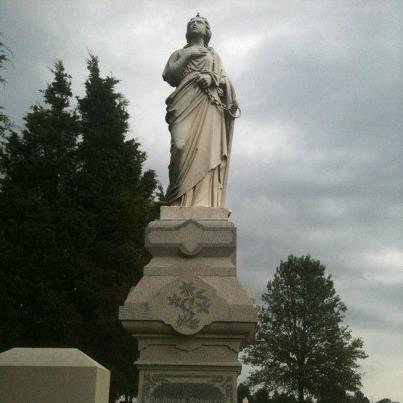
Born in Germany in 1848, he came from several generations of physicians. His parents immigrated in 1853. He graduated from high school in Evansville and he finished first in his class at the College of Medicine in Louisville in 1875. In that year he started practice in Mt. Vernon and continued so until his dreary in 1891. In those 16 years he would have seen lots of local history from lynching's, both mob and legal to the building of our court house and down town.
It's Not Guns that Kill People...It's those Darn Bullets.....1891
Back in 1891, Mt. Vernon had two Republican newspapers...The Sun and the Mt. Vernon Republican. Now these two "sheets" had been quarreling openly in their columns much to the disgust of their, let's say limited readership. Each edition tried to outdo the other with insults. Barter, the editor of The Sun finally decided enough was enough and stopped being an ass. However, Wertz, the editor of the Republican, not being satisfied, continued his warfare upon The Sun and wrote a column about the character of Mrs. Barter, wife of the editor of The Sun. Mrs. Barter upon reading the slander armed herself with a self-cocking Saturday night special revolver and went in pursuit of her accuser. She found him walking up Water Street reading his morning newspaper. She yelled at him to stop, as she desired to speak with him. Wertz, after turning around saw Mrs. Barter pull her revolver and shoot at him. He did not wait for her to shoot again, but fled up an alley, closely pursued by Mrs. Barter. Wertz ducked into his office and by that time a large crowd had gathered at the alley, and upon arrival, her revolver was taken from her and she went home. She had made up her mind to kill Wertz and she started setting type in The Sun fifteen minutes afterwards telling her story for the public. Wertz went to Squire Daniels and had Mrs. Barter bound over in the sum of $300 for her appearance at the next term of court. She had no trouble producing bail as ten of the oldest readers were more than willing to help her out. It seems the sympathies of the locals were with Mrs. Barter, a mother of five children and an "industrious and energetic" woman. The Republican article....let's just say had been refuted nearly 25 years ago when it was discussed on the streets and the Western Star did not want to go into the muck with the Republicans by reporting such rumors.
Governor Hovey Inspects Evansville Insane Hospital.....December 1890
Mt. Vernon native, Alvin Hovey spent the entire day right before Christmas at the Insane Hospital. He had been visiting the charitable and penal institutions of the state of Indiana. That evening in his hotel room at the St. George, he talked to a reporter of the Evansville Journal. "What is the object of your visit governor?" he was asked. "I come on an official visit to the Evansville State Hospital. My object is to find out the needs of the institutions in connection with the incoming legislature." "How do you like the building?" "I can say freely that outside of the Central Hospital at Indianapolis it is the best of all the asylums in the state. I find that it is well conducted, but that it needs money for its completion, which I hope the legislature will give it. I find that there will be plenty of water as soon as the pumping machinery is put in, and this will have to be done to make the hospital what it should be. This will be recommended to the legislature." Reading ahead I found that the asylum would have anywhere from 35 patients to 400 at times with a staff of about 50 employees. Sewage problems were always in the news at the hospital with a ditch running behind it that was the cause of terrible smells of human waste. Complaints were many by citizens and I don't know when the problem was corrected. This was probably the pumping and water projects the Governor was proposing. I read of water testing and lime being spread, but no solutions.
The World is Going to Smell A Little Differently Now.....1890
Mrs. Philip Yunker, who runs a grocery store near the L&N Depot, was awakened by someone raising the window of her room in which she was sleeping. A flower stand near the window prevented the burglar from entering, and while he was walking around the house to the next window, Mrs. Yunker awakened her daughter, Katie who armed herself with a revolver and as the man was in the act of entering the room fired and the ball cut off the end of his nose! The town was considering a medal for her "pluck and good marksmanship."
A Little School Ditty from the 1890's
"Ram it in, cram it in, children's heads are hollow. Rap it in, tap it in, what are teachers paid for? Bang it in, slam it in, what are children made for? Scold it in, mold it in, all that they can swallow; faces pinched sad and pale, and tell the same undying tale. Tell of moments robbed from sleep, meals untasted, studies deep."
Recollections of 1890's by Viola Kohler
Through a series of notes she put down probably in the 1970's I have been able to glean some very interesting local stories of the decades of her life. Born in 1892 here in Mt. Vernon she seen quite a bit of what life would have been like as in a time machine. Some of her earlier recollections were that in her pre-school years she had her ears pierced by A.A. Graham who ran a jewelry store at 224 Main Street. The thought was in those days that piercing the ears strengthened the eyes. Hmm. maybe I should try that! Because she did not cry she was awarded some ice cream across the street at Dawson's Drug Store. She remembers the adults talking about the Spanish American War as a large group of Posey County men went to train down south, but never actually saw action. Like most wars, hysteria takes over and in this case, her grandfather told the civil war stories of decades before. "Remember the Maine" replaced "Remember Ft. Sumter" just like it replaced "Remember the Alamo." One day Viola said everybody went outside around noon and looked into the sky. Someone had said the clouds had formed a reflection of the American flag and it was a sure sign of victory. The boys came home. She recalls one day doing some shopping at a grocery at 346 West Fourth Street ran by Peter Egli. The store was crowded and no one was paying any attention to her as they were all huddled in the back of the store bent over something. That something turned out to be a machine and everyone had tubes coming out of their ears listening to voices......it was phonograph, the first she had ever seen around 1896 or 1897.
1880's
Teacher takes flight, returned and fined.....1889
The "colored" school teacher, Chas. Jones left for Evansville for a week after assaulting one of his pupils. He was returned to Mt. Vernon and plead guilty. He was fined $1 and costs, amounting to $14.75.
Politics.....1888
As November approached Mt. Vernon was busy placing Democratic poles into the ground and having rallies, meetings, and stump speeches for local candidates and especially Grover Cleveland for President. Saloon keepers were rapidly replenishing their stock of bottles of enthusiasm. That year we were at peace and the economy was prosperous but the incumbent Cleveland was defeated in the Electoral College even though he won a plurality of the popular vote. Hmmm. Seems like I heard that before recently. Some things never seem to change. Benjamin Harrison was elected from our state of Indiana even as Posey County went to Cleveland as we again put ideology above regional interests. The tariff policy was the principal interest that year with Harrison taking the side of the industrialists, while Cleveland denounced the tariffs as unfair to consumers and free trade. The only other years when a President was elected without a plurality of popular votes were in 1824 when John Quincy Adams was elected by the House, in 1876 when Hayes defeated Tilden, and in 2000 with Bush over Gore. Harrison became a one term President as Cleveland won in 1892. Harrison's term was characterized by high federal spending and the unpopularity of the high tariffs. Harrison did however have two issues on his side I would have supported: federal education funding and legislation to protect voting rights of African Americans.
Mayor Not too Popular at Present....December 1887
Writer B.R. Otner, was the local correspondent to the Evansville Daily Courier back then and it had this to say of local happenings: "Maj. Terry, the temperance, anti-temperance, featherweight mayor of our city, can carry more water on both shoulders than any official we ever knew or heard of. Week before last he took a temperance fever and appointed a special policeman to compel the liquor men to close their saloons at 11 o'clock and on Sundays. A few days after his fever became terrific and he appointed another policeman to see that policeman number one should let no guilty one escape. A general howl was raised and his honor fell from grace. He at once declared the offices he had so recently created vacant. The element favoring the enforcement of the liquor laws stormed the fort and the policemen were reinstated. This time the vigilance committee received instructions from his royal highness to close every business door in the city that should be found on Sundays. In accordance with instructions the specials, including Mr. Mayor gave orders to our bakeries, restaurants, meat shops, confectionaries, etc. to suspend business from Saturday night until Monday morning. These orders were not observed and trouble is brewing. These laws bring the cause into disrepute and should be discontinued and ignored."
"Better Dead than Red?".....May 1886
A local resident on upper Second Street killed his wife with an old musket. The old soldier had served in the Civil War and was captured and tortured in Andersonville, South Carolina prison in 1865. Since his return he had suffered a mental condition. It is believed he mistook his wife for a "Socialist." He claimed she had been following him for several years and he had had enough. In jail the old vet tried to take his own life. He was ruled insane by reason of his war experiences and was taken to the Evansville asylum.
New Harmony Battles Snowstorm of January 1886
It was a bad day! A cold wave reached the little town and a violent snowstorm, the worst in many years played havoc as the wind blew a gale, piling up snow in great drifts and rendering traffic extremely difficult. By early evening the mercury in the thermometers hit zero. To add to the misery, the fire alarm sounded and the people rushed from their warm stoves into the blinding storm, not knowing which way to turn. The alarm was discovered to be from a chimney fire at a local residence. The Fire Department pushed out the old "engine", but fortunately, it was not needed. A large snow plow was rigged up the next day and drawn by real horse power and pulled through the streets. One victim of the blizzard was Frank Fretageot's pet alligator, "Jumbo" who succumbed despite efforts to "thaw him out."
Stud...Lord Baron.....1886
Thorton Neale brought in what he said was a celebrated Holstein Bull to Mt. Vernon and rented space in a local stable for breeding. He invited parties willing to breed to call and examine the big fella. Offspring were said to be large and handsome and for milkers..."no equal." Good job if you can get I guess. In order to encourage the raising of Holsteins in our area, Thorton reduced his rate to $3 and insurance.
Fire Wagon Came Late, Stable Met it's Fate.....October 1885
The Old Damron House stable went up in a blaze of glory. When discovered, at about 4 in the morning, the west end was in a blaze as the old thing was a huge tinder box and no effort could be made to save it. "Owing to the rather tardy appearance of the fire department, the flames communicated to the one story brick residence across the alley." The north end of the Brettner Hotel ignited and was burning rapidly when the boys made the scene and it was "dampened" out. The stable was occupied by the transfer company of Downey & Harlem. The residence of Mrs. Thomas was total and she had no insurance, but much of her household items were saved. She had moved in just the day before....poor thing.
Painted Ladies, Oh So Shady.....1885
Mr. Leffel, editor of the Western Star newspaper got an "eye full" as he walked down the street and spied four young ladies, who had respectable parents, walking up Main Street. He inquired of a party, who knows, who they were visiting. He said, with surprise..."Don't you know?" The editor shook his head to the negative, and the party remarked, "They are living a life of shame." Well, Mr. Editor wrote that the parents should be notified of the matter. I'm sure it wouldn't matter much as usually in those days the "soiled doves" would only be hauled in front of a judge and fined just a small fine, enough to make respectable citizens satisfied and released. When the names of the girls were known as prostitutes they would become so ostracized that they would have no opportunities for marriage unless they left town, but would have new clients if they remained. And while Leffel was at it he saw two local young ladies he knew in Evansville with a "flirtation being carried on" with unknown men. He urged the girls to be careful, away from home.
What Are the Odds?.....1884
A letter was received by the Circuit Court from a lady in Iowa saying that in 1832 her father buried a tin trunk full of gold and silver in this county, He died suddenly and failed to tell where he buried it, she is inquiring to see if anyone knows of its whereabouts. Hahahaha...like that is going to happen. I mean there are many honest people in our piece of Indiana, but I doubt she ever received information that was helpful or the gold.
Let's Hear It For Grover!!.....1884
When the name of the nomination of Cleveland and Hendricks were received in Mt. Vernon, the old cannon was brought out and thirteen shots fired in honor of the ticket. The city is pleased as Hendricks, a Hoosier had visited Mt. Vernon in the past and the prediction is they will win in November. The prediction was correct. The ticket of Cleveland and Hendricks defeated the Republican Blaine and Logan 2773-2157 in Posey County. The Greenback-Anti Monopoly Party and Prohibition Party candidates received little support.
Smallpox Quarantined Off Shore.....March 1883
A large flatboat was fixed up by the Board of Health as a "suitable pest house" on which small pox patients of Mt. Vernon were quarantined. The boat was anchored downstream on the Ohio River outside the city limits. Although isolated, patients were seen daily by a doctor.
Posey County Beast...Is He Human.....1883
Of course he was, but it goes to show you how cruel we can be. The "wild man" was captured in New Harmony after being observed for several weeks and described as "half human and half animal." Mr. Robbins, a New Harmony farmer and three of his hands found the "creature" sleeping in a cornfield. He was tied up and delivered to the New Harmony jail. "It was not determined whether the hair covered subject is male or female." It was described as being of unusual strength, eyes close together and weird shaped, and was unable to hear or speak. Soon afterwards another wild man was sighted in Point Township and transferred to the Posey County poor asylum in Poseyville. "He lacked all human and civilized traits," it was said. Deaf, dumb, nearly blind, the figure in clothes of rags, hair streaming down in wild disorder over the shoulders and gave the appearance of insanity. Damn Hippies!!!
ld City Hall Fire House Bell Manufactured in 1882
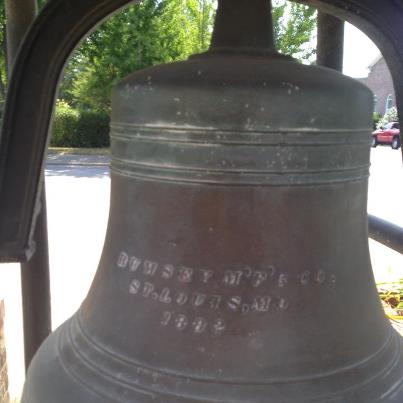
After the Great Fire of 1880 on Main Street, the town started to get real serious about a fire department. This bell after the organization of a Fire Department and the date 1882 and the manufacturer, Rumsey Manufacturing of St. Louis are still clearly visible. Our City Hall was constructed in 1893 and the Fire Department had a home. Back then we had one fire wagon pulled by horses. The feed for the horses was in a building located in the rear of the present addition that now houses the motorized trucks. Pop Fessenden said that in the days of the fire bell, the Chief could hitch a team and clear the firehouse in 38 seconds! "Pop" left the department in 1935 after 25 years of service and he said the bell became too heavy for the belfry over time. Its service was no longer needed as it was replaced by a steam whistle. When taken down it was covered with dirt and rust. Sand blasting by Leonard Wentzel who used this tool for tombstones was called and he brought back the bell's shine. The 700-800 pound bell now sits on Main in front of City Hall.
Not Only Santa Was Out on Christmas Eve.....1882
Our law enforcement was kept busy searching down the vandals who disturbed our "Peace on Earth" good cheer moments of the Holy holiday. There was a fight on West Second Street involving our fine grocer, C.F. Tente who was cut over the eye with a broken beer glass and stabbed in the left shoulder by rowdies. Marshall Paul caught one of the rascals, but two others escaped his long arm. Throughout the town, "devilmen" removed gates, pulled down fences, and stolen signs. Two other fist fights were reported with nothing worse than a few black eyes to view the Christmas ham the next morning, but there was a accidental fatal shooting in Belleville. Christmas morning little Harry Kahn, shot part of his little finger off with a pistol he received under his tree. 'Season's Greetings!'
Wonder if this ever happen to Herb Alpert?.....1882
As was customary on Thursday evenings the young men of Henry Brinkman's Brass Band practiced on a platform, not quite what you would call a stage. Doing what must have been a spirited rendition of maybe an earlier version of "The Lonely Bull", the structure gave way and all of a sudden it had to be blood, sweat and tears written all over it. Nobody broke their trumpets in their tumble of several feet, but when untangled they found there were no serious injuries. Play on Gabriel! "A one, a two."
"Times get rough, when you ain't got enough, to buy a bottle of wine.".....1882
A steady rise in the price of commodities has caused some thirsty souls to move towards crime. Thieves broke into the Catholic churches of St. Phillip and St. Wendel but took nothing, but drank all their sacramental wine. "Let me go home and start over."
Cat House Fight.....Everybody Goes to Jail...Sort it out Later.....1882
Law enforcement was in no mood for this one hot July day. All week peace officers had been filling up the court with robbers, drunks, and even a guy using some sort of trick device to take citizen's hard earned cash with a game of chance. Now here comes a knock down and drag out fight at the local bordello on Saturday night. The Marshall and his deputies were called in to separate the maids and the men. Everybody was flapping their gums and yelling and screaming, so Marshall Paul took the whole bunch in. Several men were eventually charged with assault and battery, one for being a pimp and the girls were charged with prostitution. His Honor I imagine was not too happy to be called out of bed once more to charge the hedonistic warriors with their crimes.
Strange Happenings of July 1880
Seems to have been a sort of weird month that year starting with the tragedy of a six year old boy dying when he fell into a kettle of boiling water. There was a knife fight in Farmersville that left several severely injured, and a man in Stewartsville was badly injured also when ran over by a steam locomotive. That's got to hurt! In Bethel Township a farmer, William Robinson and his mule were killed instantly when lightning struck his buggy. The Women's Christian Temperance Union was on the war path in Mt. Vernon and Evansville banging their tambourines and hollering to the drunks. They just ignored them and danced a jig in front of the saloon. Citizens rose up signing petitions to request immediate action on the rickety bridge across the creek on West Fourth Street. Finally, patrolman Hinch arrested a man who tried to break into a home and the lady of the house quickly hit him over the head with a heavy crock.
Pausing in the Wake of a Slumbering Snake.....1880
I know they are not evil, but "I don't like spiders and snakes" or "Dead skunks in the middle of the road," either. About snakes....John Ritzert of Marrs Township killed a common black snake that was 22 feet in length. If that is common, Wavy J needs to stay out of the woods! Now two years before that a William Curtis sighted an immensely long snake on his farm, two miles northwest of town. Two years later, several farmers in the Brewery Hills area think they saw the same curly creature. It was judged to be about 25 feet long and a foot thick. My oldest son, Nathan collects these strange reptiles and then has to feed them live creatures too. Must be something on my wife's side of the family! LOL.
Local German Paper, "The Wochenblatt" Looks Back a 100 years in a Poem to 1780.....1880
Local historian Ilse Horacek translated a poem into English for us hometown people in 1980: "One hundred years ago, it seems, was mostly like in our days. Upon the poor and rich alike the sun was shining down her rays. Honor among most men prevailed, and justice proudly did her reign and always did the ground get wet, when clouds would send the needed rain. But some things, for us now old, were yet strange for them by far. For instance, no one thought to ever see a railroad car. Machines with steam they did not have, nor telegrams racing through the air, and hardly ever would you see such finery upon the ladies fair. One hundred years ago they only knew, with hands a man must sow and thrash, never one in government considered taking bribe or cash. They had in America, 'tis true, their sauerkraut and spaetzel, But nowhere in this fair land was there lager beer or pretzel. The Colt revolver was not yet, nor "Ole Dominion" coffee pot, The men who thought of things to come, had to invent still quite a lot. No "likeness" on a photo then-your face on paper wasn't there, Nor could a maiden with her beau, visit a circus or the fair. All of this, and more, they missed-a hundred years ago, But then they had, what now we don't, more honest folks-it's so, For whether poor the man-or rich, he always, sooner or later Would come around and gladly pay, for what he owed for his newspaper."
Bring Your Glad Rags; Here Comes the Glass Boat.....1880's
No they were not made of glass but were so-called because of their stock of glassware of all kinds, from the fine French china, manufactured in Cincinnati, to cut glass from Pittsburgh. Trade after the Civil War was very important from Pittsburgh to New Orleans. Trading scows or "Yankee Notion Boats" followed the crops when they ripened through the Corn Belt, the cotton belt and down to the sugar cane areas trading with the citizens. Residents locally would save rags and broken glass so that they might have something to trade for dishes when the boats came in. Brides to be stocked their hope chests and hunters brought in skins, honey, and pecans to trade for goods. Upon their arrival in town the banks of our levee were strewn with ciders and ashes for a foothold upon the clay bank. A bell clanged from a pole at the wharf to welcome the boat and townspeople soon were heading that way. Handbills were handed out advertising the wares and sometimes there would be an added attraction to draw crowds like a performing bear or a large alligator. Most of these glass boats were barges with a cabin for displays and living quarters. Sets of dishes, vases, glass bottles, lamps with tinted kerosene were shown. They even traded at night as flaming oil flares on tall poles on the banks marked the entrance. On the boat would be hung lanterns filled with lard oil. These boats just drifted down the river by the current. They were sometimes propelled by an oar astern which served as a rudder and a short oar called, a gouger. These were mostly used just to maneuver out of shallow water. The journey was a one way passage as when they arrived in New Orleans the wood was sold for building purposes and the cargo obtained on the trip was returned upstream by steamboat. Eventually, traffic became too heavy for the small craft to survive and they disappeared forever.
That's A Lot of Sausage!.....1870"s-1880's
Mt. Vernon was a good market for pork and numerous pork packers sprung up. There was one on lower Main Street ran by Judge H.B. Wilbur and E.T. Sullivan had one around Vine Street. Employment at the pork house was increased during the winter months and Wilbur was said to have shipped as much as one million pounds of pork in a single season, besides what was consumed in our community. Allowing 250 pounds as an average, this would mean that they handled at least 4000 porkers in one season. Bet they wished the only think they smelled down town was hominy!
1870's
Game Called..."Hit the road Jack, Don't you come back no more, no more.".....June 1879
Deputy Sherriff Hayes, Constable Erwin and Marshall Musselman made a raid on a gang of tramps, numbering sixteen at Black's Grove. When they got there the tramps were playing baseball. No report of the score. Brought before Squire Daniels they were released following a declaration that they would leave the city.
My Favorite MV Newspaper Editor.....circa 1879
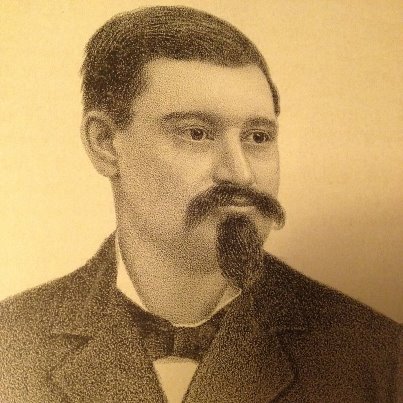
Albert A. Sparks was named right! He sure could cause them. The man was an unswerving Democrat and angered Republicans so much in Mt. Vernon they started to quit the paper and withdraw their business ads. Didn't bother him any...he would attack their family and their reputations. I don't like him for what he did or who he was or even his political party; but I love reading his editorials and the passion he brought. He was born in Kentucky in the 1850's and seems to have only had an elementary education in English. However at age 12, he learned the printer's trade and soon got a job in Louisville with the Evening News. By 1873 he was employed as a compositor and the Evansville Journal. He went down south and worked in New Orleans and worked on newspapers for two years. In 1877 he returned to Evansville and reported for the Courier-Journal. In 1879 he seized the opportunity and bought the Mt. Vernon Democrat, then a weekly and "let us have it." He was bold and fearless. He reported national news slanted to form a positive to the Democrats and a negative to the Republicans. He attacked every possible position of the Republicans and criticized the drinking of Grant and even our "favorite son", General Alvin Hovey. He jumped on corruption at the County Fair and the fact it was held in the middle of nowhere in New Harmony. He bitched about roads, prostitutes, Negros, immoral women out late, the city council, hobos, bridges, carnival riff raff, gypsies and everything else to sell papers. He even became postmaster in 1885. Eventually he moved on to bigger things, I think back to Evansville and to Terre Haute it was rumored. He was a gunslinger always looking to draw attention.
Down to Last Dollar, Old Confederate Gives it Up...Reluctantly...1878
In 1878 a rebel vet named Dobey left South Carolina for Tennessee with his family. Ill fortunate went with him for a while, for their home burned down and members of his family became ill, so that when the only money he had left was an old silver dollar he had since the war. Mr. Doby goes on, "Not a dollar has since fallen into my hands without my scrutinizing it to discover those initials. In 1925 a man called him on the street and said, "Here is that dollar I owe you." As had been his custom for forty-six years, he looked for the initials and to his great joy that dollar had the letters W.E.D. engraved on it!
More Violence Preceeding the Mob Killings of 1878
A friend at work, Keith Russell handed me a article about local history that included the lynching of Negro men of October of 1878 at the court house lawn. I have written on this several times in all my volumes, but more things continue to come to my attention. This article was written by Harold Morgan for the Maturity Journal newsletter this spring. Preceding the October murders there were many sordid events that occurred say from June onward. I had heard of the KKK in Mt. Vernon and the state, but more in the early part of the 20th century. There was this other group called the Knights of the Golden Circle (KGC), often called "night riders." I'll get back to that in a moment. In June, a white prostitute, Anna McCool was murdered in town, allegedly by three Negro men. A Negro man was arrested in Evansville in July for the crime, but was released for lack of proof. The Evansville Journal newspaper charged that within a four month period, four murders and four rapes had been committed and at least one was of Negros from Mt. Vernon. All this is starting to stir up the locals as they see crimes being committed and no one seems to be brought to justice. Now it was very common to have lynching's in our area during this time. I have seen them reported many times in the tri-state. In late August, Henry Verling of Mt. Vernon was alleged to have been murdered by two Negro men and on October 10, four Negro men were arrested for the rape of three white prostitutes. Some sources call this a setup between two rival prostitution houses and a closely contested sheriff's race. Negro men were welcomed on Monday nights at this particular house, but this was a Thursday. I won't go over the hangings again, but this vigilante committee formed at Black's Grove, then near the northern edge of the city limits and wore their clothing turned inside out when in action, masking their heads with hoods and face paint. I knew of that, but I didn't know this was a trademark of the KGC. An exodus of Negro residents occurred shortly afterward. Reports locally of white men driving through the Negro neighborhoods and giving them 24 hours to leave. Some left their property behind and walked to Evansville. A comparison of the 1870 census to the 1880 census is said to show that the black population dropped by a half. Nobody ever went to jail for the lynching's or the man thrown in a train's firebox alive. The following March, George Caldwell, a Negro, vanished out of our new county jail and was never seen again.
NY Times Writes of MV Mob Lynching.....1878
"The victim's characters were all bad. Jim Goode recently pardoned out of the penitentiary where he had been sent for rape. Chambers barely escaped conviction for the murder of Pat McMullen of Grand Chain, on the Wabash, last fall, by posing an alibi by a number of Negros, who it is now known have since boasted of how they got the n****r loose. Goode recently made an attempt to decoy a lady out of her home at night during the absence of her husband. Jeff Hopkins was arrested for the murder of a white prostitute last summer, but could not be identified and he and Ed Warren are suspects of the murder of Duffy, the dyer, a few weeks ago." Our Democrat editor said, "It is true that only a short time ago the citizens of this community took the law into their own hands and revenged the murder of one of her more respected citizens as a outrage upon a number of white women by negro desperadoes. While we are not encouraging mob law, we feel justified in saying the hanging of these negroes was one of the things necessary for the welfare of the community."'
I Told You Mt. Vernon Democrat Editor Was A Tough Old Coot.....1877
"A wasp came buzzing to his work, and various things did tackle; He stung a boy, and a dog, and made a rooster cackle. Upon the editor's horny cheek he settled down to drill, He prodded there about a week, and broke his little bill."
Wabash Valley Flood of 1875
It's terribly hot here in early July of 2012 and I came across a hot summer of 1875 in the tri-state area. That year the summer started with a drought or drough as they called it back then. The two months of June and July had been uncommonly dry....sound familiar? Corn, grass and all growing vegetation were suffering for rain and the religious devout began offering up their prayers to the almighty for relief in the form of rain. I guess they over did the thing. On August 3, there was a heavy rain. "Yeah," said the people as they rejoiced, and they were all certain that thousands of dollars of crops would be saved. The next day it rained again, much harder than before, and it kept on raining day after day. Each morning it would be bright and clear with a promise of a good day and then around 10 it would begin to pour, without lightning or wind, but rain straight down for hours at a time. The lowlands became flooded and the corn was destroyed. It was as high as a man's shoulders when the rains began, but in a short time it turned black and fell. Great fields were ruined. The water ran down the furrows and washed great gullies and uprooted much of the corn. Wheat standing in the shock began to sprout. Men tried to salvage the wheat by entering the fields and begin to uncap the wheat shocks to let the wheat dry. They would take their scythes and mow down the high weeds from around the shocks, but it was all for naught...the harvest was ruined. Let's hope history doesn't repeat itself.
"And your mama wears,".....1874
The Mt. Vernon Democrat said, "I know New Harmony people can count, but I didn't know they could read." New Harmony Register counted with, "We aim to give pleasant reading, but the Democrat who cries aloud and demands peace, harmony, and good will, must be accommodating and meet us half way. It must not expect all the peace to be on one side."
Fourth Street Bridge.....November 6, 1870
A bridge was nearing completion that should be ready within a week for public use. It was 176 feet in length and 16 feet wide with the highest trestle being 34 and one half feet. The construction was under the direction of Mr. Springer and he was praised for its quality and coming under budget.
"I said Shotgun, see the boy run now!".....October 1870
"All is well that ends well." That old adage was verified in Mt. Vernon that autumn. You see a youthful pair, the boy about seventeen and the girl closer to fourteen, loved well, but not wisely. The loved in secret and thusly for some time without creating suspicion in the minds of friends and family until a time came when the young lady began to cast a shadow. The two lovers now became aware of the consequences of their indiscretions. The parents of the girl were informed and at first the old man threatened to make sausage meat of the young seducer, but thought better of it. The father said, "the best thing under the circumstances is to get a license and call Squire Campbell to perform the ceremony...here is the ultimatum: Marry or die." The youth couldn't stand the pressure and the ceremony was performed. Good luck!
General William Harrows Last Words.....September 1872
Posey County's controversial Union General William Harrow died in a train derailment while campaigning for Horace Greely for President in 1872. His last words were said to be: "I lived like a hero, I would die like one. Tell my wife. God receive my spirit."
Thankfulness of Freedom to the Republican Party Held...April 1870
The Evansville Journal reported that "colored" citizens of Mt. Vernon met at a local grocery store and Mr. Edward Carten presided with Mr. Columbus Johnson, secretary. Speeches were made and one gentleman was called out twice. The meeting was chiefly one of " congratulating their fellow colored citizens on their admission to their long denied rights, and expressions of thankfulness to the Republican Party for the tenacity with which it persisted in pressing the admission as a simple act of justice." .... "Resolved: That Almighty God in the privileges conferred upon us as a man. Resolved: That we acknowledge as our friends the Republican Party. Their principles shall be our principles; their prosperity shall be our prosperity......Keep faith with those who have, by their perseverance, their treasure and their blood, conferred upon us the highest rights of citizenship."
Books Delivered...No Not Mine...Dr. Owen's.....March 1870
The geological cabinets of the late Dr. David Dale Owen of New Harmony were sent on the steamer, "West Wind" to what was then Bloomington University. One of the most valuable collections in the United States weighing about 30 tons was sent to the fine university. Owen was the first geologist for the state of Indiana from 1837-39 and he did the first geological surveys of Indiana, Kentucky and Arkansas. He was the son of Robert Owen, father of New Harmony. His brother Professor Richard Owen was his assistant to his brother in surveys in 1849 surveyed the northwest shore of Lake Superior. Richard, also of New Harmony later was professor of geology and chemistry in the Western Military Institute of Kentucky. In 1850 he moved back to Indiana and became also the State geologist. He was in the Civil War and participated in the siege of Vicksburg. He returned after the war and filled the chair of natural science at Indiana State University. He was offered the presidency of Purdue University but declined. In 1869 he toured Europe and also ventured into Turkey, Egypt and Palestine.
"James Gang Rides Again".....1870's
A hundred years later a nice little band by that name led by Joe Walsh had a few great albums; but that's another story. I had heard that the outlaw gang of the nineteenth century use to run from Kentucky to Indiana to Illinois to Missouri crossing in point township along the way. It's the story of legends, but B.O. Hanby a historian of Posey County maybe sixty years ago would lecture on the James boys in our county. He learned from old settlers of the county about the stories true or not. There was this Zimri Gale, a farmer and auctioneer who lived with his wife and daughter in a shack in a isolated place called Welborn's Switch. One rainy day, the story goes, three men on horseback approached the house looking for bedding for the night. Gale was afraid so he took them in. The next morning he noticed one man on watch with two revolvers sitting in the window sill. The conversation in the morning got a little weird. One man said, "If Jesse James should come to your house, would you be frightened?" Gale didn't know what to say except that he had no valuables other than a farm mule. Although Gale insisted that they didn't pay him, each of the three men left a $10 gold piece for Gale's daughter. In 1907, Gale attended the Mt. Vernon Fair, then held at the fairgrounds, east of town. At that time Frank James had been pardoned by the government and was living as a honest citizen starting horses at various fairs. Gale dropped by the Kahn Hotel and James asked Gale where he had lived. Gale said he once lived on Pea Ridge, west of town and Frank James drew silent. "How's the little girl," he said. "She must be a fine lady by this time." Gale replied, "Yes she is and is recently married to a good husband."
1860's
C & A Wasem Company.....1869
I come across this name every once in a while of a grocery that existed in what most of us remember where the Tresslar building is today. I was curious about it and did some looking. I had seen a calendar with the name Wasem Grocery from around 1908 or so before, but not much else other than a few ads in the papers. It seems there were these two brothers Charles and Andrew from Bavaria in Germany, Charles being 13 years Andrew's senior. Charles immigrated to the United States first coming over in 1858, living in Ohio for one year and then to Mt Vernon in 1859 finding work as a clerk in the grocery business of Andrew Glass. At age 28 he enlisted in the Union Army and served 100 days in 1864. Coming home, in 1865 he started selling retail liquor, which in Mt. Vernon was always good for a profit. He went back to Germany for six months to visit, then came back and built his business on Main Street. Andrew took a different route learning the cabinet maker's trade as a teenager in the cities of Germany. He seems to have come over at the end of the Civil War, visited Mt. Vernon then went to St. Louis and Louisville for cabinet working jobs. In the early 1970's he returned to our fine town and started clerking at a competitor of his brothers. He then started working with a guy selling liquor. This had to be getting persona with Charles, wouldn't you think? Finally the Republican Charles and the Democrat Andrew came together and started selling groceries. I guess they sold other things to as I have a advertisement from 1879 saying they sold mackerel and fish, queens ware, fruit jars, sat, cigars, tobacco, dry wood for kitchen fires, lime and cement too. Andrew tried his hand at politics too...being a Dem he had a good chance in old Posey. I'm not sure what position he had here in town but I know he was re-elected. Bet Andy and Chuck had some good discussions around the Thanksgiving table...one left one right; one Lutheran one Evangelical......both were Masons too, so probably a bunch of secret stuff to talk about also in whispers over a cigar.
A Fight Occurs Between Teacher and Student.....January 1868
A "pugilistic" encounter took place in the High School, one Thursday morning between the teacher and one of his students. It seems the teacher wanted to correct the pupil for some breach of discipline, but he refused to stand the chastisement and "pitched into the teacher and in turn the teacher went into the pupil and drove him from the field in disorder." The pupil filed an affidavit against the teacher of which I have found no verdict. The newspaper said, "While we are not prepared to say who was in the right or wrong, we think the teacher should be sustained by our citizens. If not you may as well close the school room, or turn it over to the pupils."
Republican and Democrat Editors Spar Off.....1868
New Harmony Register editor went after democrats saying, "There are not 25 honorably discharged democratic soldiers in Posey County." He used the words of the war like "Copperheads, Rebel Demons, and Traitors." That didn't go over well with the Mt. Vernon Democrat editor, Thos. Collins who blasted the smaller "Republican" paper as "disgraceful, lack of courtesy towards democratic soldiers." He then went on to bitch at General Harrow and said the New Harmony editor must have been in his normal condition with him..."drunk." Collins went on his rant condemning the republicans for wanting to give the "colored" the vote. This of course was ratified as the 15th Amendment in 1870, but not be fully recognized for almost a century during the Voting Rights of 1965 Act. Until then rights of African Americans, especially in the south and some northern states was hampered by poll taxes and literacy tests.
Mt. Vernon Got Onto Baseball Real Quick.....1868
Mt. Vernon was quick to accept baseball following the Civil War. Many references are in the newspapers even some box scores in the 1890's. By 1868, Mt. Vernon, Shawneetown, and Evansville had established regional competition. The Evansville squad was so motivated that they took their entire squad by rail to witness the first professional team, the Cincinnati Red Stockings in their first year of pro ball vs. the Brooklyn Atlantics. Cincy gave a salary for eight months to their team and they went 57-1 that first season.
Central School Cornerstone Laid.....1867
Mt. Vernon had a few little schools within the city at the end of the Civil War. These were scattered throughout different regions of the town and they were proving to be inadequate. One of these was the Foster schoolhouse erected on Store Street as an academy. Another was called, "The Little Brick" which stood on the northeast corner of Main and Sixth Street. The third school was the seminary, built by money appropriated by the legislature. It was on the west side of Main almost apposite the intersection of East Tenth. A new school was proposed. It was on land then called College Place. It became Central School and was torn down in 1910 for another school, then it burned in 1945 and we replaced it with Hedges Central. The contract for the building went to Edward Brown in the spring of 1867. He sublet the brick work to Thomas Allen, a noted Mt. Vernon brick contractor. The building cost $17,000 and when it was completed it was in the form of a Greek cross, the center section extending north and south with an ell on both the east and west sides. It contained eight rooms with four on the first floor, and four on the second. There were four hallways. The building was surmounted with an octagon dome or belfry which contained an ancient school bell. A janitor's residence was also constructed on the northwest corner of the school grounds. The cornerstone was laid in 1867 and the city made a holiday out of it. All business houses closed in the afternoon and people turned out in masse. The New Harmony Band even showed up and there was a parade. Mt. Vernon loved a parade. That was always something to do and show civic pride and make the kiddies happy. The parade marched around then assembled on the school grounds where a large platform had been erected, so large even the band climbed up. From there we had choir songs and solo singers, a few prayers from city pastors, elaborate speeches and representatives from the secret societies of Mt. Vernon. They must have talked it to death with speakers....they had the Hon. Milton Pearce, the Hon. James Laird, the Hon. John Brownlee, the Hon. Wm. Edson, the Hon . H. E. Pitcher, the Hon G.V. Menzies, and well you get the picture.
It is said that Military Governor of Tennessee and soon to be Vice President and then President, Andrew Johnson spoke to the settlers of south Posey County on a stump near the Big Creek covered bridge at Solitude in 1864.
Evansville Daily Journal Goes off on Democrat After War Story.....1864
Democrat reported that union officers had entered homes of the southern people and stripped them of jewelry, plates, and furniture and did not turn them over to the government but filled or intended to fill their homes with their booty. Democrat said, "I guess we will have to build another penitentiary in Indiana." The Daily Journal took exception: "We regard the charge that the officers of our armies have been engaged in indiscriminate pillage as a base slander. We dare the Democrat to name a single instance that has come under its own knowledge. We want no hearsay stories; give us an instance that you know to be true." The fact was an investigation under the order of General McClellan did find evidence of robbery. What I find interesting about this story is the date. The banner on the Mt. Vernon Democrat says, "Established 1867." Looking over a history of local papers it seems there is a gap between the first paper in 1838 called the Courier and the establishment of the Democrat in 1867. It says various other weeklies were published and discontinued over the years. The Democrat I saw referred to as the Daily Democrat at times. Possibly an earlier version used the term Democrat in some form. By the way, a 1864 Democrat was found by the Bouslog Abstracting Company in a search in the archives of the court house sometime in the 20's or 30's. It was published by C.S. Legge at an office on Main Street over the C. F. Leonard store. It was four pages of hand-set type. The lead editorial of the issue deplores the re-election of Abraham Lincoln as President closing with this paragraph: "the nation has chosen despotism and we do not intend to oppose its choice. If they can stand it...we can. "
Home Guards Thieves?....1864
According to a book called, "Towns and Villages along the Lower Ohio" the Mt. Vernon home guard in the summer of 1864, made up of "rough and general riff-raff and scum" helped themselves to whiskey, salt, and other necessities in Uniontown and surrounding settlements.
Off to War.....July 20, 1861
I was reading the New Harmony Advertiser and I read of the Posey County Cavalry marching from New Harmony to Evansville. The day before the part of the company from Mt. Vernon went into camp for the night at the Fairgrounds. On Tuesday morning the entire company met at the camp, formed a line, and marched into town as far as the residence of Hon. R. Owen, where they were halted and each man presented with a pretty silk pin cushion, full of pins, prepared for them by the young ladies. They then marched through the principal streets receiving the hearty good wishes of our citizens who had gathered in great number to see them depart. They called it an imposing sight to see so many men, all well mounted, marching in a body through town, following their flag held aloft by Mr. D. Wilsey. The officers, Captain J.K. Highman and Lieutenants Forth and Owen led the men. "May glory and success attend them," the Advertiser proclaimed.
Great Division of Opinion.....1861

You know Abraham Lincoln never won an election in Posey County, nor did U.S. Grant....still when Ft. Sumter was fired upon, Posey County responded with several thousand men. Enlistments were around 3000; but that includes some men who enlisted up to three times. Our area was settled by many men from the south and mistrust of eastern "Yankees" prevailed. Many felt the federal government had no right to coerce a state..."State Rights," became a cry. Union orators came to our county before the war addressing the people and spoke to their patriotism in mass gatherings. The first troops from Indiana were not from this area because we were so far away from the capital...Indianapolis to secure weapons. But in August of 1861 two full companies of Posey County soldiers, Companies A and F of the Twenty-fifth regiment were mustered into service. The First Calvary regiment of the Indiana Volunteers contained three companies also of local men. Companies A and F took part in Sherman's famous, 'March to the Sea." The Captain of Company C of the Calvary was killed at Fredericktown Missouri. There were also Posey County men in the Fifteenth and Sixteenth regiments of which Richard Owen of New Harmony, a famous man in our local history was commissioned Lieutenant Colonel. Alvin Hovey was known for his leadership during the war. Too many men to remember at this time and I have left out some of the companies added later in the war. Eventually, over 180 men were drafted from Posey County when enlistments dried up. We had some confederates too; most never came back. After the war some confederate soldiers settled here and they were respected more than the ones born here who joined "Dixie." I read of one story locally, where a union soldier and a confederate soldier sat down and discussed the Battle of Shiloh together.
1850's
John Chappelsmith illustration of Posey Tornado of April 30, 1852.
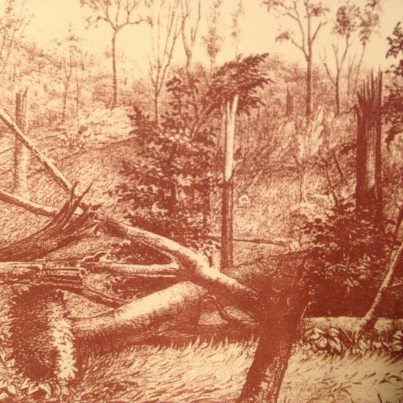
This tornado traveled 250 miles across three states starting at Golconda, Illinois and knocked down trees like "falling soldiers in a hail of bullets." It was believed that 7000 trees per minute were felled with massive hail preceding the twister. In Posey County, the storm was about one mile wide and ten miles long. Mt. Vernon was unharmed. The drawing above was published by the Smithsonian Institute in 1855 in a study of the great tornado. The Smithsonian itself was established by Congress a few decades earlier much through the efforts of New Harmony Representative Robert Dale Owen. The tornado crossed the New Harmony Plank Road, five miles south of town at 5 o'clock in the afternoon. The destructive power blew away buildings, unroofed cabins, tore trees up by their roots, and twisted the tops of trees off, scattered fences, and killed people and livestock. Around 3 in the afternoon, a cloudy day with a temperature of 61 degrees began to rise to 81 degrees. The clouds were coming from the south and the wind was calm; sounds of thunder were in the distance and at 4 PM the first flash of lightning was perceptible with slight rain and thunder. By 4:30 the rain came in torrents, the wind blew in all directions with flashes of lightning and thunder...there were showers of driving hail with some stones measuring eight inches in circumference and weighing a quarter of a pound. Almost every window in New Harmony facing westward was broken. This was the largest tornado ever seen in this area to that time surpassing the New Haven tornado of 1839. This storm was remembered until 1925 when the largest tornado in U.S. history traveled three states and destroyed many communities including Griffin, Indiana.
The Menu of the Steamboat Eclipse.....1850's
Long ago many a fine steamboat passed our riverfront daily. One of these was the Eclipse. At its time it was the swiftest long distance boat in the Ohio-Mississippi waters. It set speed records and won races. It covered the New Orleans to Louisville distance in four days and nine hours. Poker was played for high stakes on the steamer and was decorated in gold-leaf and it used Havilland china ware. The menus were elaborate. You could begin with oxtail soup, barbecued sheep head and six varieties of cold spiced meats. You had your choice of ten side dishes. There were eight kinds of roast, all vegetables in season, seven varieties of pies, four puddings, four creams, custard, charlexalce...whatever that is, and sherbets with fruits, nuts and white wines and coffee.
Interesting Happenings at the Nelson House.....1850's
This hotel was very popular during the mid-19th century with a colorful history. The location was at the northwest corner of Water Street and Store Street (College Avenue) and was part of the property where Andrew McFaddin built his first log cabin in 1805. The hotel was built by Turner Nelson and it was a fine Georgian structure with a small pillared portico in front and on the side, a cupola on top with many small panes of windows. Visitors to our town, usually those with some means would stay here coming in off the steamboats. Meals were served and usually there was some sort of entertainment. During the cholera epidemic of the 1870's one infected soul died here and the lady cleaning the sheets died also as did people of her family and panic spread. Tradition says that General William Henry Harrison once owned a small cabin at this site too, but I don't know the truth of the matter. Mr. Nelson is said to have owned a couple of beautiful white horses that were later purchased by a traveling circus and for many years afterwards pulled parade wagons. A bear had been caught by a produce buyer in Tennessee and was given to the Nelsons when it was just a cub. Raised as a pet it grew to over 200 pounds and became troublesome. Finally it was slaughtered and the hotel guests dined on bear steaks. The Nelson House changed hands and was known as the Damron House. For a while it remained an important hotel and a place for social gatherings. As it aged it became a second rate hotel and finally a tenement house. Like all things it served its purpose and was torn down. By August of 1955 the site became the location of the water works office. In the 1970's, Mrs. Grover Kecke still had a whiskey bottle which use to be on the bar of the Damron House. A newspaper of the past said of the Nelson House..."With the coterie of local wit and intelligence mingled with the traveling sophistication, a social gathering outstanding in the backwoods drabness was the result." Another ad from 1870 says: "Nelson House (opposite the steamboat landing) U.G. Damron, proprietor....This house has been newly furnished throughout with a view to the comfort of its guests. The proprietor keeps a good livery stable for the accommodations of his patrons."
1840's
"Reeling & a Rock'n....1844
I once went to "Holy Roller" church just to see what it was all about. I am not going to put down somebody's religion just that in the church I was raised in if somebody gave a loud Amen people looked. At this place, the floor was moving up and down from vibration, people were being "slayed in the Holy Spirit", falling backwards into the arms of other worshipers. There was every conceivable musical instrument in the choir; people were speaking in tongues and another interpreting what the other person was saying. It was great theater for me. Back in the nineteenth century they called that, "the jerks." There are accounts of people becoming comatose and seized with strange hallucinations. Been to a few concerts like that! Just kidding. I have a story from 1844 of such an event. It seems there was a church meeting of Methodists at a camp meeting, probably a revival at Beech Grove. There was this woman there, "who was considered of rather easy virtue," if you catch my drift and she always was very demonstrative in her shouts and it was sort of annoying to other worshipers. Basically, "it got old." During one of her ecstasies of the "jerks", some boys managed to roll a hornet's nest near her feet and the hornets began to "express their anger." The woman shouted as her eyes rolled back into her head...."I already feel the stings of conscience!" Worshipers cleared the tent as a pack of young boys ran away with great amusement.
What You Would Find In a Local Drugstore.....1840
Was looking at an ad in the Evansville Journal of 1840 whose banner was "For the Union of the Whigs-For the Sake of the Union." In the Journal was an advertisement for the Old Drug Store. Here are some of the items for sale: 55 boxes of assorted Flint Glassware, 23 casks extra fine reserve chains, 100 reams of wrapping paper, 45 reams of writing paper, 6 boxes best Cavendish tobacco, 65 barrels of tar, 14 casks of wine, 57 kegs of fine rifle powder, 18 kegs of blasting do, 72 bags of shot, 20 barrels of fresh family flour, and 250 dozen of common plates.
1830's
Texas Could Have Been New Harmony II.....1830's
Was reading the History of Posey County that was published in the 1880's and I found something I never heard before now. A footnote to the Harmony chapter says: "Pending the struggle between the United States and Mexico over the annexation of Texas, General Santa Anna, who was then Dictator of Mexico, offered the whole State of Texas to Mr. Robert Dale Owen to be used by his community, provided he would prevent the annexation and exclude all religions except the Catholic. The last proviso was the rock on which they split."
1820's
Abraham Lincoln floated past Mt. Vernon.....1829
Many of us know that Taft was in New Harmony, Truman, Kennedy and FDR in Mt. Vernon and a few other notables and rumors of train passing, etc. Miskel Wolfinger noted in the 1970's to the Optimist Club that in 1829 Abraham Lincoln floated past Mt. Vernon accompanied by an Allen Gentry to New Orleans......now read "the rest of the story." Allen was thought to be too young to travel alone by his father and hired the little older Lincoln to accompany him with a boatload of produce. Upon reaching New Orleans, as was a pretty common practice, the Gentry boat was sold and dismantled for timber. Later the flatboats gave way to keelboats which had a pointed bow instead of a flat one. The trouble with those boats was they usually had a stove aboard and there were frequent fires. The famed, "Boatload of Knowledge" reached New Harmony by keelboat.
Curious Ad in New Harmony Gazette.....1828
"One hundred dollars reward for a human soul. Proof by the Bible. George W. Brock, Salina, Illinois."
Local Killed by Pirates.....1827
David and Sarah Greathouse built a double log house which faced the river and raised corn, hogs, and cattle. As more land was cleared the future looked bright for the young couple with four sons. In January 1827, David built a flatboat and loaded it down with corn and cured meat and headed for New Orleans to sell. A neighbor man, Henry Stripe went with David. According to Stripe who returned about three weeks later, the two were attacked by pirates about five miles downstream from Cave-In-Rock. They were successful in holding off the pirates, but David was wounded badly. They hailed a steamboat and took David aboard looking for medical help. No doctor was present and try as they could...David died. Before he expired however, David dictated a will which was signed with an X and was witnessed. David's body was buried on the bank of the river near Metropolis, Illinois. Henry Stripe continued on with the flatboat and sold his cargo at Memphis. He then returned home and told David's wife the tragic news. The will was probated at the old courthouse. He willed that his each of his sons be given a horse, saddle, and bridle and a equal part of his estate. He desired that his children all live together until their maturity at which time they would receive their portion of the land. He also desired that his wife school all the children. His wife Sarah was in great grief and in a state of dispair. Living there in Point Township she could not see in the future that many of her offspring would distinguish themselves. There would be Army captains, a county superintendent of schools, a state superintendent of Public Instruction, a lawyer, a judge, teachers, businessmen, college graduates, and the woman who started the Mt. Vernon library. One other footnote: Henry Stripe continued to help Sarah and after an adequate period of mourning...Henry and Sarah wed.
How We Were Described.....1826
Karl Bernhard, Grand duke of Saxe-Weinar-Eisnach, which eventually became part of Germany pictured Mt. Vernon as possessing a favorable situation for trade. It's approximately three hundred residents had only frame buildings, but they had a town plan, had built a jail and were about to complete a court house. He went on to say that "the place was still fairly crass; however, the roots of felled trees remain yet in the streets of the town."
New Harmony Prospectus.....October 1825
Three months before the famous "Boatload of Knowledge" carrying scientists would appear the Gazette; New Harmony's newspaper was on the scene for the town of around 1000. The paper's prospectus - a report describing their values was included in their newspaper. An earlier version said: "Our purpose is developing the principals of a social system that the world within ourselves, may, by contrast, be convinced that individuality detracts largely from the sum of human happiness. While none will more seriously advocate religion, political and mental liberty, all personality will be carefully avoided on the principle that no man formed his own character, either mentally or physically."
Dunn Home Had Interesting Trip...1825-1955
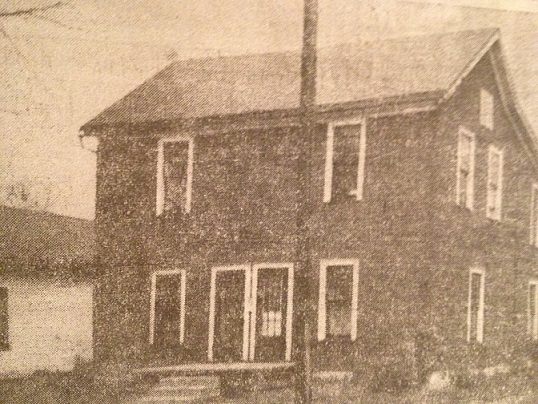
The James Dunn residence was either the first or second two-story house in Mt. Vernon. Originally it sat where the Eagles Home is today on Water Street facing the Ohio River. Built in 1825 it was occupied by the Dunn family until 1836. A frequent visitor there was Fanny Wright a philanthropist who lived in New Harmony and edited the paper, The Gazette and later The Free Enquirer. She was a lecturer on social problems and was an abolitionist. The house was moved in 1917 to the west side of College Avenue between Water and Second Streets. The weathered exterior was covered with brick siding. The picture provided is when it was on College. It was torn down in August of 1955 to make way for buildings of the Water Works.
Come On Over for Wool Pulling and Quilt Making.....1825
Can you really imagine the amount of work it took to be a pioneer? I don't think I can. Life would be so very hard. Getting up early, working late clearing land of heavy timber, building fences, plowing fields, feeding livestock, harvesting, canning, etc. The only part I would like would be sitting around a camp fire with a clay pipe talking about Henry Clay and Andy Jackson. Wives would bring out the hog jowls, fried eggs, turnip greens, corn bread, fried ham, biscuits, butter, and buttermilk. Later pies and maple molasses. Sleep with the dog next to a log watching the stars. ZZZZZZZZZ
Comet Seen.....1825
The earliest newspaper that exists in Posey County was the New Harmony Gazette which began operation on October 1, 1825. I got a chance to look at it today at the Workingman's Institute in New Harmony. That month a comet could be viewed with an unaided eye. The Gazette said, "For over a week now the comet has been visible and it is probable from the slow motion of this body, which does not exceed three degrees in twenty-four hours to be visible for some time. Its course is south, slightly inching to the west, thirty degrees to the horizon."
Rappite Wagon c1823
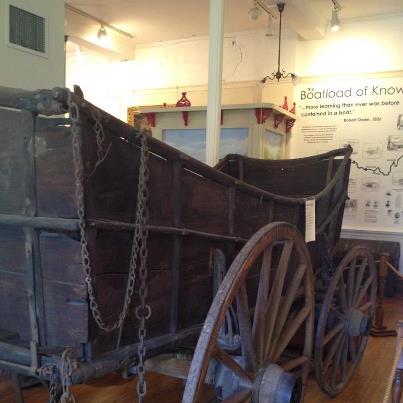
I believe this wagon rode all the way from Harmony Pennsylvania. It was used during the Centennial celebration of New Harmony in 1914.
A Letter From Shawneetown Mentions Mt. Vernon....Feb. 19,1821
The writer of the letter was Edward Sharland, and Englishmen born in in 1796 and died in Evansville in 1822. He had been in Evansville in an English settlement on the southeast section of Vanderburgh County. He was on his way to New Orleans when he wrote this letter. An educated man he was not all that impressed with Evansville as was his wife who was alienated by her surroundings. Work as a printer was hard to find and he was on his way south to sell Bibles and lost them all and his reserve of cash in a boat crash. He speaks of walking from Cynthiana to Mt. Vernon to catch a boat ride to Shawneetown, Illinois beginning his journey. In Cynthiana he had arrived at a cabin seven miles out of town where he got a good meal and comfortable lodging. At the peep of dawn he was out walking the nine miles to Springfield. He remained there just a short time and headed for Mt. Vernon another nine miles. "Never in my life had I suffered so much." he wrote. "The road being so flat and so soft that every step my feet sank four inches in the mire. The last five miles took three hours. "Finally he arrived in Mt. Vernon and found several boats just above the town. He took some refreshment and boarded one of them before sun down. He arrived at Shawneetown at dawn the next day. "In this route I have met with nothing particular enough to notice. Springfield is composed of a few log cabins, unfinished frames and a very near Court House, two thirds completed. Mount Vernon is beautifully seated on a very high bank, but its progress has been slow. Poor Edward never did find work like he hoped and returned to Evansville in a very weakened condition and died shortly thereafter and was buried in Oak Hill Cemetery in that city.
James Lafferty...Eccentric 1820's Justice of the Peace
It has been said that James ran to a fight between Nathan Overton and Allen Moutry back in the day and yelled at the top of his voice for the two gladiators to stop. "I command the peace; give him hell Nate. I will find you only $1 and pay half of it myself; give him hell; I command the peace!" As old age got him thinking about his mortality he requested that a post-mortem examination be held on his body so he might know what disease killed him......funny man!
1810's
"There's No Place Like Home; There's No Place Like Home".....1816
One of the early families here was the Robert Wilson family who came here from Pennsylvania. They made a little clearing, built a log cabin, fences and started to farm. It was said that one branch of this family came down by flat boat and landed at McFadden's Bluff and during that first night camping on the Ohio River's edge, one of their horses was lost Search as they might she was not found. Months later relatives said the horse returned home to Pennsylvania! Can you just imagine the hardships that animal had to endure to get home? A thousand miles of rivers and forests...amazing!
"Smoking Home Grown and Drinking Home Brew".....1815
Back when horses hitched to each other pulled grist mills distilling of liquors was very popular locally. They said the first building in what would become Mt. Vernon was a tavern. Money wasn't too plentiful and it was likely if you wanted a gallon of whisky you bartered a bushel of corn for it. I wonder what happened to these guys. About 1815, two human skeletons were discovered in the forest near Stewartsville. Near them was a jug of whisky. Their identity was never found, nor what happened to them. Did they die of exposure or violence or wild beasts while they slept it off? Indians would have taken the whisky right?
Bully Mike Fink Gets His.....1815 or so
Former Posey County historian, Vernon Posey, told of an incident related to the fighting at a local riverfront saloon. This "watering hole" was a hangout of sorts for boatmen, river pirates and gamblers. The saloon was primitive with the handmade chairs, tables and floor of sawdust. Dangling from a rafter in the center of the room were two large pair of antlers, interlocked, just as they had been found at Diamond Island years before. In came the legendary Mike Fink, 1780-1823, a 6'3" muscle man, known as the "King of the Keelboats." He was a man of great strength from pushing the boats up stream in the Ohio and Mississippi Rivers. He has become a man of legends. Davy Crockett once called him, "half horse and half alligator." Well, like many times before Fink came in looking for a fight or to make a dollar. They say he could drink a keg of beer and still shoot a scalp off a dead Indian. Raising hell in the saloon nobody stirred when ole Mike scoffed, jeered and ridiculed everyone inside trying to start something. "I can out jump, out shoot, out hop, and throw down and lick any man in the country," he boasted. Yes, Mike was still the meanest king of the river, even too mean for "Hoop-pole township." Mike curled his upper lip into a sneer and then the locked antlers fell! Fink fell to the sawdust and was out like a light. When he revived he slunk out through the open door and staggered down to the levee not saying a word.
1800's
Cave Robbers......1809
A longtime friend of my wife was over recently as they renew a friendship that started forty years ago, but for decades had been dormant because of a thousand miles distance between them. I asked her about her parents and their connection to Mt. Vernon. I am a little crazy about history as you know. She said legend has it that her father came to this area long ago and held horses for desperados near Cave-In-Rock, Illinois. Wow, there is a story if I could get it. I knew somewhere I had some information around my hobby room on Cave Robbers. Here was my chance to tie it in. I couldn't find all of it, but I did find that a one Jim Wilson, border desperado and river pirate found the cave (Cave-In-Rock) in 1809 and converted it into a rendezvous. Boatman descending the Ohio River were "enticed" to land and they were captured and forced to join his bandits or they would be killed. Many times they were accompanied to a place called Hurricane Island, and there murdered and their boats sent down to New Orleans and sold with the robbers pocketing the sale. A reward from Pittsburgh, Pa shippers was offered to find out what was going on with their boats and crew. A man named Waller and five others sought to find out. Waller and his men were pulled over by the bandits, like the others and forced to land. They escaped later and found Wilson's men on guard in a drunken stupor and Waller and his men bound them up in ropes. Then speeding upstream they warned the fleet then coming down the river. A expedition was formed from the fleet and they set off on land to capture Wilson. He was captured and tried to bribe the men with great wealth for his release. A search began and treasure was found and divided. When the fleet reached the cave a banquet was given in the hero's honor and a share of the treasure. The fleet went down to Hurricane Island with Waller taking his prisoners. A "ruse" pirate had hid upon the ship it was said and he was guarded. Pirates at the island opened up upon the ship, but no one was hit as the fleet boat men lay flat on the deck and the bullets whistled overhead. Finally Capt. Beachump gave the order to fire! The pirates were defeated; the mystery of missing crews and ships was solved. Wilson was killed and his head was cut off and his body buried. Waller and his men kept the severed head and arrived at a place called Maysville where the decomposing head of Jim Wilson was duly delivered to the proper authorities. The head was identified, and Waller's party went on to Pittsburgh to claim their reward, so worthily deserved.
The Soldiers of '76
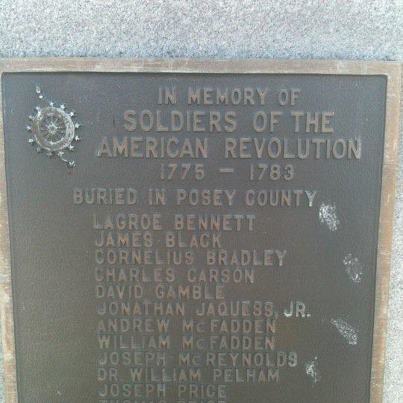
John Walker is buried near Stewartsville and was the first one in the county to be marked with Daughters of the Revolution marker. He served in the Revolution from South Carolina from 1775-1780 and was in the battles of Rocky Mountain, Hanging Rock, Black Stocks, E Springs, Snow Campaign, Florida Expedition, Biggins Church and Ramsons Mills. John Six lies on Maple Hill in New Harmony serving in the Pennsylvania Militia. He came to the Owen community in New Harmony along with his son in law. William Pelham, was a surgeon in the Virginia service and came to New Harmony in 1825. He died near Mt. Vernon on his farm in 1827. Jonathan Jaquess was born in New Jersey and was a "minuteman" and fought for five years. He died in 1841 and was buried in his orchard near Poseyville. Joseph McReynolds is buried in the Mt. Pleasant Cemetery. Joseph enlisted from North Carolina in 1778. Our distinguished judge, Herdis Clements is a descendant of the patriot. Thomas Price is buried at Bethsadia Cemetery born in Culpepper County, Virginia. He was wounded in the arm by an Indian arrow at the Lewis Battle. That battle was the final skirmish in Dunmore's War and took place at Point Pleasant on the Ohio about twenty miles above Cincinnati. The Shawnee chief, Cornstalk, was defeated by a company under Andrew Lewis in 1774. George Row is buried on a farm near Upton and serves as a lieutenant in the Pennsylvania Militia. It is said that George Row gave Mt. Vernon its name. Samuel Scott was known locally as "Daddy" and died in 1849. He had a military burial in the Templeton cemetery. Peter Anderson died in 1845 and buried in Griffin. Cornelius Bradley was from Maryland and my wife is his descendant as was Otis Allyn. David Gamble was in the Virginia Militia.

